Introduction
When it comes to implementing AI within your organization, choosing the right AI business consultant is a critical decision. It requires a thoughtful approach that begins with a comprehensive evaluation of your company’s specific needs. By analyzing your operational workflows, you can identify areas that can benefit from AI enhancements and envision the potential of AI to revolutionize your business practices.
The expertise of a skilled consultant can bridge the gap between your current challenges and future aspirations. Look for a consultant who understands AI technology and has experience applying it in your industry. They should have a track record of success in similar environments and be knowledgeable about the latest advancements and risks in AI.
Additionally, consider the value of a consultant who emphasizes knowledge transfer, equipping your team with the insights and tools necessary for sustainable progress. Ultimately, the right AI consultant can serve as a catalyst for innovation, improving operational efficiency, and giving you a competitive edge in the marketplace.
Understanding Your Business Needs
When starting the process of implementing AI within your organization, the choice of an AI expert is a crucial decision. It requires a thoughtful approach, starting with a comprehensive evaluation of your company’s specific needs. By critically analyzing your operational workflows, you can pinpoint areas that stand to benefit from AI enhancements. This process is not only about identifying gaps but envisioning the potential of AI to revolutionize your business practices. The expertise of a skilled professional is instrumental in bridging the gap between current challenges and future aspirations. Finding an expert who not only comprehends AI technology but additionally possesses extensive experience in implementing it within your specific industry can result in transformative results. Look for a partner who has demonstrated success in similar environments, such as those who have navigated the complex safety standards in regulated industries or who have shown an ability to dissect and rebuild corporate structures. In light of Ai’s swift progress, it’s equally important to select an expert who is knowledgeable about the most recent developments and mindful of the inherent dangers, such as algorithmic bias, guaranteeing their ability to steer you towards ethical and efficient AI solutions. Furthermore, take into account the importance of an expert who highlights knowledge transfer, equipping your team with the insights and tools essential for sustainable progress. Ultimately, the right AI expert will serve as a catalyst for innovation, guiding your organization towards enhanced operational efficiency and a competitive edge in the marketplace.
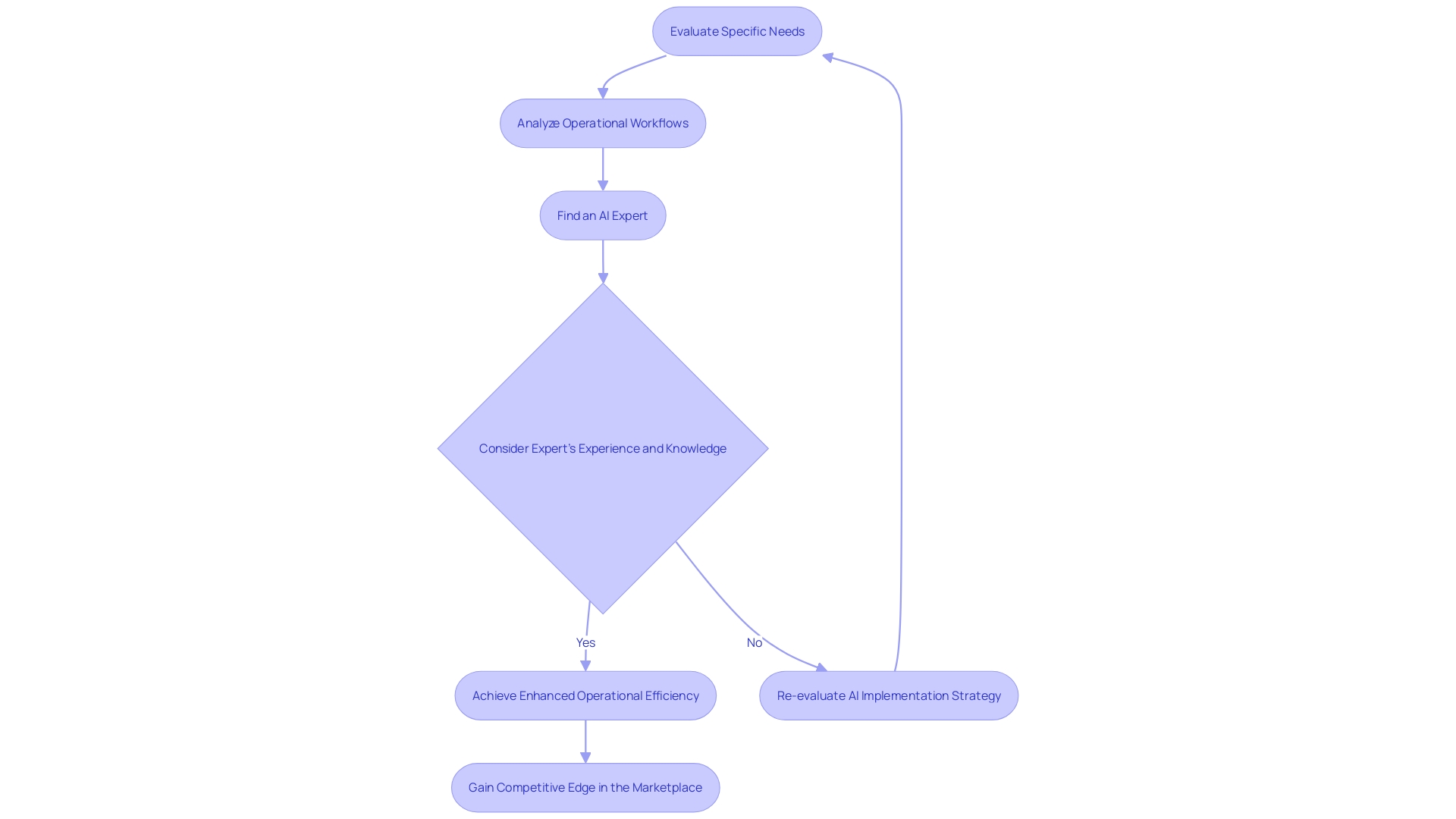
Defining Your AI Goals and Objectives
When contemplating the integration of AI technology into your organization, it’s crucial to start with a clear vision of your desired outcomes. Whether you aim to improve operational efficiency or deliver a superior customer experience, this clarity will guide your collaboration with an AI consultant, ensuring that your organization and AI strategies are perfectly aligned.
For instance, Holiday Extras, a leading European travel extras provider, faced the challenge of serving an international customer base, necessitating marketing materials in multiple languages and a data-driven approach that some less technical employees found challenging. By clearly understanding their objectives, they could leverage AI to address these scalability and data fluency issues.
Similarly, Leonardo Hotels aimed to elevate efficiency and guest satisfaction by automating and centralizing communications. With a distinct goal in mind, they were perfectly positioned to identify an AI solution that could optimize communication channels, automate responses, and enhance direct booking experiences.
In the quickly changing domain of AI, demonstrated by the exponential expansion of scholarly articles and tools like Science 4 Cast that forecast AI research patterns, companies must stay informed about the most recent progressions. This knowledge not only fuels innovation but also empowers companies to make informed decisions about their AI strategies.
The roadmap to AI success includes understanding the symbiosis between capturing and utilizing knowledge, with a focus on Use Cases, Early Wins, People, Technology, and Governance. As AI continues to drive innovation across various industry functions, companies like yours can harness its potential to remain competitive and fulfill the evolving needs of your customers and markets. By establishing a clear path and collaborating closely with an AI expert, you can successfully incorporate AI systems into your organization, guaranteeing they provide the essential liberties and adjustments needed to fulfill your specific needs.
Identifying the Right AI Business Consultant
Choosing the most appropriate AI expert goes beyond ticking off a set of requirements; it requires a tactical method that matches your particular objectives and obstacles. Successful entrepreneurs like Marty Fisher have demonstrated the importance of embracing technology early on to maintain a competitive edge. In your search, prioritize consultants who not only have a proven track record in your sector but also exhibit a deep understanding of its unique demands. Their ability to share relevant success stories and adapt to your data environment is crucial.
AI consulting is transforming the corporate scenery, providing even small and medium-sized enterprises affordable access to expert insights. For instance, platforms like Macky AI deliver on-demand AI expertise for critical business needs, from financial analysis to marketing strategies. As you navigate this transformation, assess the individual’s capability to communicate effectively and collaborate with your team, as these interpersonal skills are vital for integrating AI solutions seamlessly into your operations.
Moreover, consider the practical outcomes of the consulting engagement. An AI expert with expertise should offer not only strategies but additionally provide your team with the essential comprehension and tools for effective implementation. This approach often includes comprehensive training sessions and strategic documents to ensure that the solutions have a lasting impact.
In making your decision, heed the ‘Decision Triggers’ that can influence the success of your AI initiative. Whether your operations demand specialized models for data security or you seek quick market entry with generalized models, the appropriate expert will help you navigate these considerations. Remember, while AI can drive innovation and customer engagement, it requires careful selection and implementation to be effective. In fact, studies indicate that up to 70-80% of AI initiatives fail to meet objectives due to various challenges. Therefore, choose a consultant who will not only guide you through the AI landscape but also help you avoid common pitfalls and steer towards measurable success.
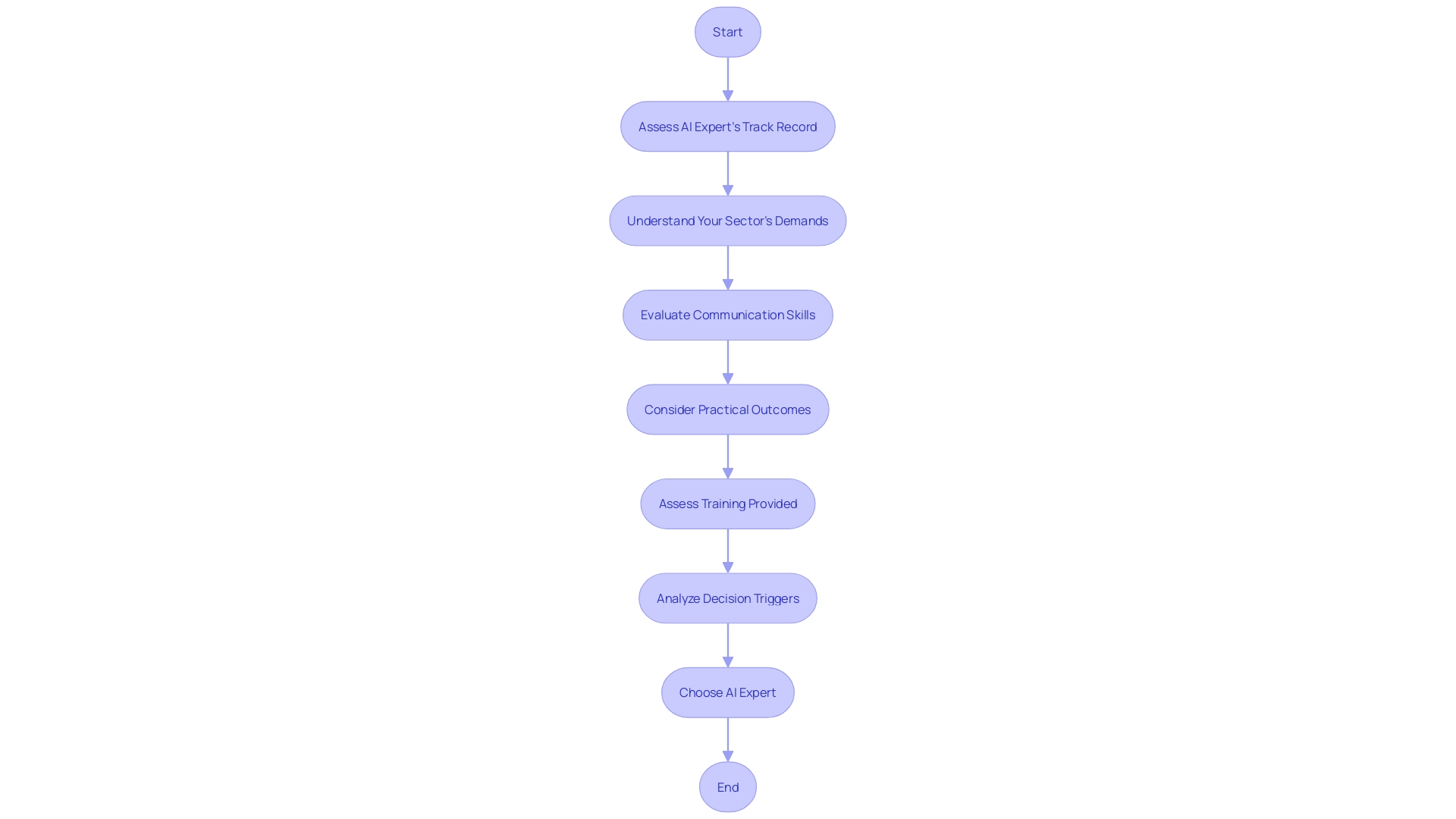
Evaluating AI Consulting Firms
Choosing an AI advisory company can be a strategic decision when navigating the intricate environment of artificial intelligence in the corporate world. These specialized firms bring together a variety of experts whose collective experience and knowledge can be invaluable. When selecting an AI partner, take into account their past performance and the range of their services. It’s not just about their reputation or client feedback; it’s about their ability to deliver tangible results in AI projects that are similar to what your company requires.
One such example of adaptation and success is the story of Marty Fisher, who embraced emerging technologies early in his career and has since maintained a competitive edge. Similarly, AI advisory companies that remain at the cutting edge of technological advancements, such as generative AI, can provide substantial advantages to your enterprise. Recent studies, such as Turing’s AI-accelerated software development study, have demonstrated how generative AI can boost developer productivity by an average of 25%, showcasing the potential of AI to enhance efficiency and spur innovation.
Moreover, these firms are well-versed in mitigating the potential biases of AI algorithms by rigorously vetting data sources and striving for transparency in their AI models, ensuring that the AI strategies implemented are reliable and fair. It’s important to look for firms that not only strategize but also transfer knowledge to your in-house team, empowering them with the necessary tools and understanding to carry forward the AI initiatives successfully.
Furthermore, advisory companies with a strong collection of prosperous AI implementations, similar to those that have catered to Fortune 500 enterprises and small enterprises alike, can offer perspectives and customized resolutions that resonate with your distinct organizational requirements. They can revolutionize back-office operations, streamlining administrative, financial, and HR processes that are vital to your company’s infrastructure and success.
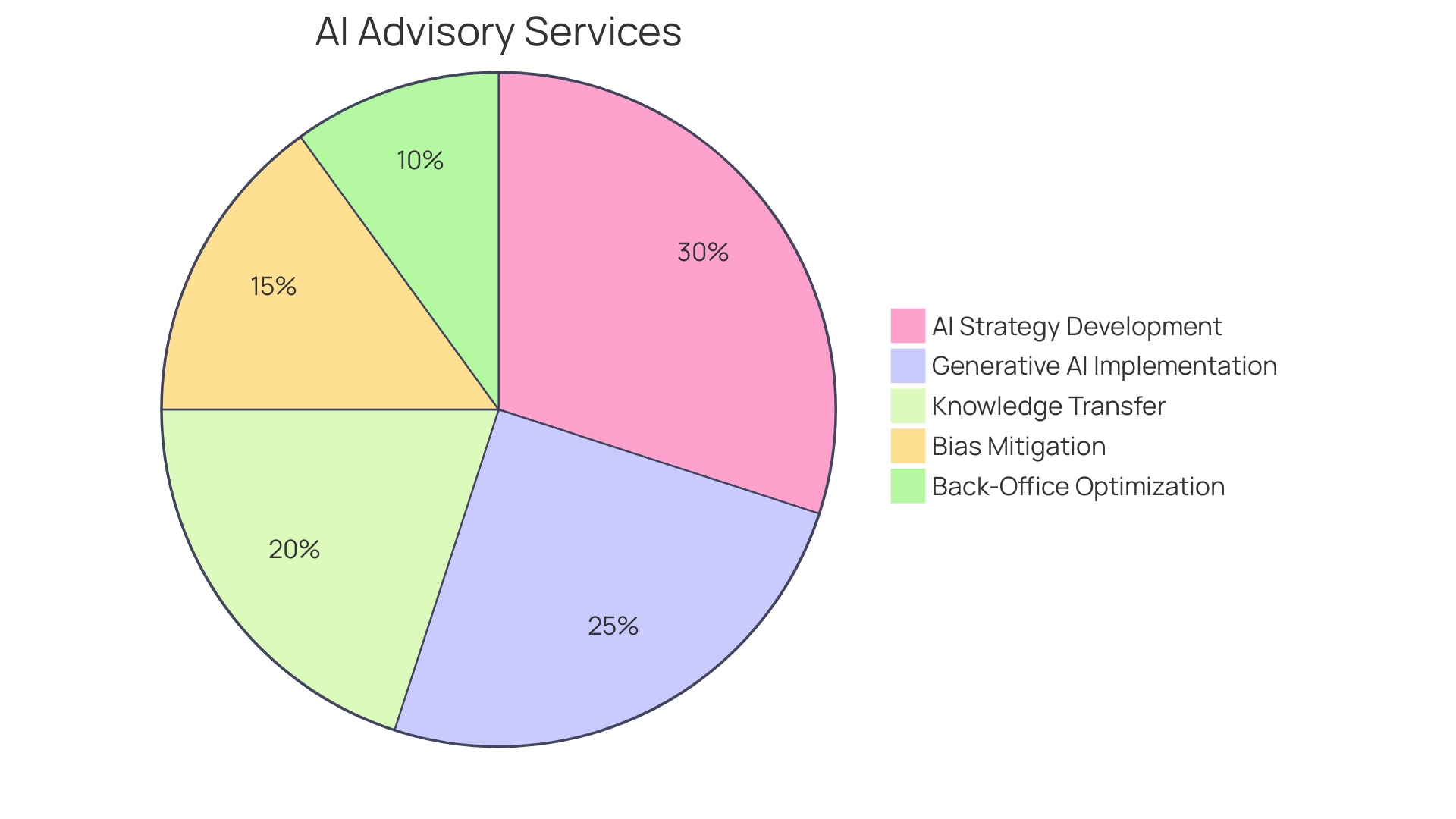
Key Considerations for Hiring an AI Consultant
Choosing the appropriate AI advisor demands a meticulous combination of proficiency and pragmatism. The perfect professional possesses not only a profound understanding of AI technologies and the intricacies of machine learning, data science, and AI ethics but also a genuine grasp of your organization’s unique challenges. They should exhibit a proven track record of translating complex business requirements into actionable AI strategies – a skill emphasized by industry experts who value real-world experience in procurement and supply chain management alongside technical proficiency.
Moreover, a proficient AI expert is one who remains committed to continuous learning, staying abreast of technological advancements and evolving market dynamics. As the consulting industry navigates through a period of technological disruption, spearheaded by AI, the ability to adapt and provide reliable, error-aware solutions is paramount. This includes a robust quality assurance process, ensuring that the AI-driven recommendations are as dependable as they are innovative.
A strategic AI professional will additionally focus on knowledge transfer, empowering your team with the understanding and tools necessary for sustained progress. They are prepared to participate in in-depth model development and data analysis while delivering client-facing presentations and workshops. In an ever-competitive landscape, where AI consulting services like Macky AI offer SMEs affordable access to expertise, the professional you choose should champion a collaborative approach, leveraging a diverse skill set that spans multiple disciplines.
In summary, search for an expert who is not just proficient in technology but also able to work hands-on, comprehends your organization thoroughly, and is prepared to offer you a range of choices, facilitating well-informed decision-making for your AI projects.
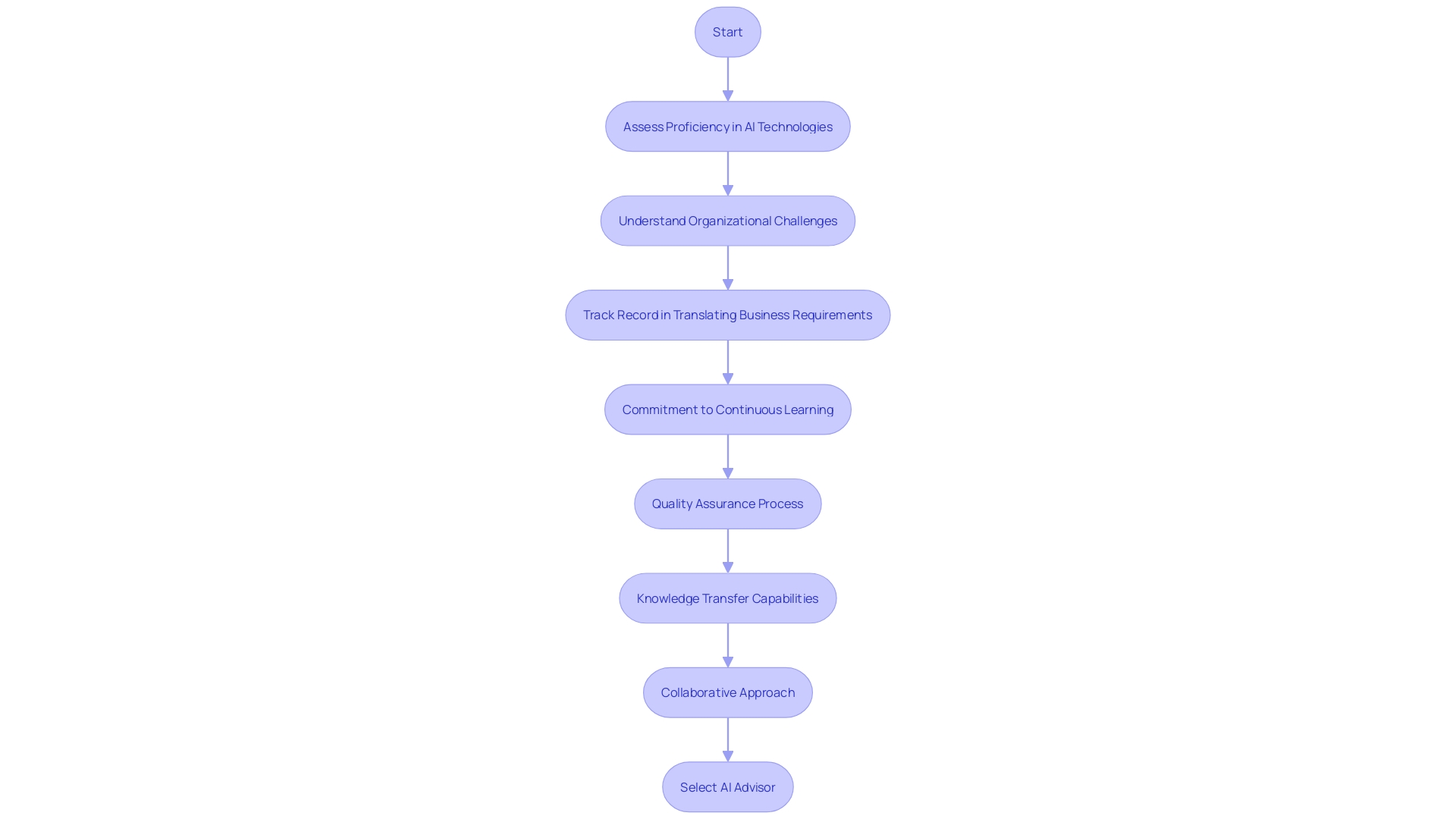
Steps to Hire an AI Consultant
Choosing the appropriate AI advisor can be a crucial choice for your organization. Start by identifying experts or firms with a history of embracing emerging technologies, much like Marty Fisher, who has thrived by staying ahead of tech trends. Examine their previous engagements closely, looking for case studies that reveal a proactive approach to technology and how they’ve navigated the evolving AI landscape, which is as dynamic as the California wildfire situation that necessitates stringent safety standards.
Next, get in contact with potential advisors to grasp their approach and how they might correspond with your objectives. Insist on detailed proposals that clearly outline their strategy, projected timelines, and cost structures. This will give you insight into their problem-solving capabilities and whether they’re reactive or proactive in their approach.
Assessing communication and collaborative skills is crucial, as the professional must mesh with your team. You may wish to consider a trial project to gauge their effectiveness in real-world scenarios. Reports such as those from the Center for Economic Studies can offer additional context, but the crucial aspect is locating an expert whose credentials and perspective on AI implementation align with your organizational objectives.
Macky AI, for example, has shown how AI can democratize access to advisory services for SMEs, providing concrete examples of Ai’s practical application in strategy. As you weigh your options, remember that both human and AI consultants can make errors; the goal is to select a consultant whose expertise and approach to AI will most benefit your company in this rapidly changing industry.
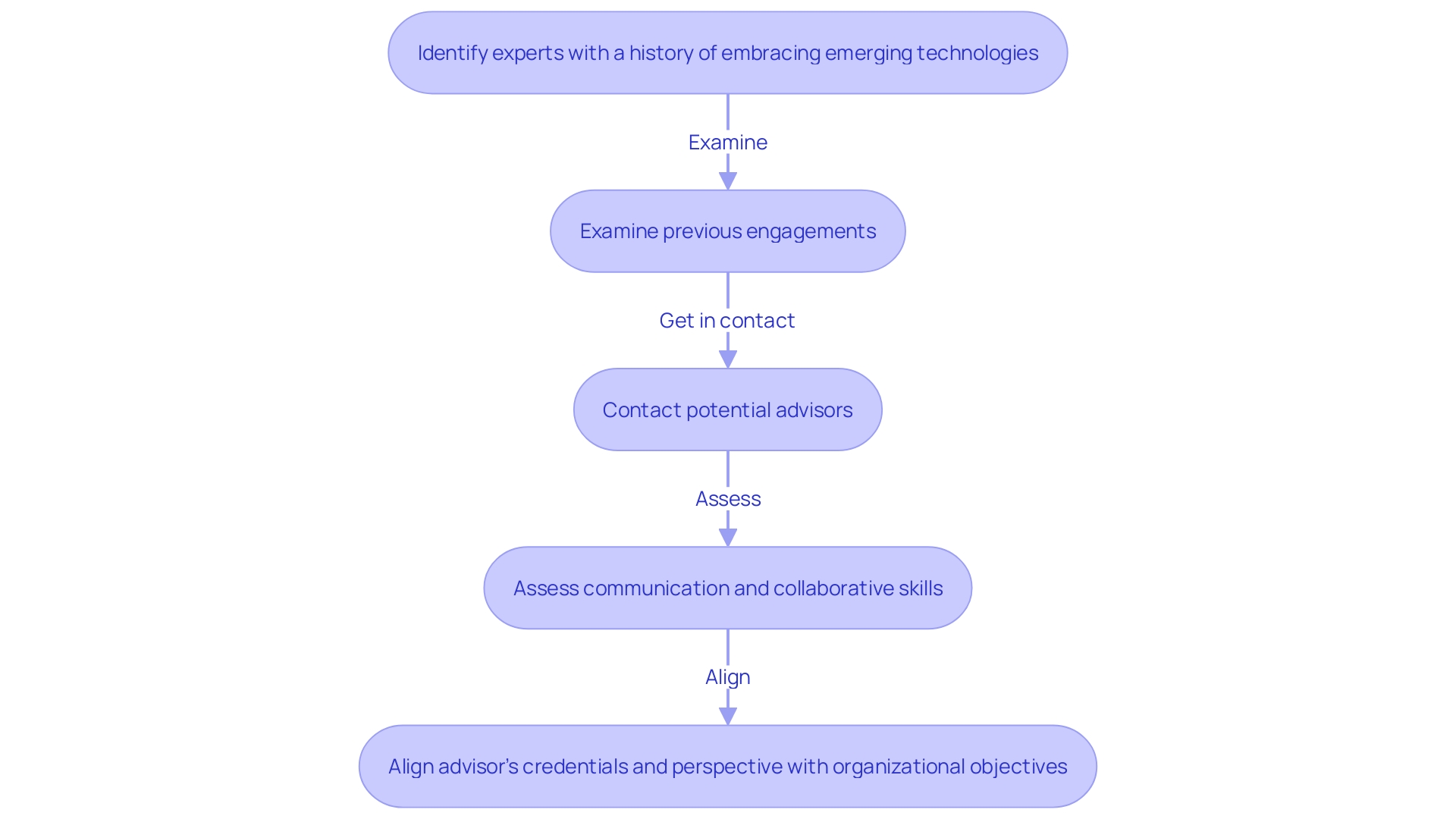
Benefits of Working with AI Consulting Firms
Engaging with AI consulting firms can greatly improve your operations by leveraging their extensive expertise and abundant resources. They bring a rich reservoir of knowledge, having worked across various sectors, and can impart valuable insights and best practices tailored to your unique needs. Moreover, these firms provide a dedicated team of AI professionals who offer continuous support and guidance, ensuring a smooth and effective AI implementation journey.
The transformative potential of AI in the corporate environment is undeniable, as it has the power to innovate and heighten customer interactions in previously unimaginable ways. In fact, generative AI has seen the highest adoption in marketing and sales at 34%, and in product or service development at 23%. These statistics underscore the critical role AI is playing in driving innovation across all business functions.
A standout case of embracing technology for competitive advantage is Marty Fisher’s early recognition of the Internet’s potential, which mirrors the current buzz around AI. This forward-thinking approach is evident in AI consultancy, which is rapidly redefining efficiency and technological capabilities. Knowledge workers in the field of expertise, who specialize in leveraging knowledge to advise clients and drive strategic decisions, are finding AI to be an invaluable asset in their toolkit.
Moreover, a crucial element of AI advising is the focus on knowledge transfer, guaranteeing that your in-house team is not only equipped with a strategy but also with the understanding and tools necessary for effective implementation. By means of training sessions, strategy documents, and best-practice guidelines, AI firms aim to empower your team with the know-how to sustain and build upon the AI solutions provided.
However, the adoption of AI comes with its own set of challenges, such as the potential for bias in algorithms, which can result in skewed recommendations and decisions. It is essential to vet the data sources that form the foundation of an AI system’s knowledge to ensure reliable outcomes. The significance of creating unbiased algorithms is just as crucial as their innovative capabilities, emphasizing the need for transparency and conscientious data selection in AI applications.
In essence, AI can revolutionize your back-office operations, introducing enhanced efficiency, precision, and innovation. By revolutionizing the core of your organization, encompassing administration, finance, human resources, and other internal procedures, AI advisory can result in enhanced operational efficiency, ultimately contributing to the overall triumph of your enterprise.

Common Challenges and How to Overcome Them
Incorporating AI into your company’s operations can be transformative, but it is not without its hurdles. Employees might initially resist the shift towards AI, concerned about data privacy and the intricacies involved. It’s fundamental to engage your team early on, emphasizing Ai’s advantages and how it can enhance their work rather than replace it. For instance, custom AI solutions, such as the chatbot developed for Benefit, a sizable energy firm, show how tailored AI can support and streamline internal processes.
Ensuring data security is paramount; it requires robust protections and adherence to regulations, which can be achieved by carefully selecting AI providers with a proven track record in both performance and data security. Especially, the intricacy of AI requires a distinct strategy aligned with your goals, which can be facilitated by AI consulting firms that offer the necessary infrastructure and continuous innovation to stay at the forefront of technology.
Moreover, user interviews play a vital role in user experience design, highlighting the importance of understanding the specific needs of those interacting with AI. This approach can inform the development of AI solutions that are both user-friendly and efficient, thereby mitigating resistance to change.
The rapid proliferation of AI research, with publications doubling roughly every two years, underscores the necessity for businesses to stay updated on the latest advancements and applications. Ai’s potential is vast, yet it must be harnessed strategically, ensuring alignment with your organization’s broader objectives for maximum impact.
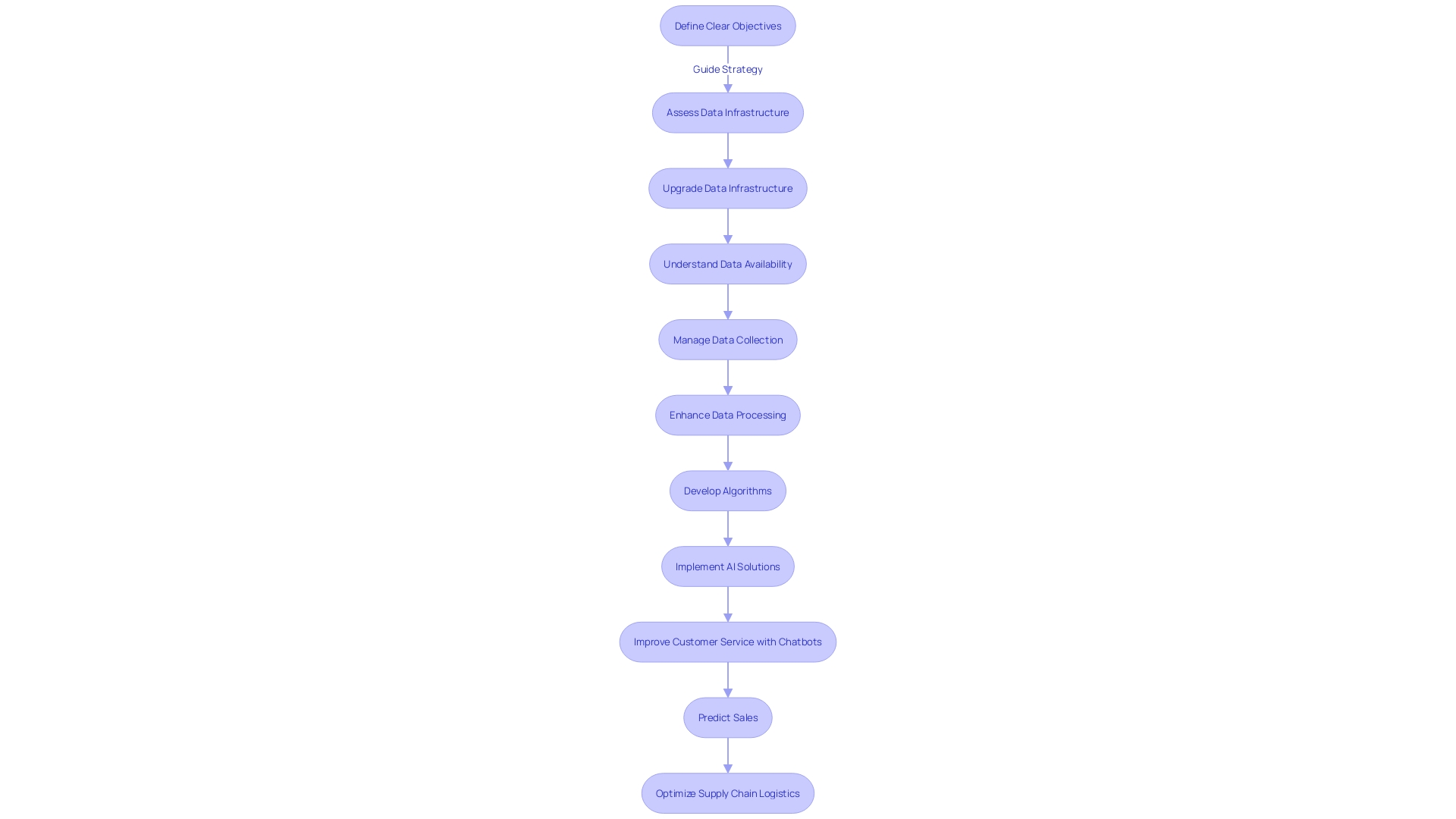
Conclusion
In conclusion, choosing the right AI business consultant is crucial for implementing AI within your organization. Look for a consultant with expertise in AI technology and experience in your industry. They should have a track record of success and be knowledgeable about the latest advancements and risks in AI.
A skilled AI consultant will emphasize knowledge transfer, equipping your team with the tools and insights needed for sustainable progress. They can serve as a catalyst for innovation, improving operational efficiency, and giving you a competitive edge.
When evaluating AI consulting firms, consider their track record, breadth of services, and ability to deliver tangible results. Look for firms that stay at the forefront of technological advances and prioritize mitigating biases in AI algorithms. Ensure they emphasize knowledge transfer and empower your in-house team.
Incorporating AI into your business operations can be transformative but comes with challenges. Overcome resistance by involving your team early on and highlighting the advantages of AI. Ensure data security by selecting proven AI providers.
Stay updated on the latest advancements in AI to harness its strategic potential.
In summary, choose an AI business consultant with expertise in your industry and a track record of success. Prioritize knowledge transfer and evaluate consulting firms based on their ability to deliver results. Overcome challenges by involving your team, ensuring data security, and staying informed.
By doing so, you can successfully integrate AI systems into your business and achieve measurable success.
Introduction
The adoption of artificial intelligence (AI) is revolutionizing the insurance industry, with automated claims processing at the forefront of this transformation. By implementing intelligent document processing (IDP), insurance companies can extract essential information from unstructured data, increasing efficiency and accuracy. The demand for fast claims processing is a top priority for customers, emphasizing the urgency for insurers to enhance response times.
Generative AI supports various tasks, improving the customer experience and expediting the claims process. The auto insurance sector recognizes the need to adopt automation technologies to remain relevant. The stages of automated claims processing are meticulously designed to maximize efficiency and accuracy, from claim intake and data extraction to settlement and payment.
Implementing automation requires strategic planning, selecting the right technology, and embracing a culture open to change. Integrating AI and machine learning into claims processing systems is crucial for insurers to stay competitive and responsive to customer demands. Security and compliance considerations are paramount in the implementation of automated claims processing.
Best practices for successful automation implementation include a comprehensive assessment of data sources, balancing strategic initiatives with lean process automation, and investing in InsurTech solutions. The successful integration of automated claims processing relies on understanding the technology, strategic planning, and adapting processes to meet customer and industry needs.
Benefits of Automated Claims Processing
The adoption of artificial intelligence (AI) is transforming the coverage landscape, with automated claims processing at the heart of this change. By implementing intelligent document processing (IDP), entities in the insurance sector such as Commercial P& C Carriers, Reinsurance Carriers, and Life Insurance Carriers are harnessing the power of AI to extract pertinent details from unstructured information, propelling efficiency and accuracy to new heights. With approximately 85% of insurance enterprise data being unstructured, the ability to manage this data rapidly and reliably is no longer a choice but a necessity to maintain a competitive edge.
AI-driven claims automation not only fulfills user expectations for prompt handling of insurance requests but also addresses insurers’ operational requirements. A survey by Sollers Consulting and Ipsos suggests that efficient processing of insurance requests is a primary concern for 52% to 63% of customers in different countries, emphasizing the need for insurers to improve their response times. As reported by Kassandra Jimenez-Sanchez, the demand for rapid claims resolution is most pronounced in the UK at 63%, signaling a clear directive for insurers to accelerate their digital transformation efforts.
The impact of generative AI on the insurance industry is evident. It supports a variety of tasks, from searching and summarizing information to extracting key insights, thereby enhancing the experience during critical touchpoints such as the First Notice of Loss intake. This not only expedites the claims process but also ensures a more seamless interaction for the customer.
In the face of rising costs and shifting consumer behaviors, the auto coverage sector acknowledges the imperative to adopt automation technologies to remain relevant. As Bill Brower notes, the time for action is now; embracing automation is essential for future-proofing and staying ahead in an increasingly tech-driven environment. With the majority of financial services and leaders in the insurance sector acknowledging the initiation of AI proofs of concept, yet only 36% employing them extensively across business functions, the journey towards full AI integration continues. This continuous development ensures to redefine the insurance industry, delivering unmatched efficiency and satisfaction.
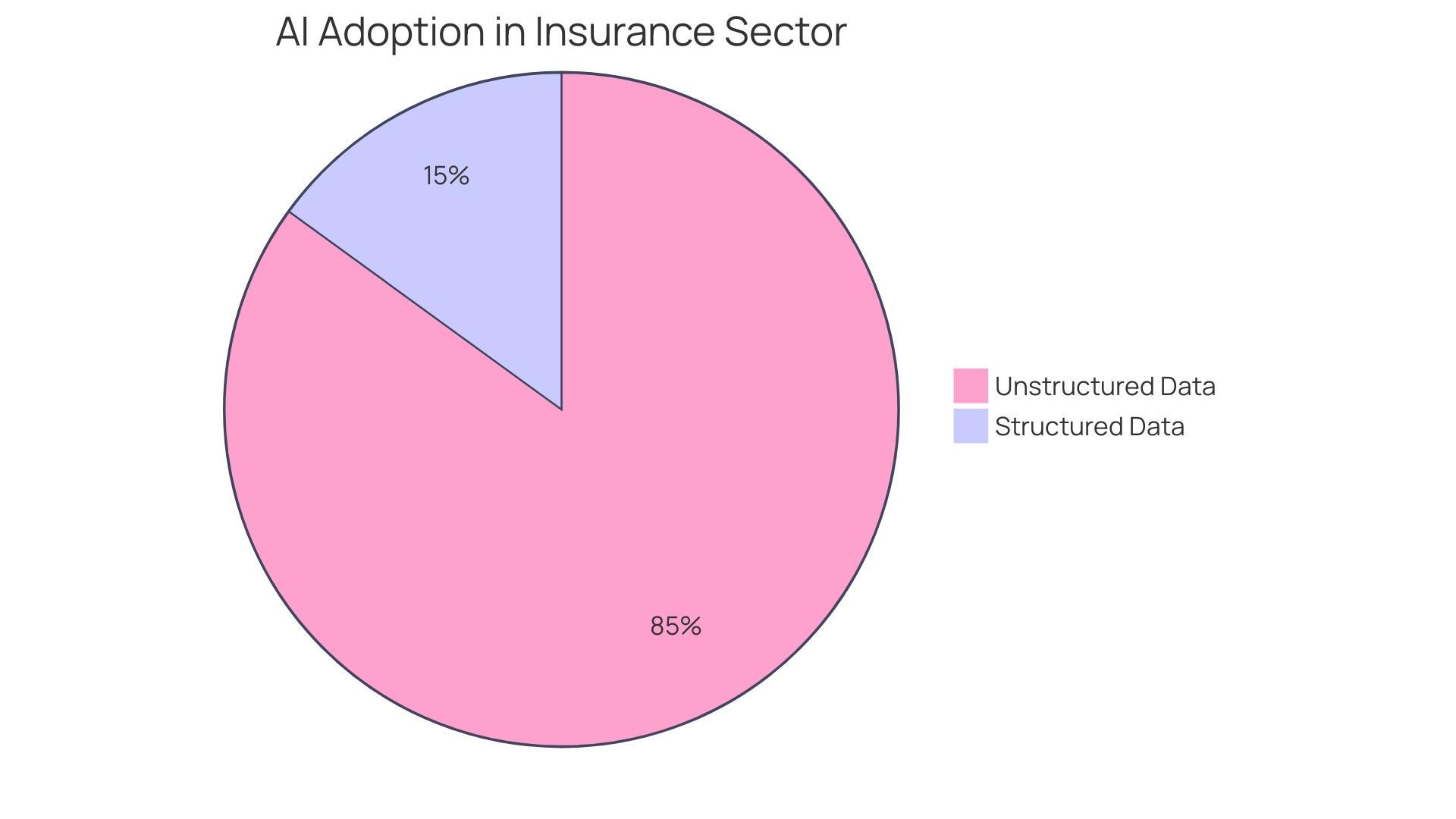
Key Technologies in Automated Claims Processing
Insurance companies are adopting advanced technologies to enhance the efficiency of processing claims, which is a fundamental aspect of ensuring client satisfaction. Generative Artificial Intelligence (Gen AI) is transforming the way insurers manage claims by automating the assessment of policy coverage, expediting the First Notice of Loss, and enhancing the extraction of insights from information. This technology helps in identifying missing information, summarizing key points, and clarifying areas that require attention, thereby enhancing the customer experience.
Moreover, Intelligent Document Processing (IDP) has emerged as a transformative tool, especially in managing the overwhelming amount of unstructured data within the industry. This technology provides insurers with the capability to quickly retrieve and handle information from documents, which are vital for efficient management of insurance requests. The shift to digital channels has reinforced the need for such tools that balance speed and accuracy in the underwriting process, ultimately leading to improved operational efficiency.
The importance of embracing these technologies is emphasized by recent discoveries from Sollers Consulting and Ipsos, which show that a prompt reimbursement procedure is a leading anticipation among clients. This is particularly true in regions like the UK, where rapid claims handling is a critical factor for customer satisfaction, even more so than the compensation amount.
To capitalize on these advancements, insurers are actively pursuing AI proofs of concept, with a significant number already witnessing tangible benefits. However, the journey to widespread adoption is not without challenges. Despite the optimism, only a fraction of leaders report extensive application of AI across their business functions, indicating that many are still exploring how to fully leverage AI’s potential.
The commitment to technological enhancement in the sector of risk coverage is evident in the words of industry leaders, emphasizing the importance of a fail-fast approach and the continuous evolution of digital capabilities to improve the experience of processing. As the industry progresses, it is becoming increasingly clear that insurers must decide whether to lead or follow in this digital transformation.
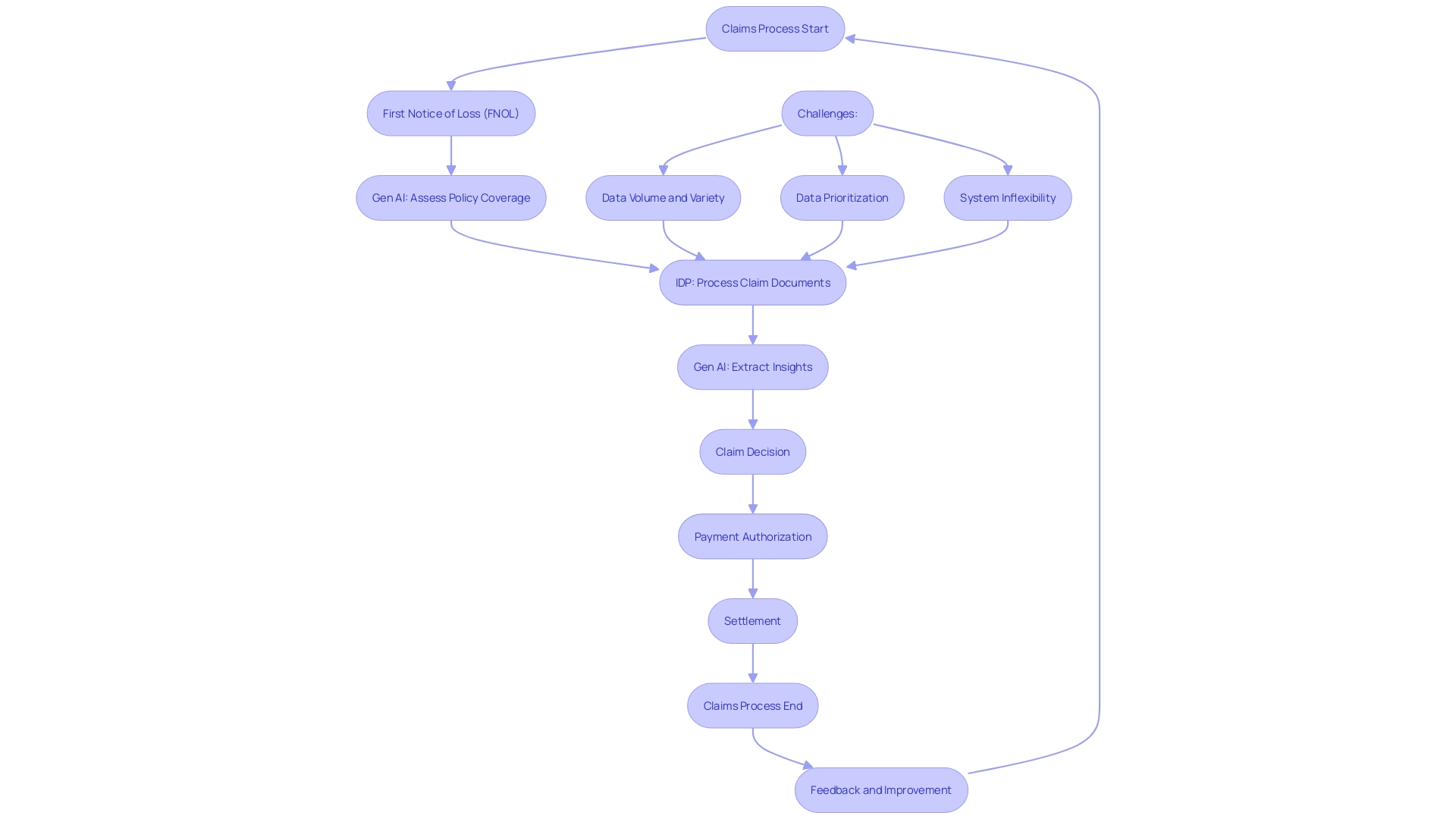
Stages of Automated Claims Processing
The evolution of automated claims processing has been a game-changer in the insurance industry, transforming the way disputes are managed from initial intake through to settlement. At the heart of this innovation is the deployment of Generative Artificial Intelligence (GenAI), which has empowered providers to streamline complex tasks, including the creation and management of medical visit notes. For instance, pediatric care provider Summer Health has leveraged AI to simplify the traditionally time-consuming process of translating medical shorthand into comprehensive summaries, thereby reducing the administrative burden on physicians and enhancing the clarity of communication for parents.
As we break down the stages of automated claims processing, it’s evident that these are meticulously designed to create a seamless workflow. Starting with the First Notice of Loss, AI assists in evaluating policy coverage and identifying any gaps in claim data. It summarizes key points and clarifies areas that require attention, thereby enriching the client experience in an era where expectations are soaring and costs are mounting.
Moreover, the technology is pivotal in denial management. When insurers refuse to reimburse providers based on the patient’s coverage, AI steps in, allowing for the meticulous review and resolution of denials. This not only addresses the immediate issue but also aids in formulating preventive measures to forestall future denials. Such strategic approaches are enhanced by AI-driven software, which automates the tracking and appeals process, a technique that has proven to be highly effective.
The impact of GenAI is not limited to customer interactions. It also provides a backbone for accurate financial reporting, crucial for both internal analysis and regulatory compliance. A poorly conceived Record to Report (R2R) process can lead to unreliable financial statements, undermining the trust of stakeholders. However, AI ensures a robust R2R process, safeguarding the organization’s reputation and financial integrity.
Statistics underscore the potential of AI in healthcare, with large language models (LLMs) offering solutions for everything from clinical decision support to the reduction of administrative costs, which are notably higher in the U.S. healthcare system compared to other countries. The sector of coverage, specifically property and casualty, has been an early adopter of this technology, with studies showing that although 91% of financial service and insurance leaders have initiated AI projects, a mere 36% have integrated these tools across various business functions. Nevertheless, the quest to harness Ai’s full potential continues, with 70% of companies actively exploring ways to capitalize on its benefits.
In conclusion, the automated processing of requests journey is characterized by a sequence of stages, each designed to optimize efficiency and accuracy. Through the strategic application of GenAI, the industry is not only reshaping its internal processes but also delivering a level of service that meets the modern-day expectations of both providers and clients.
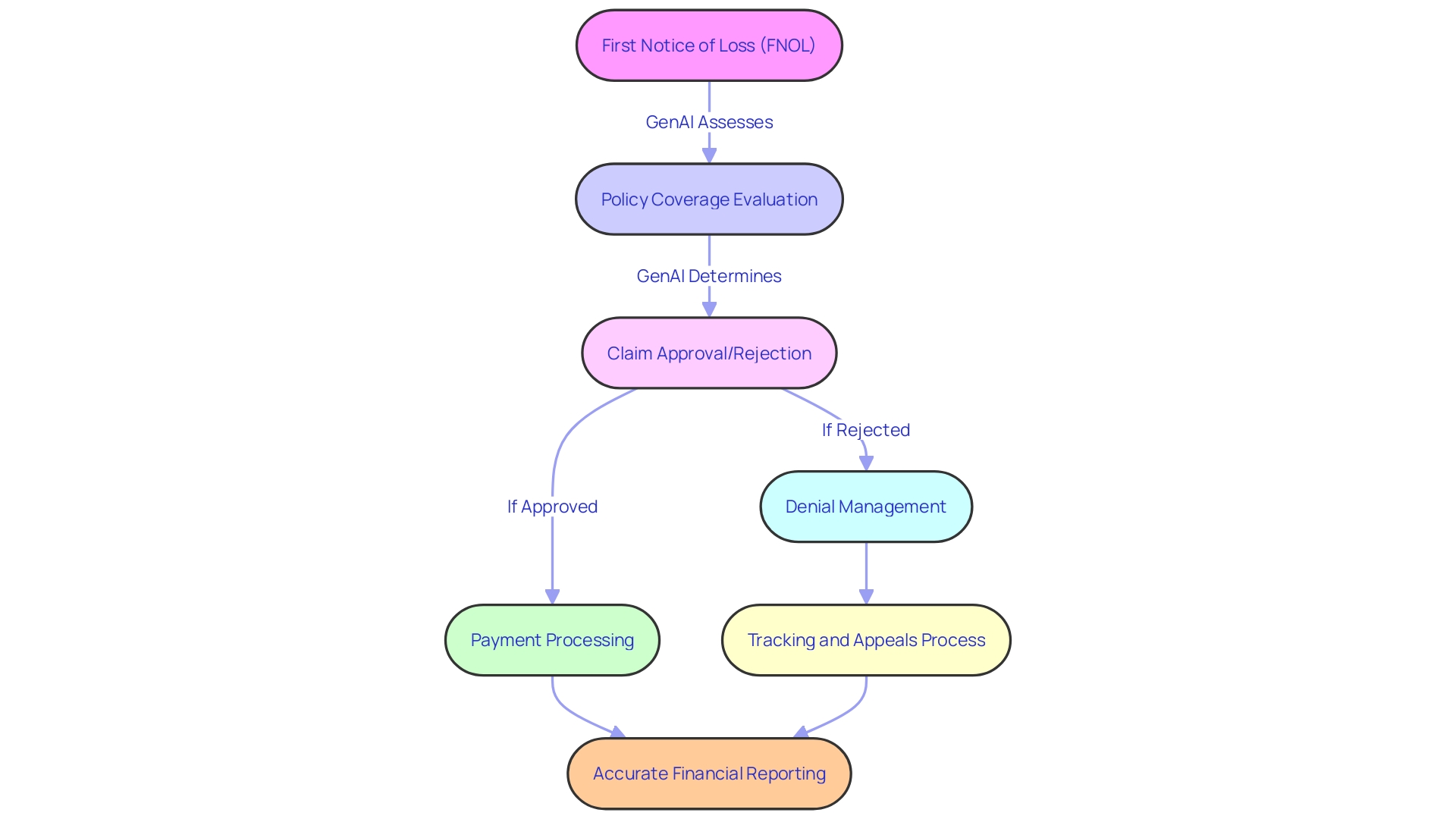
Step 1: Claim Intake and Data Extraction
Beginning the process of automated processing for insurance claims starts with the crucial task of information intake and extraction. This crucial first step is all about gathering the claim details from a plethora of sources, which may range from structured legacy information such as tables containing claims information and billing details, to more modern formats like JSON files that hold policy and product details. The technology that’s truly transforming this stage is Intelligent Document Processing (IDP), which excels in handling the vast majority of information that tends to be unstructured—think emails, forms, and incident reports.
IDP doesn’t simply gather information; it identifies and extracts the valuable nuggets of knowledge that are often concealed within the text. For example, it carefully identifies policyholder information, intricacies of the incident in question, and any relevant documentation required for further processing. The power of IDP is evident in its ability to provide swift access to data while maintaining high accuracy standards, a balance that has been historically challenging to strike in the insurance sector.
This technology, driven by advancements in artificial intelligence such as large language models (LLMs), has proven its worth by offering a variety of enhancements to the process of asserting ownership. LLMs are particularly adept at generating, classifying, and summarizing information, which can elevate the customer experience by streamlining the initial notice of loss intake and ensuring that all relevant information is captured and highlighted for further action. The utilization of these AI-driven solutions is becoming increasingly widespread, as they guarantee not only to expedite the process of claims but also to enhance it, offering a competitive edge in an industry where timely and accurate information analysis is paramount.

Step 2: Claim Validation and Verification
By incorporating advanced AI algorithms, the process of insurance claims is transformed into a more efficient and secure operation. After extracting data, it’s crucial to validate and authenticate the information meticulously. In this crucial phase, there is a comprehensive evaluation of the existing policy particulars, prior records, and a variety of pertinent databases to guarantee absolute precision. The advanced AI technology explores patterns in claims, revealing any irregularities that could indicate potential fraudulent activity, thereby protecting the integrity of the process. Moreover, the integration of visual information, like pictures of events such as fires, aids adjusters in precisely evaluating harm and validating assertions, which simplifies the process of making decisions. This modern approach to insurance claims processing not only accelerates the underwriting and handling but also enhances consumer protection and satisfaction by providing a more personalized experience. As the industry continues to evolve, the adoption of AI and data analytics stands as a testament to the sector’s commitment to innovation and excellence in client service.
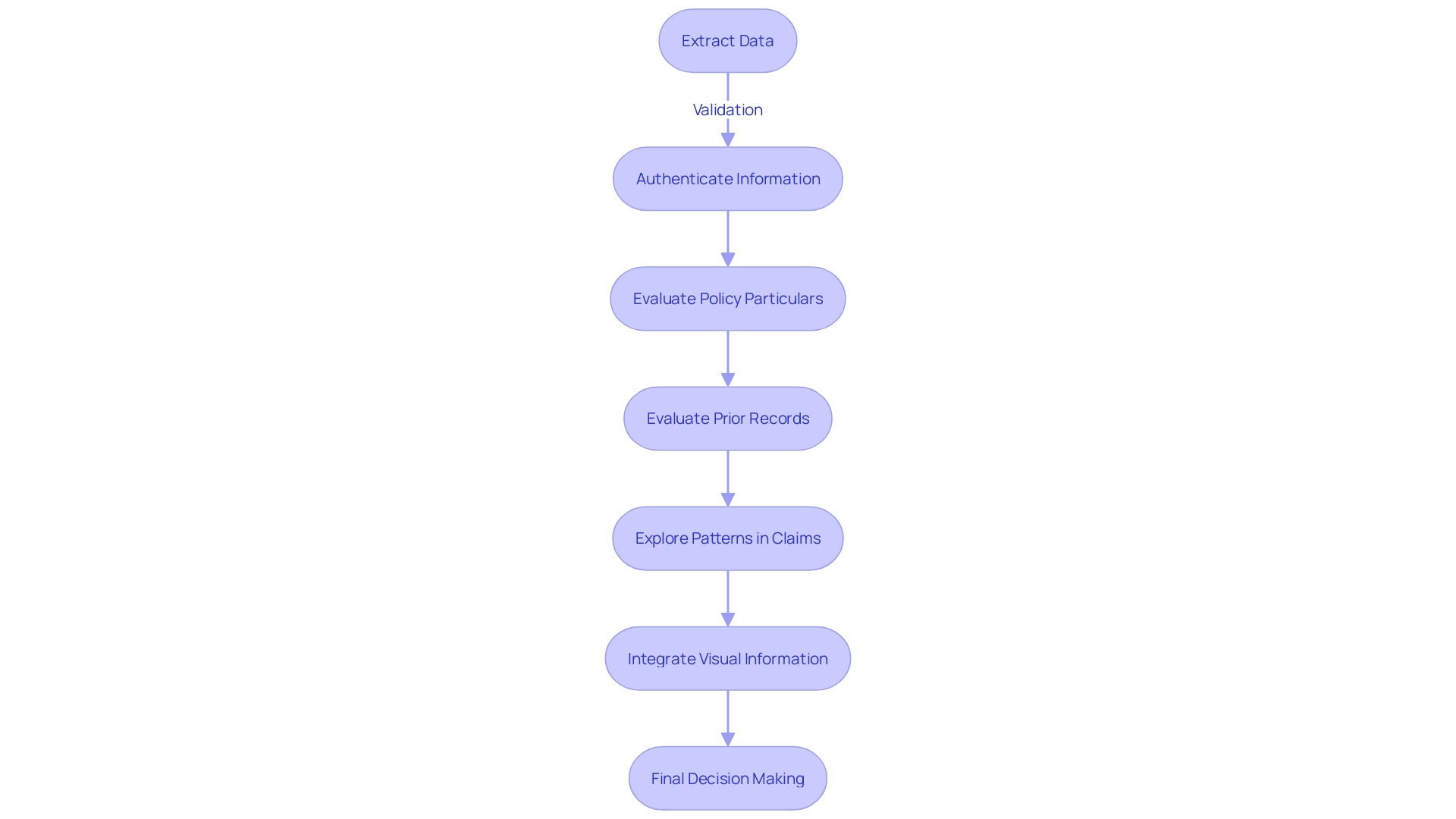
Step 3: Claim Investigation and Evaluation
As the landscape of insurance processing evolves, artificial intelligence (AI) is playing a pivotal role in revolutionizing this domain. Throughout the investigation and evaluation phase of a case, AI is not only a means for efficiency but a revolutionary power, reshaping the approach insurers adopt toward claims handling. By leveraging Ai’s capacity to meticulously analyze claim details and assess the extent of damage or loss, the technology is ensuring a more accurate and swift validation of claims. Ai’s capability extends beyond mere analysis; it is adept at collecting and synthesizing additional data, whether it’s accident reports or medical records, to bolster the evaluation process. This use of AI is in line with the broader industry trend where, despite some skepticism, companies are witnessing tangible benefits from AI adoption. With a significant percentage of financial services and insurance leaders confirming the launch of AI proofs of concept, the industry is increasingly recognizing the value of AI in enhancing operational efficiency and combating fraud. This shift is evident as insurers seek to transition from traditional, labor-intensive evaluation of insurance requests to more sophisticated, automated systems. By doing so, they are not only streamlining processes but are also aligning with regulatory frameworks that mandate the proper use of AI, avoiding unfair practices and ensuring the protection of consumer data. The dedication to integrating AI in the processing of insurance requests reflects the general acceptance of technology in the industry for enhanced customer satisfaction and operational efficiency.
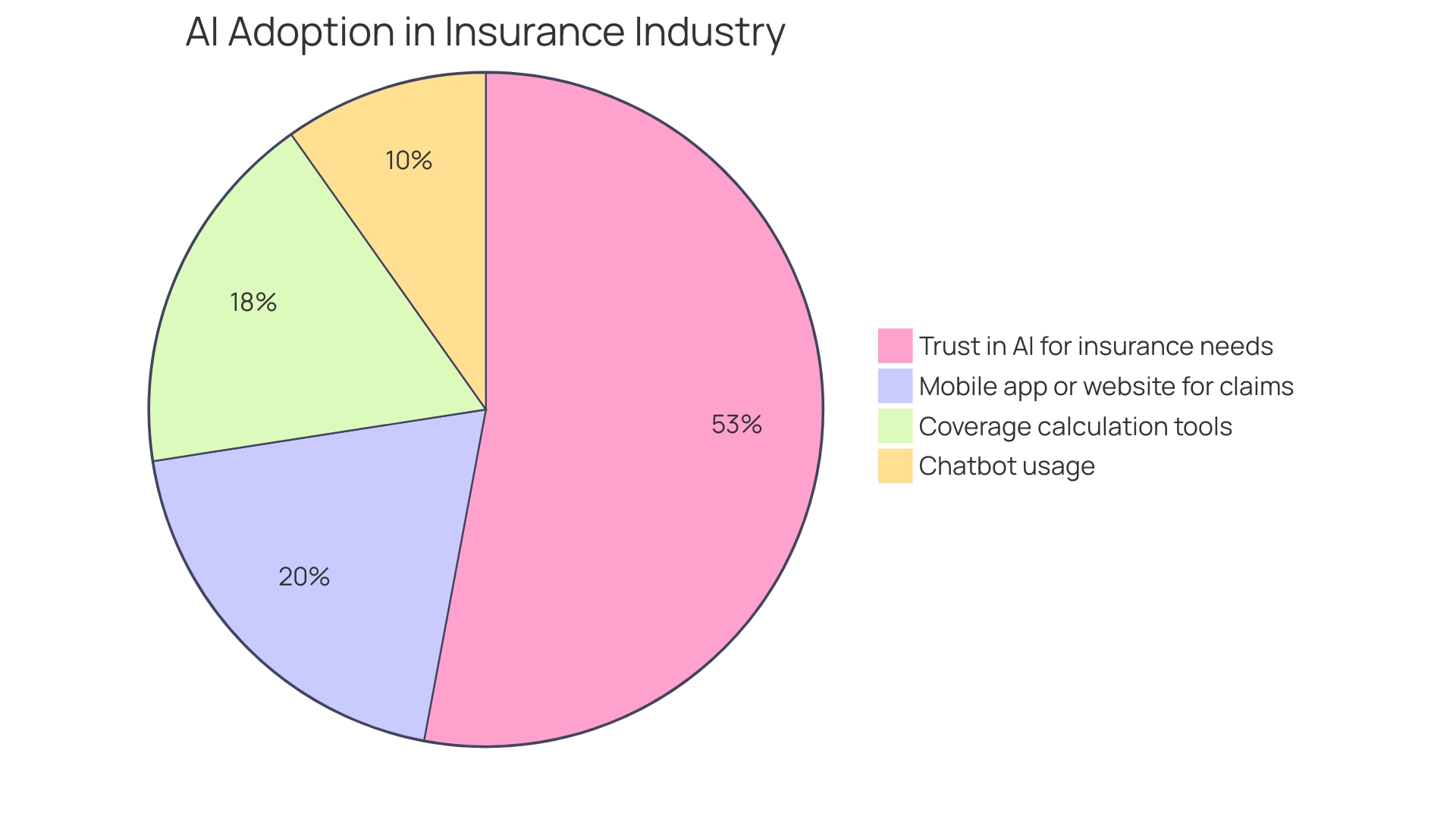
Step 4: Claim Settlement and Payment
The arrival of generative artificial intelligence (GenAI) has ushered in a transformative era in various industries, and the sector of coverage is no exception. As the settlement and payment stage of coverage cases becomes more complex, AI-driven systems are capable of determining suitable settlement amounts with remarkable accuracy. These systems are programmed with an intricate understanding of policies and regulations, ensuring that the offers generated align with the predefined criteria.
A testament to the efficiency of AI applications is the fact that property/casualty insurers, early adopters of GenAI, are witnessing tangible benefits from its implementation. Despite the initial skepticism surrounding AI, these insurers are now leveraging automated systems that not only generate settlement offers but also execute payment transactions seamlessly, providing policyholders with prompt and transparent updates.
This movement towards AI-powered management of insurance cases reflects a wider pattern within the financial services and insurance sectors. While 91% of leaders in these sectors have kicked off AI initiatives, only 36% have implemented them extensively across various business functions. Still, the push towards AI is undeniable, as 70% of companies remain intent on unlocking Ai’s advantages, a journey marked by strategic deployment and adherence to regulatory guidelines like those issued by New York’s Department of Financial Services.
The process of incorporating AI into the handling of insurance requests is a intricate one, requiring a transparent moral structure and a readiness to adopt a ‘fail-fast’ method for ongoing enhancement. As insurers navigate this path, they are setting a precedent for operational excellence, driven by a commitment to improving client experiences and streamlining internal processes.
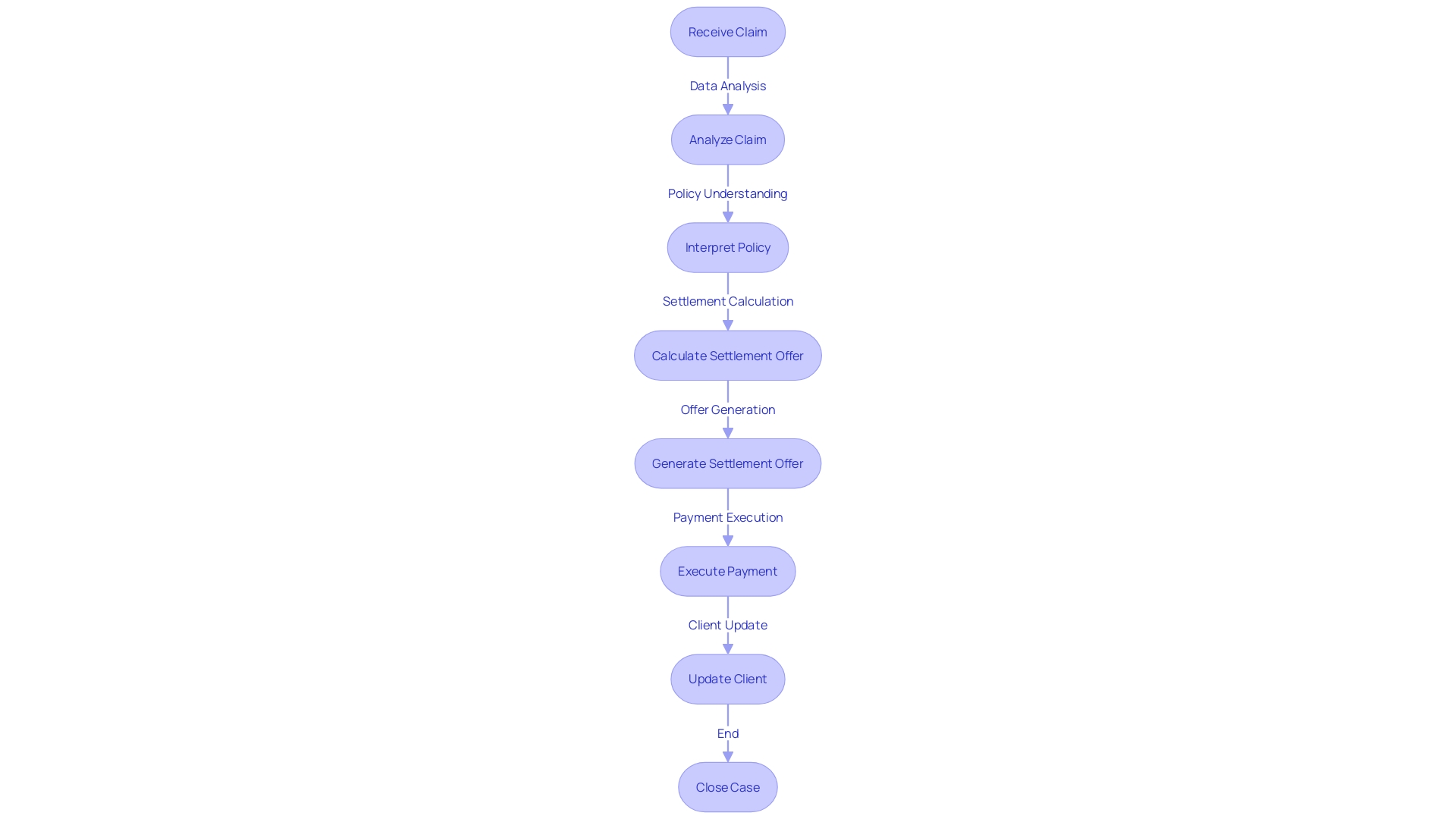
Implementing Automation in Claims Processing
Implementing automation in the domain of processing claims not only streamlines operations but also significantly enhances client satisfaction. The integration of artificial intelligence (AI) and machine learning (ML) into management of insurance cases is transforming how insurers interact with customers and handle their internal processes. For instance, think about the situation where an insurance company uses a single email address to gather requests. Before, a manual assessment was required to direct each request to the suitable department, which was not just time-consuming but also susceptible to mistakes. To address this, Frende Forsikring leveraged AI to automatically direct claims to the relevant management unit, achieving remarkable accuracy and efficiency.
Furthermore, the sector for coverage is ready for a dynamic shift as an estimated 50% of its workforce approaches retirement by 2028. This opens doors for a new generation of professionals who can bring fresh perspectives, especially in the utilization of contact center and technology capabilities that are critical for strategic growth, cost management, and compliance.
As for the implementation of such automation, it’s instructive to recognize that the underwriting process, traditionally known for its meticulous nature, is being transformed by automation to increase productivity and reduce error rates. Gen AI, specifically, acts as a potent tool for companies in the insurance sector, enhancing the experience of clients during the First Notification of Loss intake by improving policy coverage evaluations and streamlining data processing.
Industry leaders, like Lee Elliston from the Aspen Group, highlight the significance of digital capabilities throughout the claims ecosystem to meet policy promises and keep satisfaction levels high. Meanwhile, studies reveal that while 91% of financial services and insurance leaders have initiated AI projects, only 36% have implemented them broadly, indicating a significant opportunity for wider application to harness AI’s full potential.
In practice, companies like Alm. Brand Group are partnering with firms like Cognizant to automate manual and repetitive processes, thereby boosting efficiency and competitive edge. Such strategic collaborations are vital as they provide a clearer vision and ethical framework for AI use, ensuring that digital tools are leveraged transparently and effectively for the benefit of individuals and employees alike.
To summarize, the effective implementation of processing automation relies on strategic planning, choosing the appropriate technology, and embracing a culture that is open to change. With the correct approach, companies can not only improve operational efficiency but also enhance the customer experience, ensuring that they are well-positioned for the future of the industry.
Essential Integrations for Automated Claims Processing
The domain of handling insurance claims is being revolutionized by artificial intelligence (AI) and machine learning (ML), offering unparalleled efficiency in processing and managing claims. For example, the Norwegian company Frende Forsikring optimized its email-based reporting of claims by utilizing AI to accurately direct claims to the relevant management unit, eliminating the necessity for laborious manual sorting. Incorporating such intelligent systems requires careful planning, particularly when considering the projected workforce changes with a substantial portion set to retire by 2028, opening opportunities for fresh talent in the industry.
AI’s role in claims processing extends to improving client satisfaction by expediting claims management, a point emphasized by Swiss Re, a global leader in reinsurance and risk management. Their approach to embracing innovative technologies is a testament to the industry’s shift towards more resilient and forward-thinking operations.
Furthermore, the sector’s move to digital, automated procedures represents a notable change towards operational effectiveness and enhanced client encounters. Automation empowers insurers to meet the rising expectations for accessible, customer-focused services. This shift is not just a technological upgrade but a broader change in how insurance companies align with client needs.
To fully utilize the potential of automated processing of insurance requests, insurers must take into account their data processing needs, whether they are managing structured or unstructured data, and the amount and frequency of such data. Focusing on documents that usually necessitate extensive manual processing, such as invoices and forms, for automation can result in significant gains in efficiency and cost savings.
As the sector keeps progressing, the incorporation of AI and ML into processing systems for insurance demands is not just an improvement but a crucial element for insurers to stay competitive and responsive to the needs of their clients. The insights from industry thought leaders and case studies underscore the importance of adopting and integrating these technologies to streamline workflows, improve accuracy, and deliver a superior experience.
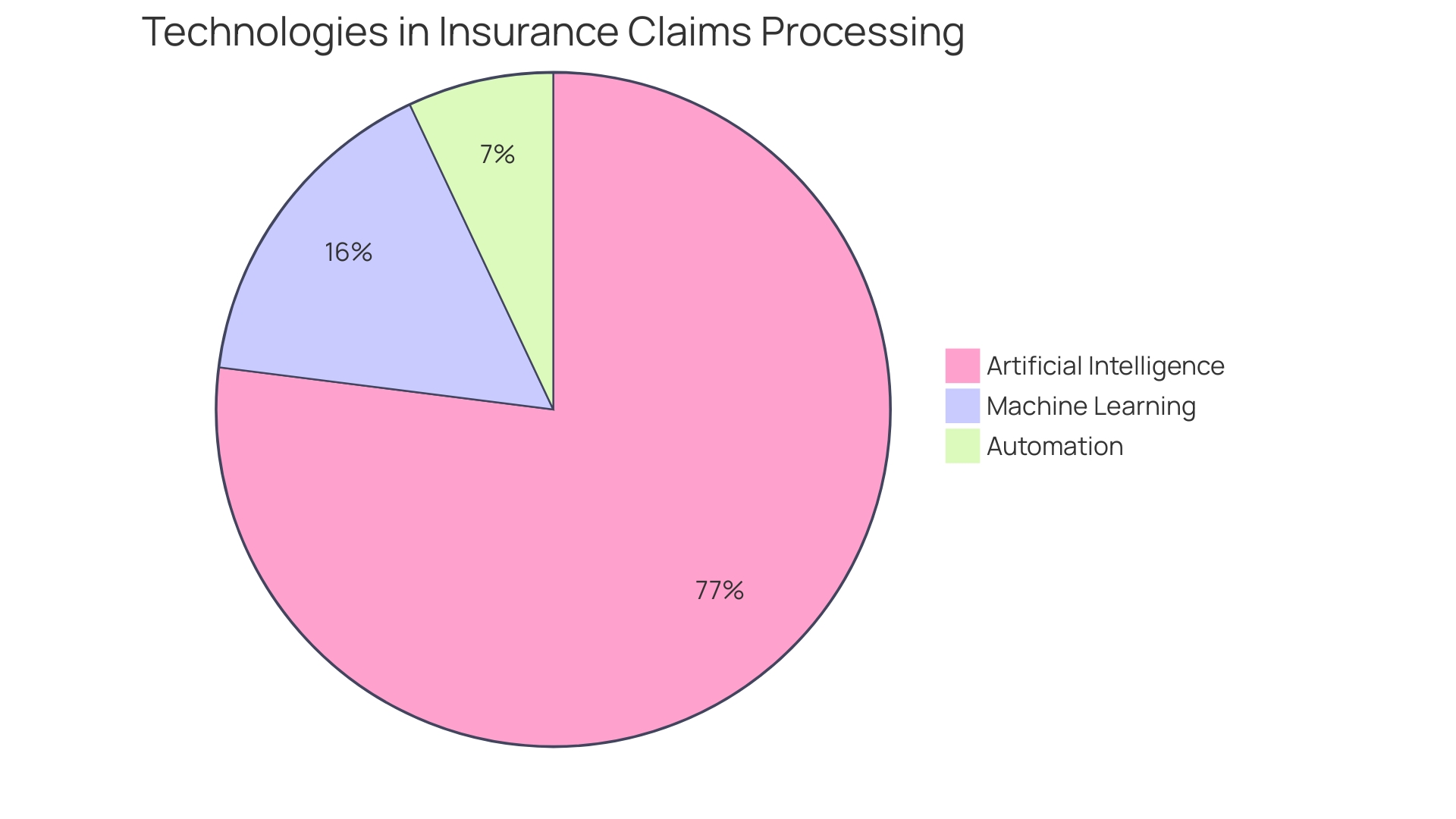
Security and Compliance Considerations
As the insurance industry evolves towards a more digital future, the implementation of automated claims processing has become a pivotal development, particularly in enhancing the efficiency and speed of the underwriting process. However, this innovation brings with it the critical need to address security and compliance issues head-on. Insurance companies are now focusing on safeguarding sensitive customer information and adhering strictly to industry regulations to maintain trust and integrity in their operations.
A thorough risk evaluation is crucial, assessing potential dangers to an organization’s systems and the information they manage. This assessment helps to understand the possible impacts of cyber incidents and to implement effective mitigation strategies. Data protection is a cornerstone of security measures, involving robust encryption and strict access control mechanisms to shield sensitive information both at rest and during transmission.
In the current landscape, where technology such as generative AI is being adopted at varying rates by traditional carriers and insurtechs alike, the industry is witnessing a shift that emphasizes the importance of transparency and ethical use of digital tools. The New York Department of Financial Services is one of the entities leading the charge by issuing guidance on AI usage, ensuring that consumer data and information systems are not misused.
With an eye towards the future, companies providing coverage are also preparing for a workforce transformation, as a significant portion is expected to retire by 2028. This offers an opportunity for the industry to attract new talent who are adept at working with advanced technologies and who can contribute to the evolving landscape of insurance services.
In line with these developments, entities must also be mindful of their obligations under regulations such as the Australian Privacy Principle 11.2, which mandates reasonable steps to destroy or de-identify personal information unless certain conditions are met. Regular reviews of information retention policies are recommended to ensure compliance and the protection of personal information.
The Arab National Bank’s digital transformation journey and the migration of information models using MongoDB Relational Migrator are examples of the strategic initiatives in play. These examples not only demonstrate a dedication to modernization and efficiency but also emphasize the requirement for a coordinated approach to information handling that aligns with lean process automation.
In general, the shift towards automated processing of claims in the insurance sector is a sign of progress, but it must be balanced with a strong commitment to security and compliance to ensure the protection of client data and adherence to ethical standards.
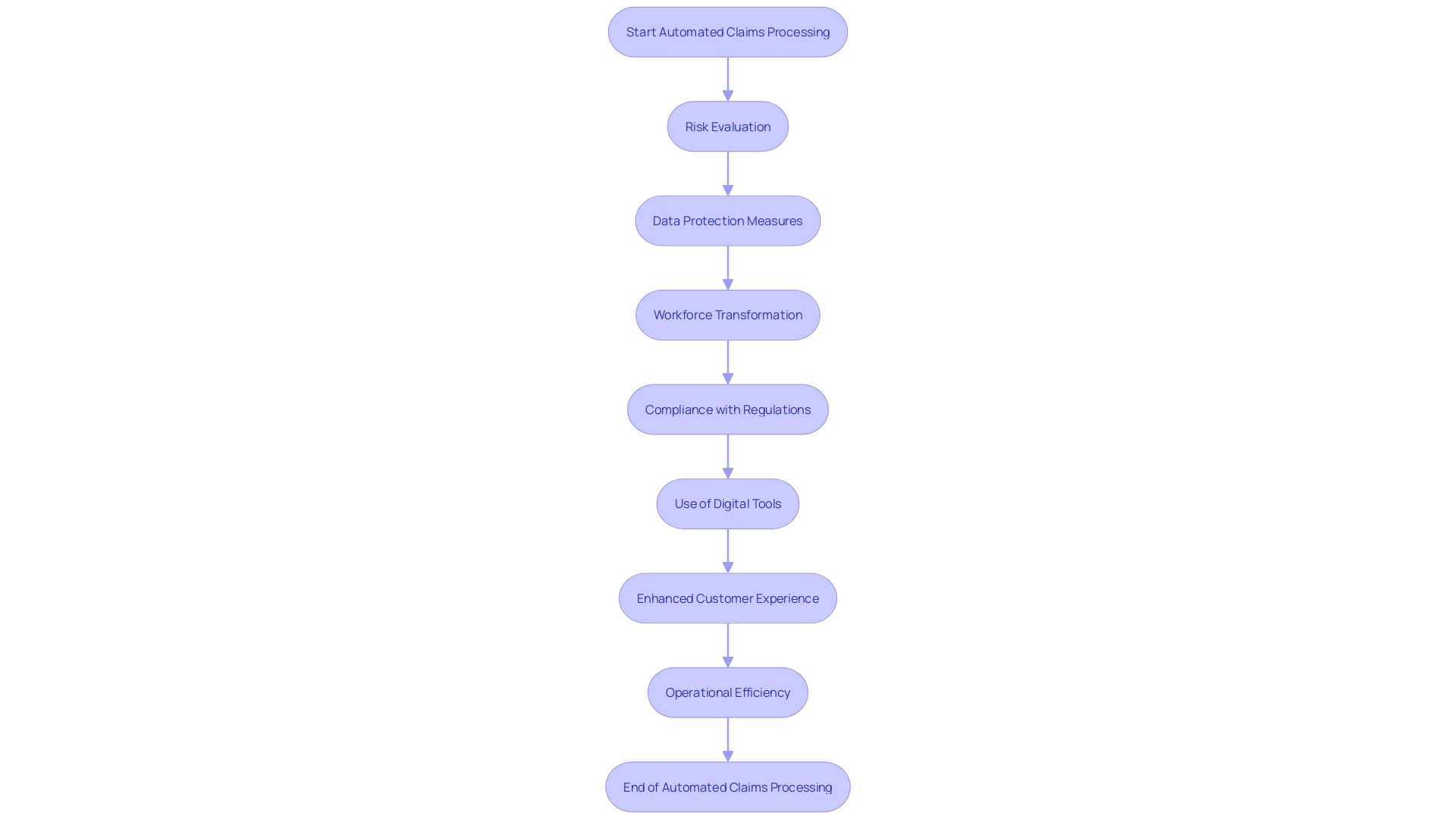
Best Practices for Successful Automation Implementation
As the sector for insuring policies develops with the incorporation of cutting-edge technologies, the implementation of automated processing of reimbursement requests has become crucial. By embracing generative artificial intelligence (GenAI), insurance companies can streamline the management of insurance requests, enhance customer experience, and achieve better operational efficiency. The technology’s ability to search, generate, classify, cluster, and summarize information is transforming the traditional workflow. For example, using GenAI, companies have improved the First Notice of Loss intake by assessing policy coverage and identifying key information, a shift that is both customer-centric and cost-effective.
An example is the Norwegian insurer, Frende Forsikring, which has effectively optimized the distribution of insurance requests to the appropriate management unit by utilizing AI. They consolidated their reporting of requests into a single email address, redirecting each inquiry to the appropriate unit with enhanced accuracy, reducing manual labor and improving processing times.
To ensure the seamless transition to automated processes, insurance companies should consider the following best practices:
-
Begin with a Comprehensive Assessment of Data Sources: Examine your structured legacy data and structured data in JSON format, ensuring that they are accurately categorized and prepared for migration to more flexible databases. A well-executed migration plan, like the one that refactored 21 relational tables to five MongoDB collections, is essential.
-
Balance Strategic Initiatives with Lean Process Automation: Implement solutions that not only foster automation but also provide a holistic view through service orchestration. This approach is critical as the industry prepares for a workforce transition, with many seasoned professionals retiring and new generations stepping in.
-
Invest in InsurTech Solutions: Specialized administration software for insurance, equipped with digital signatures, document management tools, and collaborative features, can autonomously manage routine tasks, enhancing efficiency.
Recent collaborations, such as Cognizant’s partnership with Alm. Brand Group, underscore the industry’s move towards automating traditional manual and repetitive tasks to enhance user experience and operational competitiveness.
Ultimately, the successful implementation of automated claims processing hinges on a clear understanding of the technology’s capabilities, the strategic planning of its deployment, and the continual adaptation of processes to align with evolving customer and industry needs.
Conclusion
In conclusion, automated claims processing powered by AI is transforming the insurance industry. By implementing intelligent document processing and generative AI, insurers can extract crucial information from unstructured data, enhancing efficiency and accuracy.
To successfully integrate automation, strategic planning, technology selection, and a culture open to change are essential. Insurers must also prioritize security and compliance to protect customer data and meet industry regulations.
In summary, the adoption of automated claims processing requires understanding the technology, strategic planning, and process adaptation. By embracing automation, insurers can streamline operations, improve customer satisfaction, and stay competitive in the evolving insurance landscape.
Streamline your operations and improve customer satisfaction by embracing automation today!
Introduction
Implementing agent bots can revolutionize customer interaction, offering convenient and accessible solutions. However, setting up these intelligent agents requires careful consideration and strategic integration. From selecting the right platform to configuring the bot’s settings, every step plays a crucial role in ensuring a seamless customer service experience.
As we approach a future where chatbots may become the primary customer service channel, the need to adopt and adeptly set up these intelligent agents becomes increasingly evident. In this article, we will explore the practicality of bots, discuss effective agent bot interactions, delve into key principles for agent bot design, examine personalized agent bot experiences, highlight best practices for agent bot conversations, explore training and improvement strategies, and discuss monitoring and optimizing agent bot performance. Join us as we unpack the complexities of designing and implementing agent bots to enhance user interaction and elevate customer experience.
Setting Up Agent Bots
Implementing agent bots, like the transformation Benefit Cosmetics undertook for their appointment scheduling, can revolutionize interaction. Instead of a one-way communication through text messages, the beauty industry leader utilized the functionalities of WhatsApp, allowing individuals to conveniently view, modify, or cancel their appointments. This strategic move underscores the importance of selecting the right platform for bot integration, ensuring it aligns with customer preferences and enhances accessibility.
Once the platform is chosen, configuring the bot’s settings is the next vital step. It demands a nuanced method, similar to CurioAI’s personalized podcast production, to meet the needs of a wide range of individuals. By programming the bot with the ability to reason, plan, and take action based on user input, it becomes a 24/7 representative for your brand, equipped with expert-level knowledge and data access.
Integrating this technology into your existing systems is akin to adopting a new platform, reminiscent of the shift from operating systems like Android to more intelligent frameworks. Agents become an extension of your operations, capable of proactive measures such as adjusting pricing or launching campaigns, as highlighted by the potential ubiquity of agents in our daily lives.
To demonstrate the usefulness of bots, take into account the statistics indicating that 37% of chatbots not only collect contacts but also provide assistance. Placed strategically, such as on main or pricing pages, they can address FAQs and collect valuable lead qualification data. This duality of function streamlines communication and automates tasks, ultimately enhancing the service experience. As we near 2027, with forecasts of chatbots becoming the main customer service channel for a quarter of all businesses, the importance to embrace and skillfully establish these intelligent representatives becomes progressively clear.
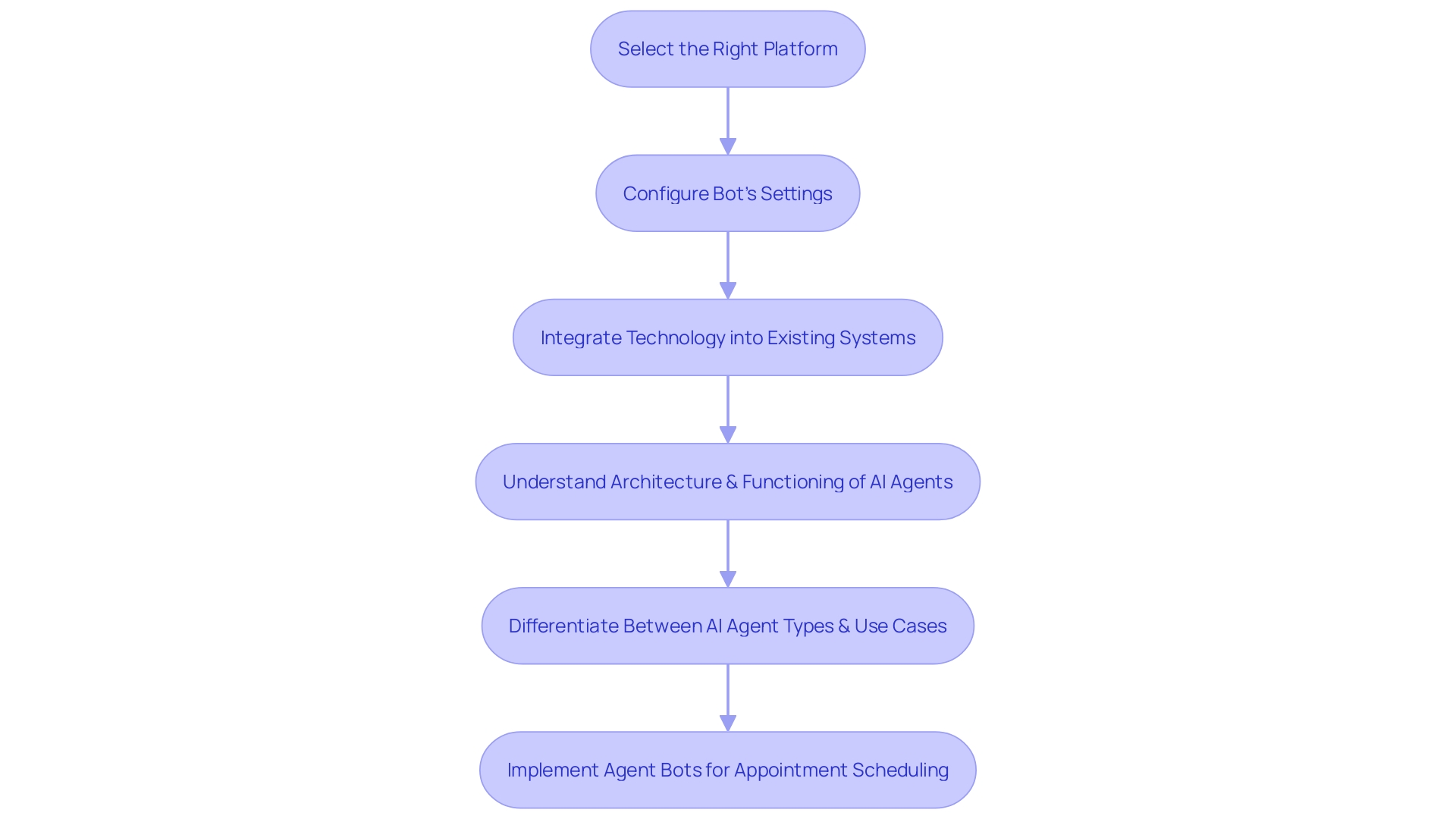
Designing Effective Agent Bot Interactions
To create interactions with agent chatbots that are not only engaging but also efficient, we must consider different approaches for various scenarios. For tasks where success is amorphous—like seeking suggestions rather than definitive solutions—agent bots should provide content that individuals can adapt to their needs. For example, when a bot generates an email template, users typically customize it further. Success in these cases is less about solving a problem and more about providing valuable assistance.
Conversely, when success is explicit and measurable, such as instructing a person to carry out household tasks, the outcomes are clear. Some tasks have a single solution; for instance, when a command is given to switch on a light, there’s only one successful outcome. However, there are scenarios with multiple potential solutions, where various paths could lead to success or failure.
Taking inspiration from Devin, the world’s first fully autonomous AI software engineer, bots should strive for comparable capabilities. With advances in long-term reasoning and planning, Devin can execute complex tasks that involve thousands of decisions, while recalling context and learning over time. This shows the capability for automated assistants to not just follow instructions but also work together and provide suggestions that enhance interactions.
It’s crucial to acknowledge that bots are a new type of software, separate from traditional applications. They present unique challenges including latency, unreliability, and natural language interfaces, which necessitate innovative UI/UX paradigms. As we explore this new frontier of Human-Agent Interaction, it becomes clear that treating AI more like a human collaborator can enhance the way we engage with these systems.
In the realm of prompt engineering, the artistry lies in crafting prompts that are clear yet intricate enough to guide AI towards more nuanced and creative solutions. Techniques like self-refine prompting, where the AI refines its responses through an iterative process, are akin to an artist perfecting a sketch into a masterpiece. This method, in addition to considering the AI as a collaborator in conversation, can result in more individualized and advanced experiences.
As we explore this series on bot interactions, we’ll break down the intricacies of creating conversations that feel organic and conversational, while also customizing the experience to fulfill the unique requirements of individuals. We’ll use up-to-date examples and examine the fundamental principles that will influence the future of our interactions with AI.
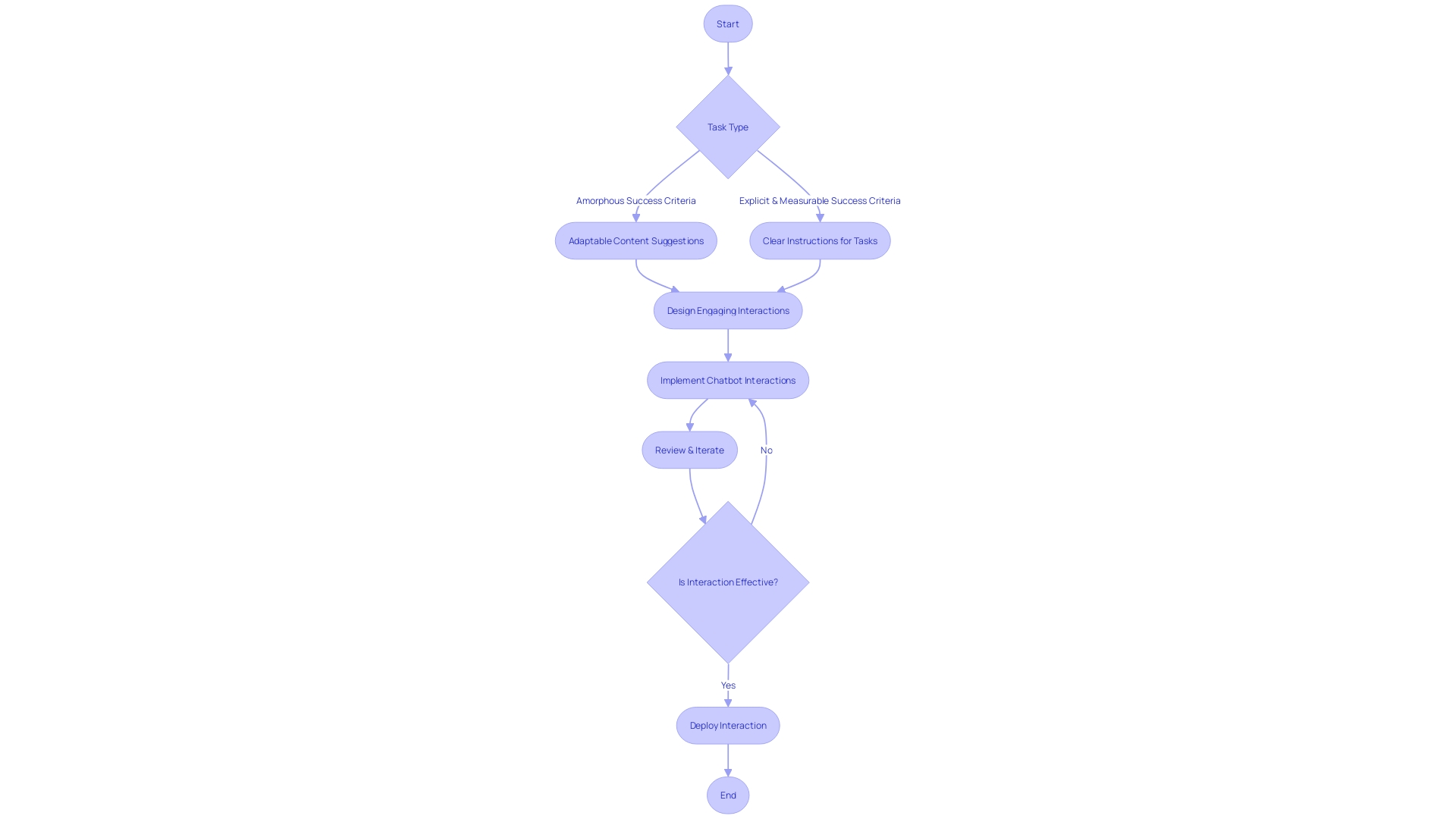
Key Principles for Agent Bot Design
Developing a bot for improved interaction entails constructing a system that is both supportive and independent. These digital assistants are not mere tools; they are designed to reason, plan, and take actions based on user input or environmental conditions, akin to having an expert at your fingertips. For example, a service representative can offer 24/7 technical assistance, while a marketing representative can adjust to evolving business circumstances in real-time.
When designing an agent bot, simplicity, clarity, and consistency are paramount. The bot should provide intuitive interfaces that facilitate seamless navigation. Giving concise and instant feedback is crucial, as it not only informs individuals about the bot’s actions but also allows the bot to enhance its performance based on responses. In this manner, automated bots become more in tune with the specific requirements of individuals.
Complex multi-entity systems, where each individual possesses its own set of sensors and decision-making capabilities, show the breadth of applications, from traffic management to supply chain optimization. These systems rely on coordination through various techniques such as negotiation and cooperation.
In the context of LangChain, a leading open-source framework, developers are empowered to build applications with large language models. By chaining different components, developers can create sophisticated use cases, with differentiation arising from the correct application of these models. This highlights the necessity for domain expertise and a profound comprehension of customer needs to create exceptional experiences.
Incorporating these elements into agent bot design not only enhances interaction but also sets the stage for a transformative business operation. It’s through this careful design process that bots can truly meet the demands of individuals and deliver personalized, efficient service.
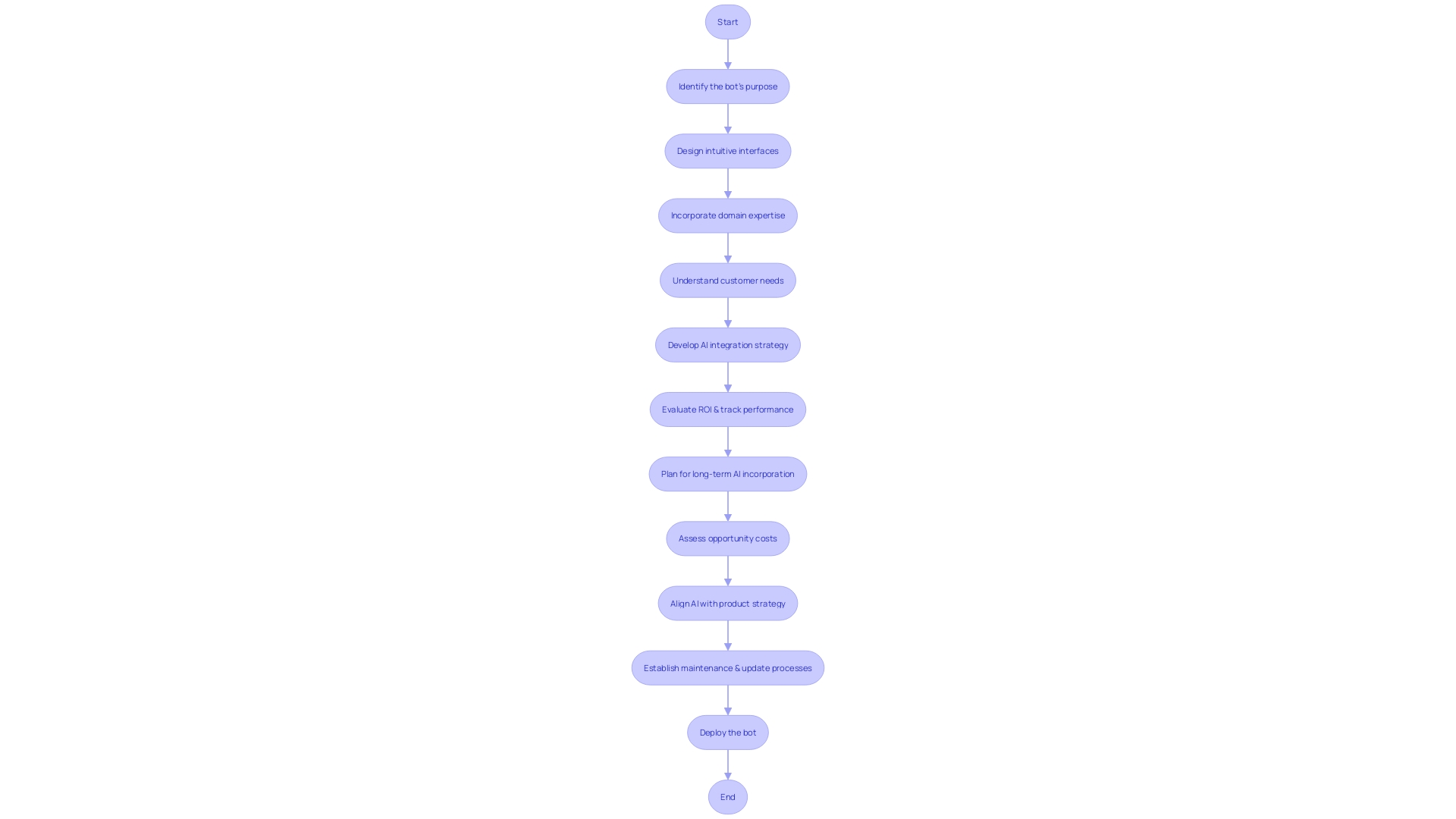
Creating Personalized Agent Bot Experiences
Tailoring interactions through AI-powered chatbots has become a cornerstone of engagement strategies. These digital entities, driven by advanced algorithms, are transforming customer service by delivering instant, round-the-clock replies to inquiries. Divergent from conventional software that necessitates manual operation, these autonomous entities independently gather insights from inputs and environmental conditions, empowering them to analyze, strategize, and execute to accomplish diverse objectives.
To create a truly personalized experience, these intelligent systems rely on the aggregation of user data, tapping into the wealth of knowledge and expertise of human counterparts. For example, in the field of technical support, an AI can provide expert-level assistance at any time, managing requests with the same proficiency as the most knowledgeable staff member. Similarly, marketing professionals can adapt to dynamic business conditions, akin to a self-driving car’s sensors, to proactively adjust strategies like pricing or campaign launches.
Research indicates that individuals increasingly perceive these conversational agents as social actors, integrating them into daily routines and building long-term relationships. This change highlights the necessity for businesses to utilize AI chatbots not only as tools but as part of a more extensive engagement platform.
Recent statistics further highlight the impact of chatbots, showing that all examined EdTech websites utilized chatbots for contact collection, with 37% providing additional user support. This trend is set to expand, with predictions that chatbots will become the main service channel for a quarter of all businesses by 2027. The advantages are evident: individuals appreciate decreased response times and customized support, while teams are relieved of repetitive tasks, enabling them to concentrate on more complex issues.
In a digital era where immediate and customized interaction is paramount, the development and deployment of AI chatbots are not just a trend but a transformative element in interaction, setting the stage for the next generation of customer experience platforms.
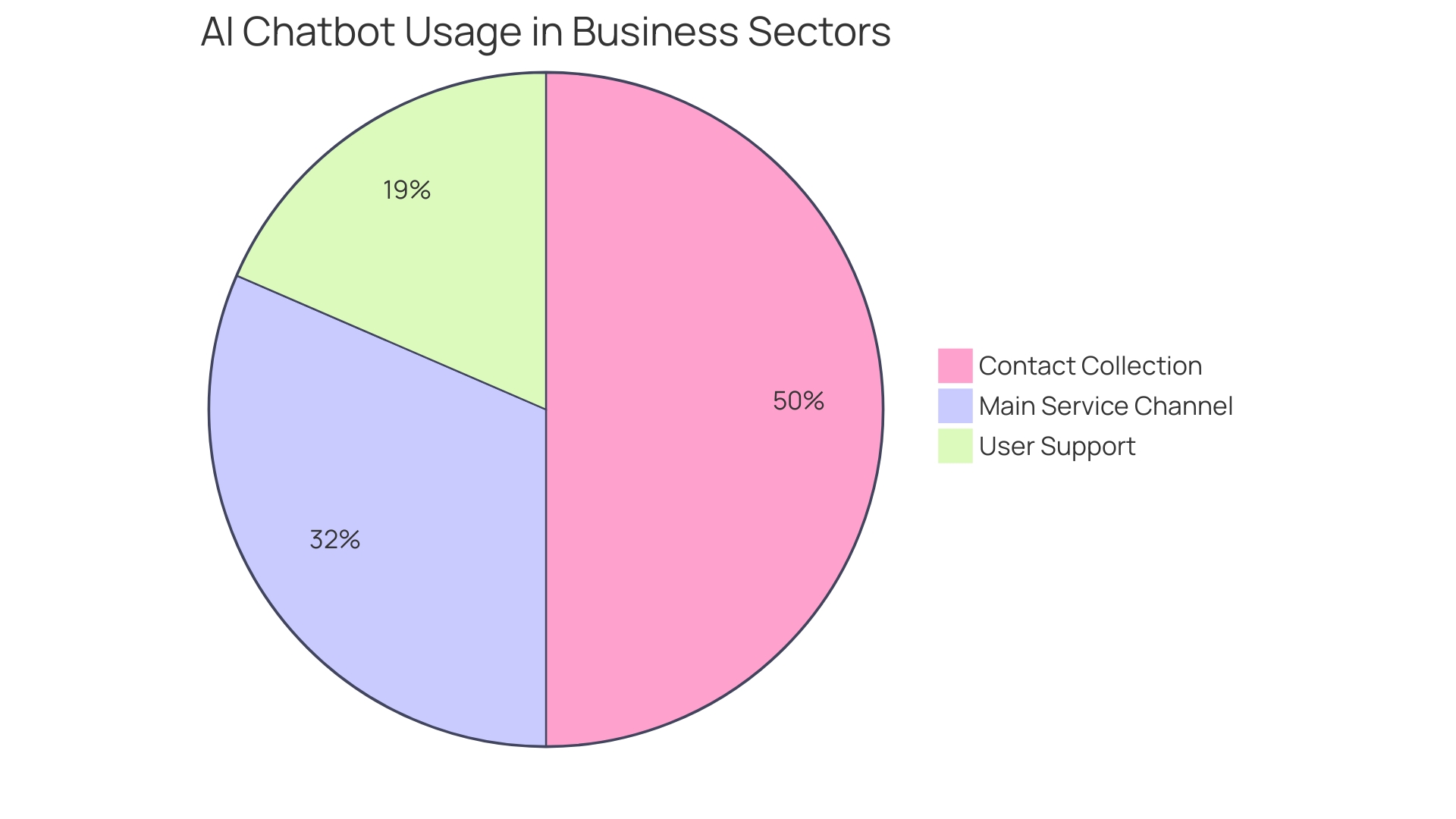
Best Practices for Agent Bot Conversations
Creating bot dialogues that resonate with individuals is crucial for any business aiming to remain competitive. By leveraging AI chatbots, companies can handle complex queries, maintain context throughout the interaction, and set clear expectations—all of which are crucial for a smooth user experience. For example, Holiday Extras, a European leader in travel extras, effectively utilizes ChatGPT Enterprise to assist their diverse user base. With a single marketing team managing many markets and requiring copy in multiple languages, chatbots have enabled them to scale their support and maintain data fluency across the organization.
In the face of constantly evolving user needs, the chatbot market is booming, with a projected growth from $2.6 billion in 2019 to $9.4 billion by 2024. This growth reflects the rising demand for sales, support, and marketing solutions facilitated by chatbots. In fact, 56% of people now prefer messaging over calling customer service. The European market leads the adoption with 45% of chatbots, followed by North America at 28%.
To harness the full potential of chatbots, it’s important to be precise in your communication. For instance, when generating an error message for a login interface, it’s crucial to offer unambiguous, precise directions to the individual. This level of detail ensures that chatbots can effectively manage interactions, providing responses that are relevant and helpful. As chatbots become an integral part of our daily lives and businesses, staying informed about chatbot statistics and trends is crucial for any organization looking to innovate and provide enhanced interaction.
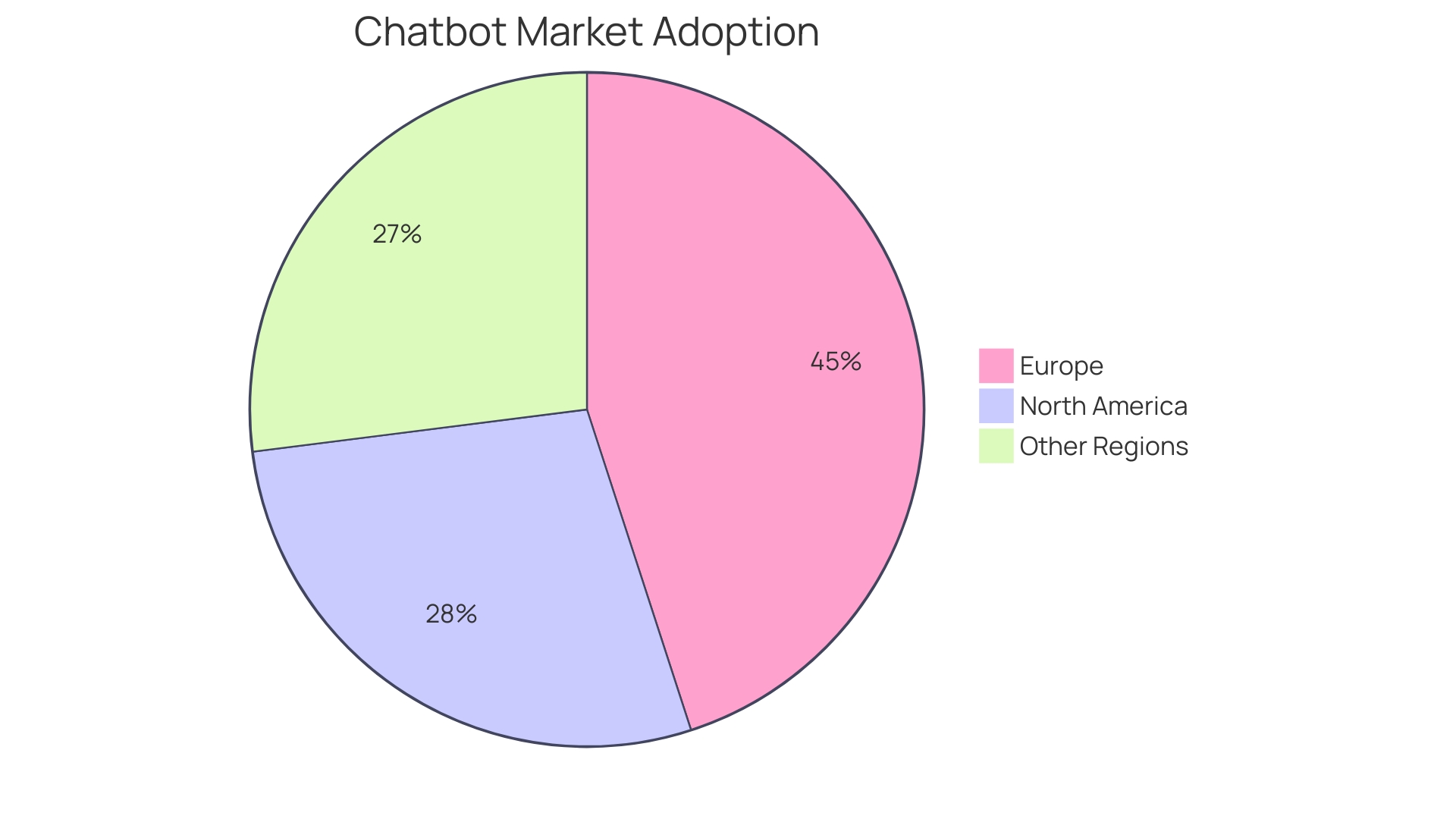
Training and Improving Agent Bots
Optimizing the capabilities of automated assistants requires an ongoing process of instruction and improvement to enhance their engagements with individuals. By utilizing top-notch data and sophisticated machine learning algorithms, these automated systems can develop to enhance comprehension and address user requirements. For instance, consider the Benefit case, a major energy company that faced challenges with its expansive document base. Employees spent an average of 18 minutes to find answers within internal documents, with some queries taking over an hour or even remaining unresolved. Implementing a well-trained agent bot could significantly reduce this time by providing instant, accurate responses to common inquiries.
An effective training strategy includes an iterative process, akin to an artist refining a sketch, where artificial intelligence agents are given initial prompts and then gradually guided towards more precise and sophisticated outputs. This self-improvement is essential for developing artificial intelligence systems that can handle complex interactions. For example, the implementation of Reinforcement Learning (RL) techniques, although mathematically challenging, can reward bots for desired behaviors, thereby encouraging optimal decision-making patterns.
The structure of an AI entity, as explained by specialists, comprises essential elements such as perception and decision-making procedures. Through sensors and data inputs, the entity perceives its environment and acts accordingly. By iterating on these processes, the performance of AI individuals can continually improve, leading to more efficient and effective interactions.
In the domain of AI agent development, the equilibrium between data privacy and personalized experiences is of utmost importance. As we uphold privacy, choices regarding data usage are essential to maintaining trust while enhancing service quality. The commitment to continuous improvement, as evidenced by the collaborative efforts in the AI community, underscores the importance of evolving our AI solutions to meet the ever-changing demands of business operations.
Monitoring and Optimizing Agent Bot Performance
To enhance interaction through AI-driven solutions, it is essential to assess the performance of AI chatbots meticulously. By analyzing key performance indicators and employing robust monitoring tools, we can pinpoint areas for enhancement. This involves analyzing response times, identifying bottlenecks, and improving efficiency to ensure the chatbot delivers a high-quality experience for its users.
Leveraging real-time monitoring, such as wall time analysis, provides insights into the chatbot’s operational dynamics. By examining stack traces, we can determine if a chatbot is idle or actively processing requests. This data is invaluable for streamlining the bot’s interaction pathways and ensuring it operates at peak performance.
Moreover, embracing a culture of data literacy, akin to Holiday Extras, bolsters the ability to harness metrics for continuous improvement. Intuitive dashboards and metrics empower even less technical team members to contribute to the optimization process.
In the realm of AI agents, companies such as Spotify are establishing the benchmark by crafting engaging audio and video experiences for individuals. This is a testament to the significance of developing AI applications to sustain engagement and fulfill individuals’ expectations. For chatbots, this translates into an evolution beyond simple text interactions, potentially incorporating multimedia elements to enrich interaction.
The AI agent space is burgeoning, with the potential for agents to perform tasks autonomously, even while humans rest. This evolution requires a change in emphasis towards developing seamless, integrated experiences where chatbots serve as the principal interface for needs.
In sum, optimizing AI chatbot performance is not just about technical adjustments, but about creating a data-informed culture that leverages the full potential of AI to revolutionize user interaction.
Advanced Techniques for Agent Bot Development
Cutting-edge methods in agent bot development are transforming the way businesses engage with their clients. By utilizing the potential of natural language processing (NLP) and machine learning, these bots can conduct sentiment analysis to comprehend the emotional tone behind feedback. This allows for the quantitative scoring of subjective opinions, making it possible to gauge sentiment at scale. As businesses incorporate AI solutions such as voice recognition and image processing, they can greatly improve interactions with individuals.
Sentiment analysis, or opinion mining, is particularly transformative. It parses through text data such as social media comments and assigns a sentiment score, providing invaluable insights into perceptions. This technology can be tailored to specific aspects, allowing companies to understand sentiments about particular product features or services. For instance, a review stating “The software is easy to use but expensive for what it offers” reflects positive feedback on usability contrasted with negative sentiment on pricing.
Moreover, the integration of AI goes beyond text, with technologies like IoT enabling devices to communicate and share data. This interconnectedness paves the way for more personalized and context-aware interactions. An instance of such innovation is Microsoft’s Be My AI™-Powered Disability Answer Desk, which provides 24/7 support to individuals with blindness or visual impairment. This AI solution, driven by the lived experience of the blind community, represents a leap forward in making service more accessible and responsive to user needs.
When developing these sophisticated NLU systems, it’s crucial to understand the specific objectives and use cases they will serve. This might include conversational agents for service, content analysis for market research, or text-based decision-making for internal workflows. Developers must also consider the practical challenges of language and context. This includes training models on massive datasets to ensure high accuracy and understanding cultural nuances, idiomatic expressions, and emotions.
The potential of AI chatbot development, automation, and consulting services is immense. With a strategic approach to incorporating advanced AI technologies, businesses can not only streamline their operations but also forge deeper connections with their customers.
Conclusion
In conclusion, implementing agent bots revolutionizes customer interaction by offering convenient and accessible solutions. Selecting the right platform and configuring bot settings are crucial for a seamless customer service experience. Designing effective interactions involves considering different approaches and enabling bots to reason, plan, and collaborate with users.
Creating personalized bot experiences involves customizing interactions through AI-powered chatbots. These bots gather insights, reason, and act to fulfill various tasks. Chatbots are predicted to become the primary customer service channel, and businesses should harness them as part of a broader customer engagement platform.
Crafting resonating conversations requires precision in communication and staying informed about chatbot trends. Leveraging AI chatbots helps handle complex queries, maintain context, and set clear expectations. Continuous training, balancing privacy and personalization, and optimizing performance are essential for maximizing bot potential.
Advanced techniques like natural language processing and machine learning enhance customer interactions. Sentiment analysis quantifies subjective opinions, allowing businesses to gauge customer sentiment at scale. AI technologies like voice recognition and image processing further improve user interactions.
In conclusion, designing and implementing agent bots enhances user interaction, elevates customer experience, and ensures competitive advantage. These intelligent agents offer practical solutions, improving customer engagement and satisfaction.
Introduction
Web automation has emerged as a transformative force in today’s competitive business landscape, offering a range of benefits that go beyond saving time. From streamlining mundane tasks to enhancing operational efficiency, web automation is empowering businesses to achieve new levels of productivity. In this article, we will explore the benefits, tools, best practices, common use cases, and the process of selecting the right web automation tools.
We will also delve into designing and writing effective web automation test cases, as well as setting up environments and implementing parallelization techniques for efficient automation. Whether you are a developer or a non-technical user, this article will provide practical insights and solutions to help you leverage the power of web automation and drive operational excellence in your organization.
Benefits of Web Automation
Web technology stands as a transformative force for countless businesses, providing a vital edge in today’s competitive marketplace. At its essence, web streamlines a variety of online activities, surpassing the monotonous form fills to the intricacy of data extraction and content management systems. This digital leverage is not just about saving time; it’s about ensuring precision, reducing manual errors, and fostering a new level of operational efficiency. The scalable nature of technological advancements is particularly compelling, equipping businesses to manage and analyze vast data sets with unparalleled speed and agility.
The emerging functionalities of web robotic process encapsulate in Robotic Process RPA, a technological advancement that utilizes software bots to imitate or perform actions across various software or data systems, typically done by humans. These bots are adept at an array of functions from data entry and transaction processing to customer service interactions. The recent advancements in RPA have made a notable impact, facilitating the smooth integration of systems, freeing businesses from numerous tasks, and enabling the mechanization to bear the workload.
Observations from top companies demonstrate the significant impact of web mechanization. Specsavers, a pioneer in optometry, navigates a complex global supply chain and has innovated bespoke business processes and in-house technologies to surmount the challenges of integrating older medical devices into modern systems. Similarly, the finance sector has witnessed a proliferation of AI tools, with professionals seeking the best fit for enhancing their operations and customer experiences. Marketing has also seen a surge, with companies leveraging it to refine their financial services.
These advancements resonate with Tim Berners-Lee’s vision for the web, as we commemorate the 35th anniversary of its inception. His vision for a future where data flows effortlessly and artificial intelligence assistants have a deep understanding of our personal needs suggests the vast potential of web technology. This is further underscored by the recent surge in artificial intelligence, as highlighted in the notable scientific and technological advancements of 2023.
The integration of workflow mechanization is becoming more and more pervasive in contemporary enterprises, as a report by Zapier discloses that almost all employees in smaller businesses participate in repetitive assignments. The mechanization of such tasks is not just a convenience; it’s an essential strategy to reallocate valuable resources towards more strategic, value-added work. With the landscape of business continuously evolving, the strategic implementation of mechanization stands as an indispensable ally in the quest for operational excellence and sustainable growth.
Tools and Technologies for Web Automation
Web automation technologies have become indispensable in our rapidly digitizing world, with tools such as Selenium, Puppeteer, and BeautifulSoup at the forefront. They empower developers to automate interactions with web elements, simulate user actions, and harvest data from websites efficiently. Selenium, born from the visionary thinking of Jason Huggins at ThoughtWorks in 2004, has positioned itself as a versatile powerhouse, valuable not only for testing but also for automating a range of web-based administrative activities.
Beyond the realm of testing, the integration of Selenium with languages like Python has unlocked powerful opportunities for web scraping, a process that is becoming increasingly crucial for data analysis and machine learning endeavors. Moreover, the advent of Robotic Process Automation (RPA) technology has signaled a new era where bots emulate human actions, streamlining tasks such as data entry and transaction processing across diverse applications and platforms.
In the realm of software development, the significance of Quality Assurance (QA) cannot be emphasized enough, and mechanized instruments have become essential in guaranteeing software reliability. By automating test cases and validating outcomes, these tools, including JUnit for Java applications, mitigate human errors and enhance efficiency across multiple testing environments.
As we stand at the threshold of another year, full of technological advancements, it’s evident that the role of AI in web testing and testing will only grow more pronounced, reshaping workflows and introducing new paradigms in efficiency and effectiveness for developers and technologists alike.
Step-by-Step Guide to Building Automated Web Tasks
Developing efficient and sustainable solutions for web-based processes requires more than just coding; it’s about comprehending the complexities of each activity and designing a viable answer. To initiate this procedure, explore the manual implementation of activities to understand their intricacies, which can reveal the most recurring and mistake-prone operations ready for mechanization. Thorough documentation is crucial, documenting every element, from the instruments employed to the duration consumed, offering a plan for improving and advancing the workflow.
Once you’ve identified the monotonous tasks, you can utilize web tools to create scripts that interact with web interfaces, smoothly performing operations like form submissions or content updates. For example, utilizing powerful frameworks like. NET along with browser-managing libraries like Selenium, and incorporating AI features from platforms like OpenAI, enables advanced processes like summarizing email content.
As you develop these scripts, it’s crucial to put them through rigorous testing, refining their accuracy and reliability. Real-world case studies, like the creation of an automated podcast workflow, demonstrate the transformative impact of a well-oiled system, transforming creative aspirations into a streamlined, productive reality.
Scheduling or event-triggering these processes ensures they operate seamlessly within the set parameters, like the timely release of a podcast episode or updating website content. As the demand for mechanization expands, with an anticipated market rise to $264.69 billion by 2026, and with administrative tasks scheduled for a 69% mechanization rate by 2024, the quest for such technological progress is not just advantageous but necessary.
In the wide range of industries, from IT and finance to healthcare, the appropriate tools for streamlining processes can greatly enhance productivity, with engineering and IT overseeing a significant portion of an organization’s efforts to streamline operations. Whether it’s a no-code solution for non-technical users or a more complex system for developers, the end goal remains the same: a seamless user experience that delivers excellence in streamlining processes.
Best Practices for Web Automation
Web mechanization is a critical component in enhancing operational efficiency and delivering seamless services, much like the efforts of Surrey County Council in improving experiences for citizens and employees. To achieve this, developers must incorporate a structured approach, starting with planning and preparation. This entails clearly delineating the scope of mechanization, selecting cost-efficient and requirement-compatible tools, and establishing a strong framework to sustain mechanization endeavors.
Next, attention must be given to test case and data preparation. This entails configuring a test environment that accurately reflects the production setting and managing test data effectively. Moreover, security must be a priority, with vigilant authentication and access control measures to safeguard automated processes against the increasingly sophisticated tactics of bad bots, which now account for nearly a third of all web traffic.
To guarantee the durability and flexibility of scripts, they should be modular and reusable. This philosophy aligns with modern development practices, as evidenced by the technical stack selection for offering a consistent user experience that includes Django, Tailwind, and HTMX.
Monitoring and error handling are imperative to promptly identify and rectify any issues. This proactive stance is supported by data showing that a significant portion of attacks can be traced to their initial entry point, underscoring the importance of continuous vigilance.
Lastly, thorough documentation and knowledge sharing are indispensable for fostering team collaboration and effective troubleshooting. As the landscape of automation continues to evolve with advancements in IoT, AI, ML, and digitalization, staying informed through resources like Automation.com can provide valuable insights into current trends and best practices.
Common Use Cases for Web Automation
Automation technologies are transforming industries by carrying out a wide range of activities, including e-commerce price monitoring, social media management, data extraction, and website testing. For example, suppliers aiming to be competitive in online marketplaces like Home Depot utilize web scraping technologies, such as Helium Scraper, to monitor and adjust their product pricing based on real-time market data. This enables them to maintain a competitive edge by staying abreast of pricing trends and customer preferences.
In the realm of e-commerce, online sellers leverage tools like eBay scraper to track and analyze prices of similar products, allowing them to strategically adjust their pricing models. This approach not only enhances their competitiveness but also increases their profitability by responding swiftly to market demand fluctuations.
Moreover, the advancements in artificial intelligence have been recognized as a significant technological driver, with Collins Dictionary naming ‘AI’ as the word of the year for 2023. Ai’s capabilities in automating complex tasks are transforming industries, with its applications extending to automating devices and programming tasks.
In software development, careful planning and preparation are essential for an effective strategy. This involves defining the scope, selecting budget-friendly tools that meet specific requirements, and establishing a robust testing framework. Preparing accurate test data and configuring the environment to mirror production settings ensures the reliability and accuracy of automated tests.
The International Federation of Robotics reports a surge in manufacturing industrial robots, confirming the crucial role of technology in modern industries. Service sectors are also adopting automated processes, employing chatbots and virtual assistants to enhance customer interactions.
As we progress, the implementation of workflow streamlining is proving to be essential, with statistics indicating a significant increase in business dependence on streamlining post-pandemic. These trends emphasize the need for industries to evolve and adopt technology to maintain and enhance productivity and efficiency.
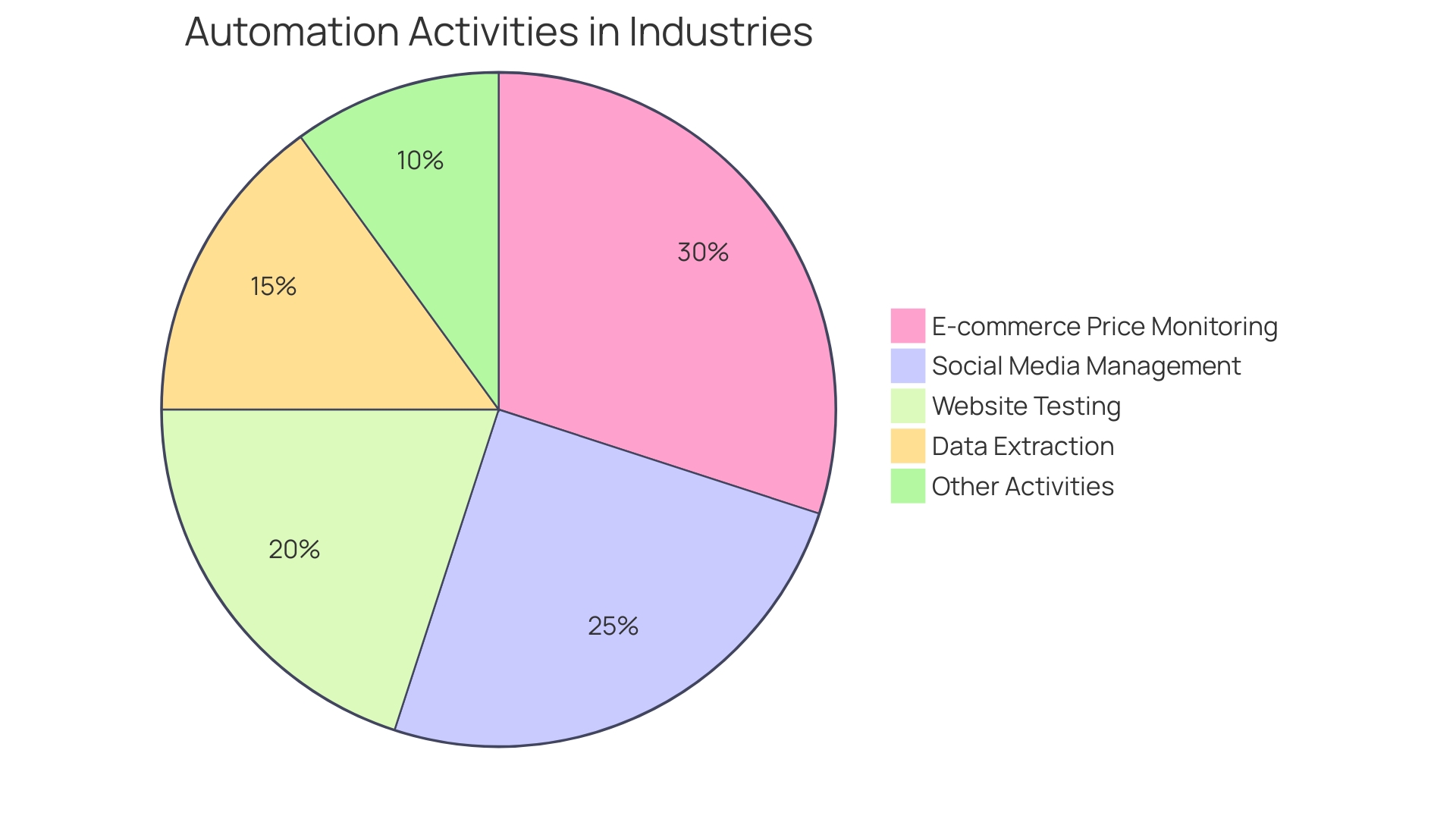
Selecting the Right Web Automation Tools
Choosing the perfect web solution relies on a thorough comprehension of your objectives and the particular requirements of your project. Start by analyzing the nature of your application, whether it’s a web, mobile, or desktop platform, and the operating systems it needs to support. This will assist you in determining the compatibility requirements of your automation software. Next, assess the skill set of your team; if they’re more adept with certain programming languages or development practices like BDD, choose a tool that aligns with these strengths.
Furthermore, contemplate the user profile and the complexities of the tasks at hand. A DevOps-focused platform might be necessary for some, while others could benefit from a more versatile solution. It’s also vital to consider who will be using the tool—developers or non-technical staff—as this will affect the ease of use and the level of code complexity (no, low, or high-code) required.
Due to the recent surge in the demand for mechanization, particularly after the pandemic, and industries such as IT, finance, healthcare, and manufacturing making significant investments in streamlining processes, the market is abundant with a range of solutions. The data shows that the businesses embracing workflow streamlining are moving forward, making it more crucial to select a solution that not only fulfills present requirements but is also adaptable for future growth.
To ensure you make an informed decision, delve into research, consider reviews, and seek expert opinions. Search for solutions that provide the versatility to reuse test steps across various scenarios, which can save valuable time and resources. Keep in mind, with the appropriate tool, you can greatly improve productivity and operational efficiency across different teams within your organization.
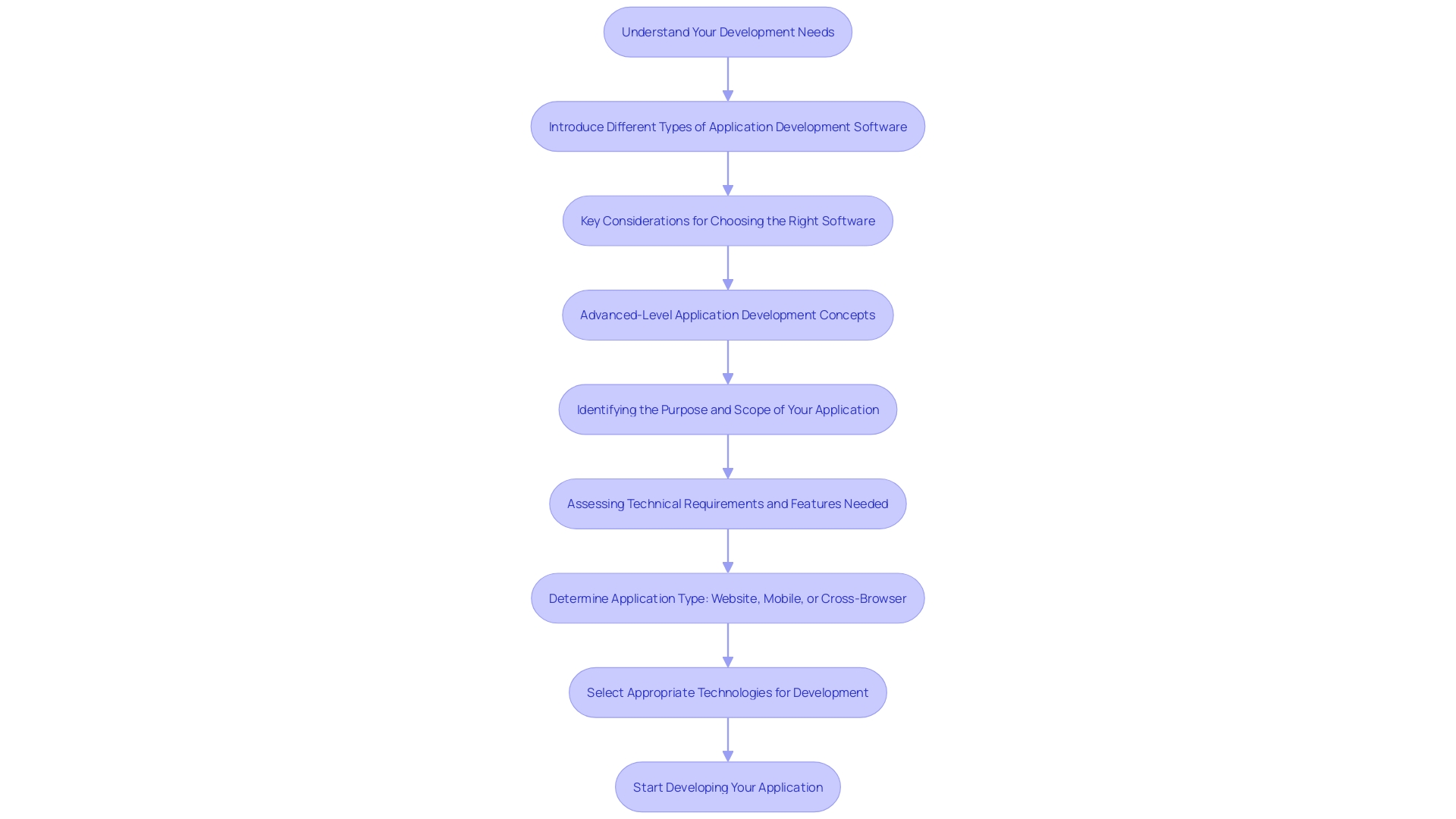
Designing and Writing Web Automation Test Cases
When venturing into the realm of automated web tasks, crafting robust test cases is paramount. The procedure commences with a thorough analysis of the application in question. This foundational step encompasses an examination of features, business rules, and the company’s wider product portfolio. On the technical front, understanding the development stack, architecture, and associated services is vital. With this comprehensive knowledge, one can tailor the automated tests to the nuances of the application, ensuring a more effective testing outcome.
To support the process of streamlining tasks, deploying a well-structured framework is essential. The framework should be designed from the ground up, possibly utilizing the capabilities of tools like Playwright for end-to-end testing. These tools not only enable the streamlining of test execution but also enhance it with capabilities like visual comparison, which is particularly useful in verifying UI elements.
Moreover, the preparation of test data is not to be underestimated. It involves meticulous creation, management, and organization to mirror the intricacies of production environments. This step is crucial for achieving test accuracy and reliability.
In the fast-paced world of 2024, where email outreach is a significant challenge for companies, the principles of testing technology resonate similarly. Automating processes like email contact acquisition can significantly cut down on time and resources, enabling businesses to concentrate on more strategic activities. This method has been demonstrated to save time, accumulate dependable data, and speed up operations, as observed in the frameworks developed for various industries.
Finally, it’s important to acknowledge that while ‘fully unit tested’ claims from vendors may provide a sense of security, the depth of testing can vary significantly. As revealed by industry experiences, thorough, comprehensive testing that includes various scenarios and edge cases is necessary to ensure quality and prevent the hard lessons learned from insufficient testing practices. The implementation of an end-to-end test framework is not just a technical task but a strategic move towards operational excellence and marketplace success.
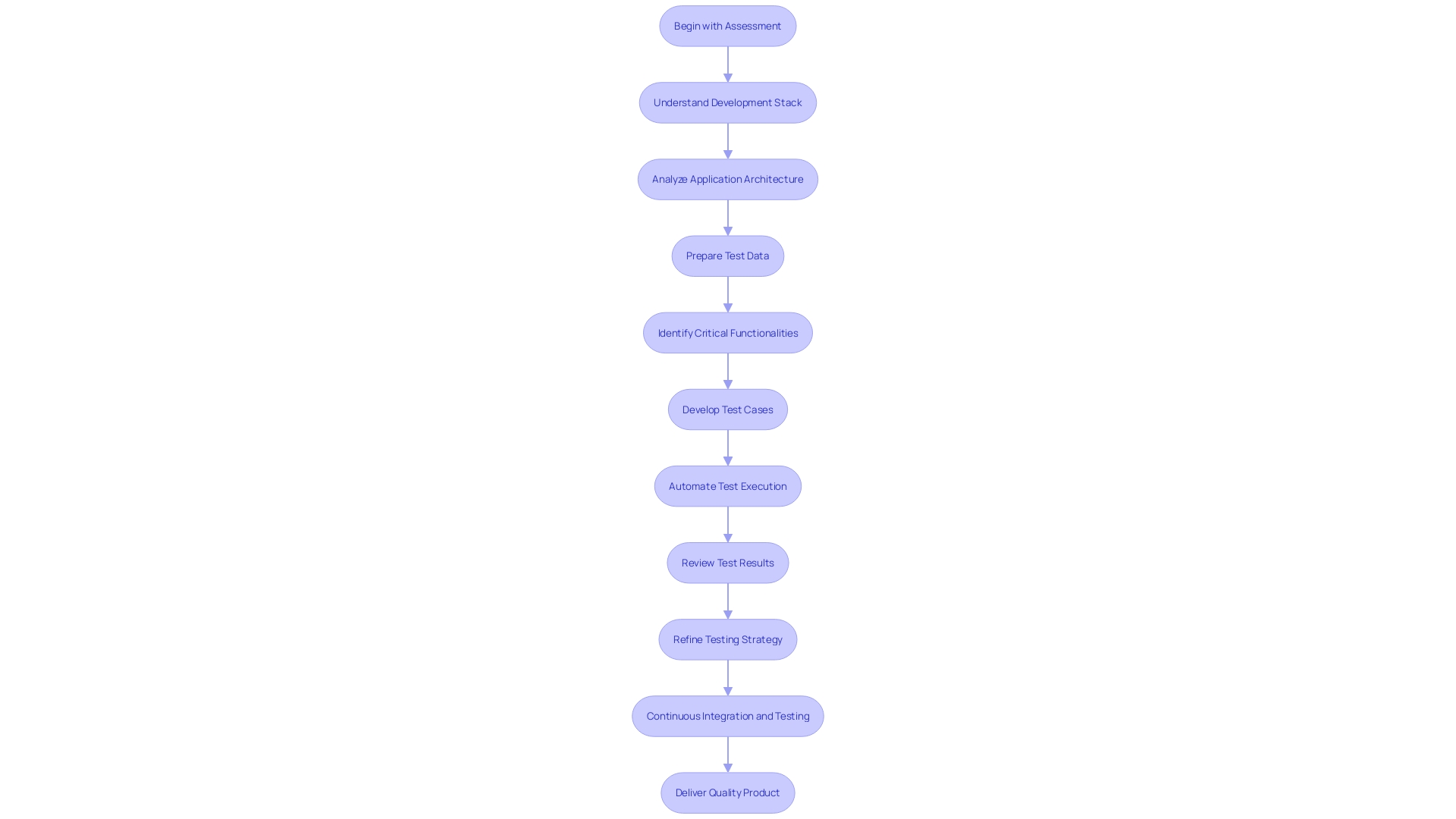
Setting Up Environments and Parallelization for Web Automation
Efficient and scalable web operations are paramount, and achieving this starts with constructing a robust environment setup. It’s important to delineate separate environments for development, testing, and production to circumvent conflicts and guarantee stability. Markos Fragkakis, a Staff Engineer at Workable, underscores the significance of a meticulous setup, recounting how their Applicant Tracking System required a careful approach to manage its growth even as parts of it were segregated as other services.
In parallel, leveraging parallelization techniques is not just a matter of convenience but a necessity. Running multiple instances of scripts concurrently is a game-changer, enhancing performance while slashing execution times. This strategy aligns with industry trends, where a emphasis on mechanization enhances return on investment (ROI) by expanding test coverage exponentially. For instance, the Industrial Automation Services Market is poised for significant growth, expected to swell from $147.06 Billion in 2019 to $264.69 Billion by 2026.
Furthermore, the embrace of ephemeral environments, as delineated in ‘Introduction to Temporary Environments: A Beginner’s Guide’, showcases how automated setups with isolated, easily created and deleted environments are revolutionizing software testing. These contemporary solutions address the drawbacks of shared persistent environments by eliminating infrastructure overhead and queueing delays.
Automating as many tasks as possible is crucial, as highlighted by the statistic that 94% of companies engage in repetitive tasks. The emergence of mechanization and digitalization has enhanced jobs for 90% of knowledge workers, emphasizing the significance of embracing these strategies to uphold a competitive advantage in the fast-paced digital landscape.
In essence, properly segmenting environments and employing parallelization are not just best practices but are integral to the fabric of efficient web automation, shaping the future of the industry and the workforce within.
Conclusion
In conclusion, web automation is a transformative force that enhances operational efficiency and reduces manual errors. Robotic Process Automation (RPA) allows software bots to replicate or execute tasks traditionally performed by humans. Tools like Selenium, Puppeteer, and BeautifulSoup empower developers to automate interactions with web elements and harvest data efficiently.
Building effective automated web tasks involves understanding task intricacies, employing web automation tools, rigorous testing, and scheduling automations. Best practices like planning, test case preparation, security measures, and thorough documentation ensure seamless services and effective troubleshooting.
Web automation is widely used in various industries for tasks like e-commerce price monitoring, social media management, data extraction, and website testing. Selecting the right automation tools requires understanding project goals, application nature, team skills, and user profiles.
Designing and writing web automation test cases involve thorough analysis, deploying a well-structured framework, and meticulous test data preparation. Comprehensive testing ensures quality and prevents issues.
Setting up environments and leveraging parallelization techniques are crucial for efficient and scalable web automation. Properly segmenting environments and automating tasks contribute to operational excellence.
In summary, web automation empowers businesses to achieve operational excellence and drive productivity. By embracing the benefits, selecting the right tools, following best practices, and designing effective test cases, organizations can harness the full potential of web automation in today’s competitive business landscape.
Introduction
Robotic Process Automation (RPA) is a transformative technology that empowers organizations to automate routine tasks using software robots, or ‘bots’. These bots imitate human interactions with digital systems, performing functions like data entry and extraction with precision and speed. RPA seamlessly integrates with existing systems, enhancing business processes without the need for significant infrastructural changes.
This article explores the essence of RPA, its application in various industries, key features, and how it works. Discover how RPA is revolutionizing operational efficiency and empowering human resources to focus on more strategic initiatives.
What Does RPA Stand for?
Robotic Process Automation (RPA) represents a transformative technology that empowers organizations to automate routine, rule-based tasks through the use of software robots, or ‘bots’. These bots are capable of imitating human interactions with digital systems to perform functions such as data entry, manipulation, and extraction with precision and speed. Instead of needing extensive integration, RPA smoothly operates alongside existing systems, improving operational workflows without the need for significant infrastructural modifications. This not only introduces a high level of efficiency but also presents a cost-effective approach to process management.
For instance, Surrey County Council, serving over a million residents in England, has embraced automation to improve both citizen and employee experiences. In a similar vein, Louvre Hotels Group has harnessed the power of RPA to save hundreds of hours per month in maintaining rate code details, underscoring the technology’s potential to revolutionize operational efficiency in the hospitality industry.
The essence of RPA is its ability to connect disparate systems, creating a seamless workflow that liberates employees from monotonous tasks, allowing them to focus on more strategic initiatives. Automation technology is not a ‘set it and forget it’ solution; it requires ongoing monitoring and management to ensure optimal performance, something which aligns with the historical evolution of automation. From water wheels to AI, the goal has always been to enhance productivity and convenience, yet human oversight remains crucial.
As we navigate the future of automation, industry leaders like Coding Crafts highlight the importance of staying at the forefront of technological advancements. Their focus extends beyond RPA, incorporating services like Blockchain Development for enhanced security and transparency. With automation reshaping the technological landscape, it’s evident that RPA is not just a trend but a crucial tool in the modernization of organizational processes.
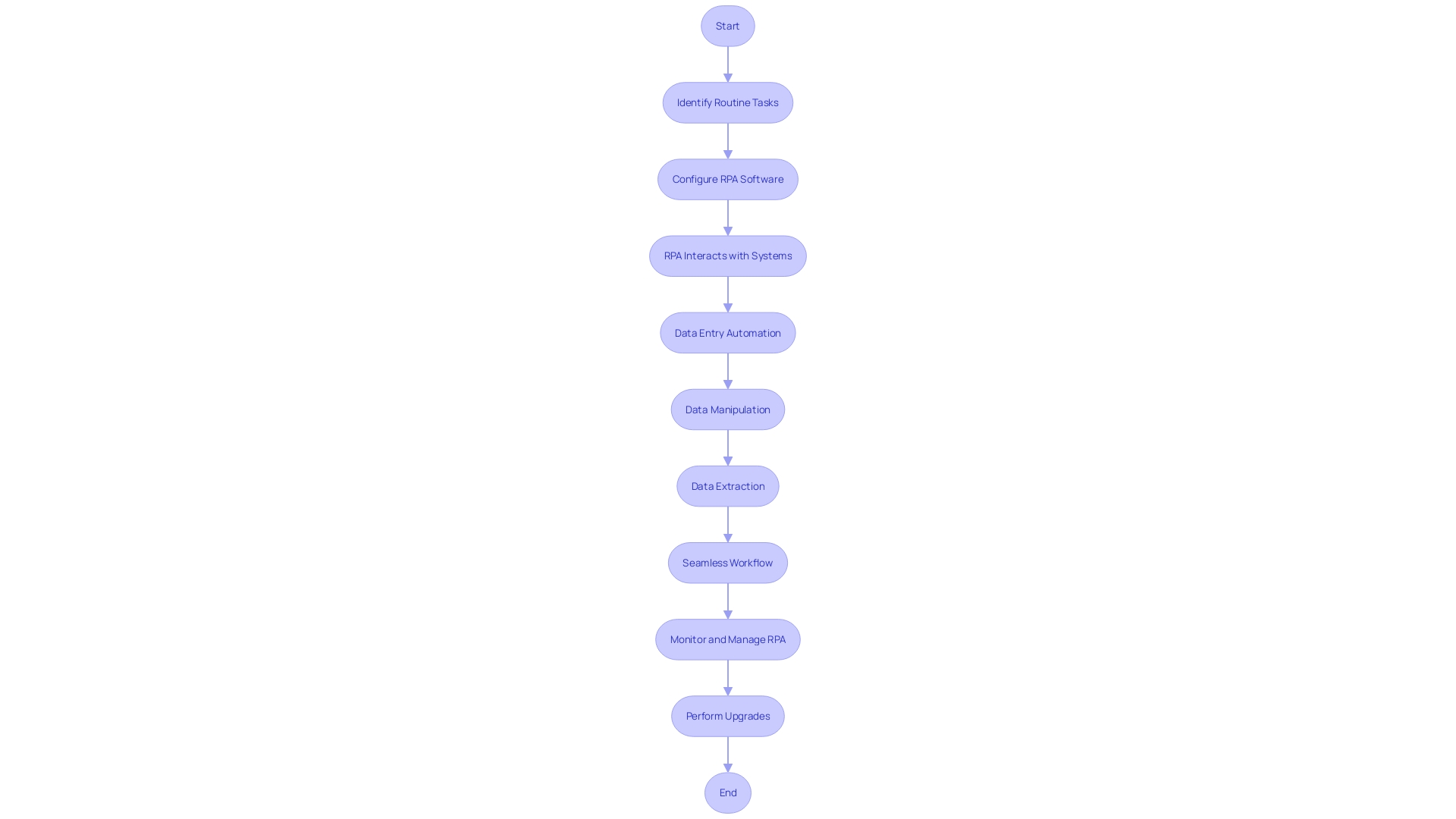
Full Form of RPA Explained
Robotic Process Automation (RPA) leverages the capabilities of software bots to perform activities that are repetitive and based on clear rules. These software applications are adept at emulating human interactions with digital systems to perform a variety of functions such as data entry, document processing, and data extraction. The essence of RPA is not to replace humans but to complement their efforts, enabling them to dedicate time to strategic roles that add greater value. With its roots in task automation and adherence to pre-established rules for operation, RPA is a key player in the modern landscape, particularly where efficiency and productivity are paramount.
A notable example of RPA’s application can be seen in the healthcare sector. For example, the adoption of new digital technologies within a clinical environment often starts with a request form submitted by clinicians to a Digital Service Team. This team conducts a thorough assessment to ensure compliance and suitability of the technology. Through such assessments and the deployment of AI chatbots, RPA is instrumental in easing staff shortages and enhancing patient care.
Moreover, embracing RPA requires a nuanced approach. As the CTO and Co-Founder of Reveille Software notes, automation, throughout its history, has never been a set-and-forget solution. It demands ongoing human oversight for monitoring, management, and improvements. This is equally true for RPA, which, while aiming to elevate efficiency and productivity, necessitates human partnership to maintain stability and adapt to evolving organizational requirements.
Workflow automation, closely related to RPA, leverages technology to streamline complex processes, thereby diminishing the need for manual intervention and reducing the likelihood of human error. It is embraced by enterprises that manage repetitive tasks, such as sending notifications or handling permissions. A study by Zapier reveals that this is a common scenario in smaller enterprises. Furthermore, Process Intelligence offers a strategic advantage by analyzing operational data to identify inefficiencies and predict potential issues before they escalate.
In summary, RPA is a transformative force in various industries, offering a strategic approach to process management. It is a technology that not only accelerates operational workflows but also empowers human resources to focus on more innovative and impactful work.
Key Features of RPA
Robotic Process Automation (RPA) is revolutionizing the way businesses operate by providing advanced tools for automating repetitive and rule-based activities. Leading this innovation are RPA bots, software entities designed to interact with digital systems and carry out activities with precision and efficiency. Here are some of the standout features that make RPA a game-changer for process automation:
-
UI Interaction: Mimicking human interactions with software applications, RPA bots can perform a variety of tasks such as data entry, navigating through interfaces, and clicking buttons, thereby bridging the gap between human users and digital processes.
-
Rule-Based Logic: By following pre-established rules and logic, RPA bots can handle structured data and make decisions, ensuring that activities are carried out consistently and in accordance with set parameters.
-
Scalability: The ability to scale RPA solutions up or down is a testament to their flexibility, allowing organizations to respond to changing demands and expanding workloads by deploying additional bots as needed.
-
Non-intrusive Integration: RPA’s non-invasive approach means it can seamlessly interact with existing systems, reducing the need for complex integrations and facilitating a smoother adoption of automation technologies.
-
Audit Trails and Monitoring: Providing transparency, RPA maintains detailed records of bot activities, which helps with regulatory compliance and provides valuable insights for improving procedures.
As the digital landscape evolves, companies like Coding Crafts are at the vanguard of integrating RPA with other cutting-edge technologies like Blockchain, enhancing security and transparency in automation efforts. This holistic approach to automation represents a leap forward in operational efficiency and opens up a myriad of possibilities for innovation in various industries.
How RPA Works
Robotic Process Automation (RPA) is revolutionizing the way businesses operate by automating manual, rule-based activities. Beginning with the recognition of such activities, the RPA expedition advances through comprehensive process mapping to comprehend the flow and dependencies of each undertaking. Configuring RPA bots involves establishing the rules, instructions, and parameters they’ll adhere to, which is followed by a critical training phase where bots acquire the necessary skills through demonstrations or guided instructions.
Once trained, RPA bots can autonomously execute tasks, interacting with the interfaces of target applications, performing actions, and managing any exceptions based on their configuration. However, the implementation of RPA isn’t a set-it-and-forget-it procedure. Continuous monitoring and maintenance are essential to address issues, fine-tune performance, and adapt to changing business needs.
For instance, within the Department of Electronic & Electrical Engineering, the process of recording attendance and student comments was ripe for RPA implementation. Another example is Lindy, an AI assistant platform that faced the challenge of integrating a network of apps and services to enable task execution. By addressing such challenges with RPA, businesses can streamline operations and focus on strategic initiatives.
Indeed, as the CTO and Co-Founder of Reveille Software pointed out, automation requires ongoing human partnership to ensure stability and achieve improvements in efficiency and productivity. Organizations are encouraged to assess their needs carefully, considering a pilot project and expert partnership for optimal RPA deployment and long-term success. With RPA’s ability to bridge various applications and platforms, it represents the next wave in technology, promising significant impacts on operational efficiency.
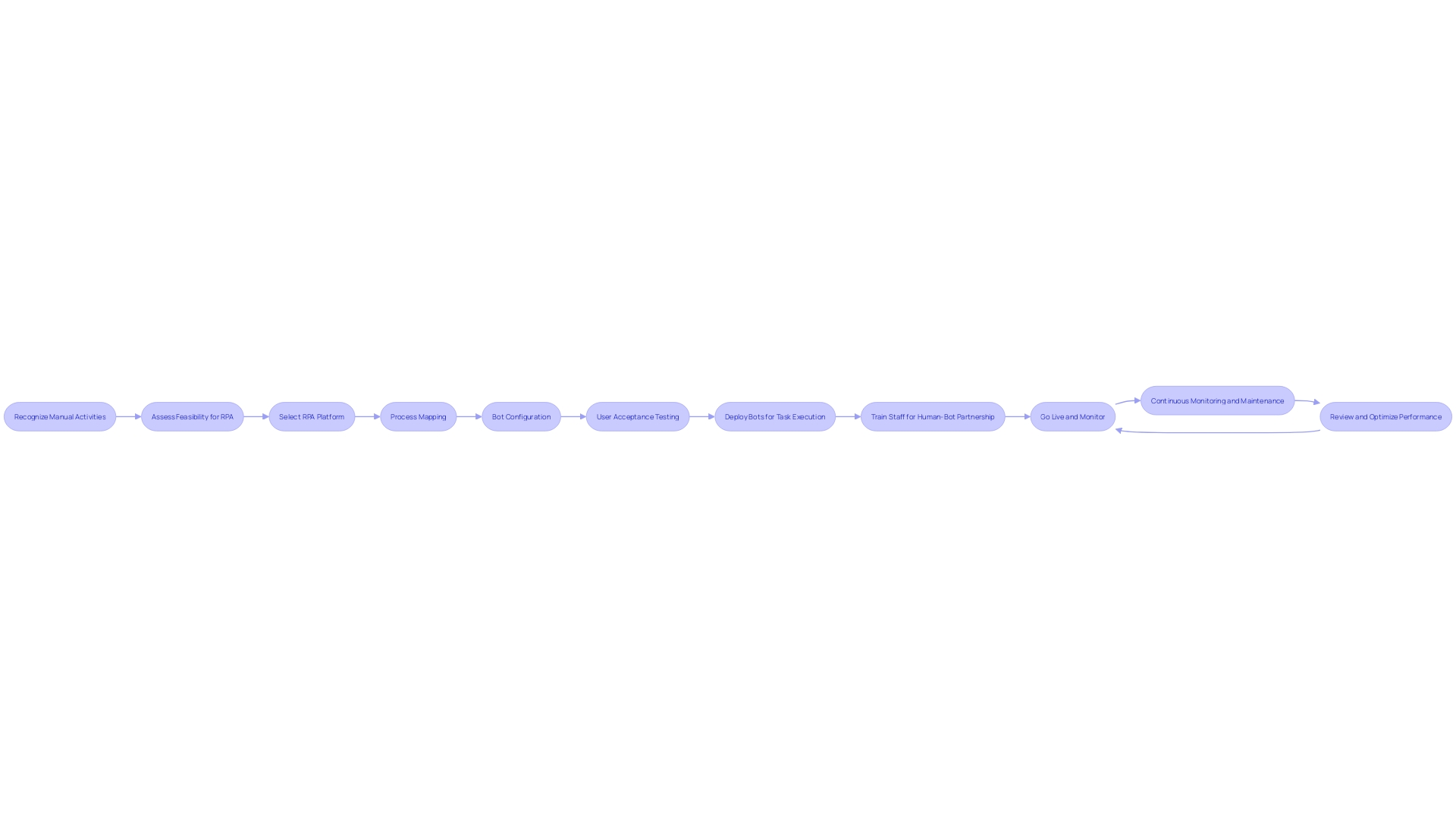
Conclusion
In conclusion, Robotic Process Automation (RPA) is a transformative technology that is revolutionizing operational efficiency in various industries. RPA empowers organizations to automate routine tasks using software robots, freeing up human resources to focus on more strategic initiatives.
RPA seamlessly integrates with existing systems, enhancing business processes without the need for significant infrastructural changes. It connects disparate systems, creating a seamless workflow that liberates employees from monotonous tasks. RPA is not just a trend but a pivotal tool in the modernization of business processes.
Key features of RPA include UI interaction, rule-based logic, scalability, non-intrusive integration, and audit trails and monitoring. RPA bots mimic human interactions with software applications, perform tasks consistently based on predefined rules, and can be scaled up or down to respond to changing demands. RPA’s non-invasive approach allows for seamless integration with existing systems and offers transparency through meticulous record-keeping.
The implementation of RPA involves identifying manual, rule-based tasks, mapping out processes, configuring bots, and training them to execute tasks autonomously. Continuous monitoring and maintenance are crucial for addressing issues and adapting to changing business needs. Organizations are encouraged to carefully assess their needs, consider pilot projects, and seek expert partnerships for optimal RPA deployment and long-term success.
Overall, RPA is empowering businesses to streamline operations, enhance productivity, and focus on strategic initiatives. By embracing RPA, organizations can unlock the full potential of automation and drive significant impacts on operational efficiency.
Introduction
Robotic Process Automation (RPA) is transforming the way businesses operate by automating repetitive tasks through the use of intelligent software robots. With the ability to emulate human interactions with digital systems, these bots execute tasks with remarkable speed and precision, enhancing process efficiency, reducing costs, and boosting productivity. RPA’s versatility is evident across various industries, from eyewear retail to winemaking, where it streamlines operations and improves customer care.
RPA works in tandem with other facets of Artificial Intelligence (AI) to minimize errors and enhance communication fluidity. This article explores the benefits of RPA in enhancing efficiency and accuracy, identifying suitable processes for automation, and providing strategies and best practices for planning and implementing RPA. As businesses strive for operational excellence, RPA emerges as an indispensable tool in their arsenal of modern business strategy.
Understanding RPA: Definition and Context
Robotic Process Automation, commonly known as RPA, is revolutionizing the way businesses operate by empowering them with the ability to automate mundane, repetitive tasks through the use of intelligent software robots, or bots. These bots are adept at emulating human interactions with digital systems and applications, thereby executing tasks with remarkable speed and precision. The increase in RPA adoption is due to its significant impact on improving efficiency, reducing operational costs, and greatly enhancing overall productivity.
The versatility of RPA is evidenced by its applications in various industries. For instance, Specsavers, the renowned eyewear retailer, utilizes RPA to navigate the intricacies of its vast supply chain and the unique demands of optometry, where traditional machinery often lacks modern connectivity. This enhances early identification of potential health issues, thus enriching customer care. Similarly, St. James Winery leverages RPA to maintain its position as Missouri’s premier and most decorated winery, streamlining processes to ensure consistent quality across competitions.
Further solidifying the relevance of RPA, the OODA network of international experts integrates it into a suite of services that include intelligence analysis, strategic planning, and crisis management for corporations and governments worldwide. This reflects the extensive range of RPA, extending beyond basic task execution to encompass strategic operations.
RPA’s role is not isolated; it works in tandem with other facets of Artificial Intelligence (AI), such as machine learning and natural language processing, to heighten operational intelligence. By automating workflows, companies are able to minimize human error and enhance communication fluidity, which is crucial in sectors where precision and timeliness are paramount. The technology is not just about replacing human effort but augmenting it with enhanced reporting, analytics, and a relentless drive for continuous improvement.
As the CTO and Co-Founder of Reveille Software puts it, automation has always been about enhancing productivity and convenience, and RPA, with its software bots, is the latest evolution in this ongoing narrative of innovation. It’s a collaboration between human oversight and robotic efficiency that drives organizations forward into a more effective future. The landscape of RPA is dynamic, and as it evolves, it promises to redefine the operational capabilities of industries, making it an indispensable tool in the arsenal of modern commercial strategy.
Benefits of RPA: Enhancing Efficiency and Accuracy
Robotic Process Automation (RPA) represents a significant advancement in the journey of innovation that started with the earliest mechanization tools like water wheels and windmills. Today, RPA represents a sophisticated form of business automation that leverages software bots to execute repetitive, rule-based tasks across various industries, effectively transforming operational efficiency. These software applications, or ‘bots’, are capable of mimicking human actions on computer systems, performing tasks such as data entry, data extraction, and document processing with precision and reliability.
By integrating RPA, organizations can delegate mundane activities to virtual assistants, much like the AI assistant Lindy, which has been designed to handle a plethora of tasks across multiple applications. This not only optimizes operations but also greatly minimizes the risk of human error, thereby improving accuracy in critical procedures. For example, companies like Delivery Hero have employed RPA to tackle recurring operational bottlenecks such as the account recovery procedure, which previously took 35 minutes per incident, resulting in a significant decrease in productivity with 800 such occurrences every month.
Furthermore, advancements in AI technology, as demonstrated by the Korea Institute of Machinery and Materials, are now being integrated into manufacturing processes, showcasing the dynamic applicability of RPA in various workflows. The technology’s rules-based nature ensures that tasks are executed consistently, and when coupled with continuous improvement practices, it paves the way for a future where hyperautomation becomes a strategic imperative for large organizations. RPA’s implementation in industries like Coding Crafts extends even further, incorporating blockchain development services to add layers of security and transparency.
The strategic deployment of RPA can yield significant benefits, as automating product data management and bill of materials has shown to reduce product development costs and accelerate time to market. In a world where efficiency and rapid innovation are crucial, RPA enables businesses to concentrate on high-value opportunities, promoting a vision where the future of work is consistently optimized and enhanced by intelligent technology.

Identifying Processes for RPA: Assessing Feasibility and Suitability
When contemplating the adoption of Robotic Process Automation (RPA), it is crucial to carefully assess the procedures within your company that are ready for mechanization. Factors like the rule-based nature of the procedure, the complexity, and the volume of transactions are crucial in determining a procedure’s appropriateness for RPA.
For example, Surrey County Council’s adoption of automation to manage services for over a million residents highlights the significance of choosing the appropriate procedures to enhance service delivery and efficiency. Similarly, the NHS’s procedure for vetting new digital technology requests emphasizes the necessity of understanding existing capabilities before introducing new automated solutions.
Furthermore, the importance of AI and Machine Learning in improving business operations cannot be denied. A systematic review by Mostafa Abbasi and colleagues reveals the transformative impact of these technologies in process management. As technology advances, organizations like Coding Crafts are at the forefront by integrating Blockchain with RPA, offering a new dimension of security and transparency.
In terms of privacy and ethical considerations, the deployment of RPA must be handled with care. Reports on the regulation of AI in autonomous weapons and the potential misuse of algorithms in rent pricing emphasize the wider implications of technology and the need for responsible implementation.
Statistical insights from data science surveys, such as the one conducted by Eric Siegel, Ph.D., inform us about the prevalent challenges and future directions in deploying machine learning, which is closely related to RPA initiatives. These insights assist in evaluating the preparedness of an organization’s procedures for successful RPA implementation.
Planning and Implementing RPA: Strategies and Best Practices
Embarking on the journey of integrating Robotic Process Automation (RPA) into your organization’s framework is akin to navigating a complex digital transformation. It begins with a detailed plan for mapping processes, which is a phase where organizations identify and outline the particular workflows that can gain advantages from mechanization. Drawing from the experiences of M&T Bank, which faced the challenges of digital transformation in the banking sector, it’s clear that ensuring the security and compliance of the software is paramount. This proactive action is not only about avoiding costly obstacles; it’s about ensuring the integration enhances the foundation of your operations.
The deployment of RPA bots should be approached with a similar mindset to that of the NHS Digital Service Team—evaluating the appropriateness, security, and compliance of the technology. It’s about digging deeper to understand the technology and its potential overlaps with existing solutions, thereby avoiding redundancy and leveraging existing digital assets.
Change management, a critical facet of RPA integration, involves more than just implementing new technology. It means fostering a culture of collaboration, much like the ethos at Rackspace Technology, where the respect for individual preferences and roles in the broader system contributes to a harmonious and efficient environment.
In terms of best practices, it’s essential to consider the real-world applications of RPA. For instance, automating tasks with AI and developing process models for intelligent automation are not about replacing human labor but enhancing human-machine collaboration. The journey to a successful RPA implementation is a constant cycle of evaluation and improvement, ensuring the bots adapt to the evolving needs of services—a principle that has been reiterated in recent news about the dynamic nature of manufacturing systems.
Supporting this approach with industry statistics, experts like Dr. Evan Shellshear emphasize almost two decades of adapting AI tools across various industries, underscoring the importance of continuous refinement in the face of diverse applications. Moreover, the survey of data science and analytics professionals, as reported by Eric Siegel, Ph.D., highlights the multifaceted challenges and future directions in the field, including those pertinent to RPA deployment.
Ultimately, every step of planning and implementing RPA is an opportunity to reinforce the operational bedrock of your organization. It’s about ensuring that each RPA bot is not just a standalone solution but an integral part of a system that operates with the precision and efficiency your business strives for. As the Robotics & Automation Awards approach, the industry’s focus on innovation serves as a reminder of the continuous drive toward operational excellence that RPA embodies.
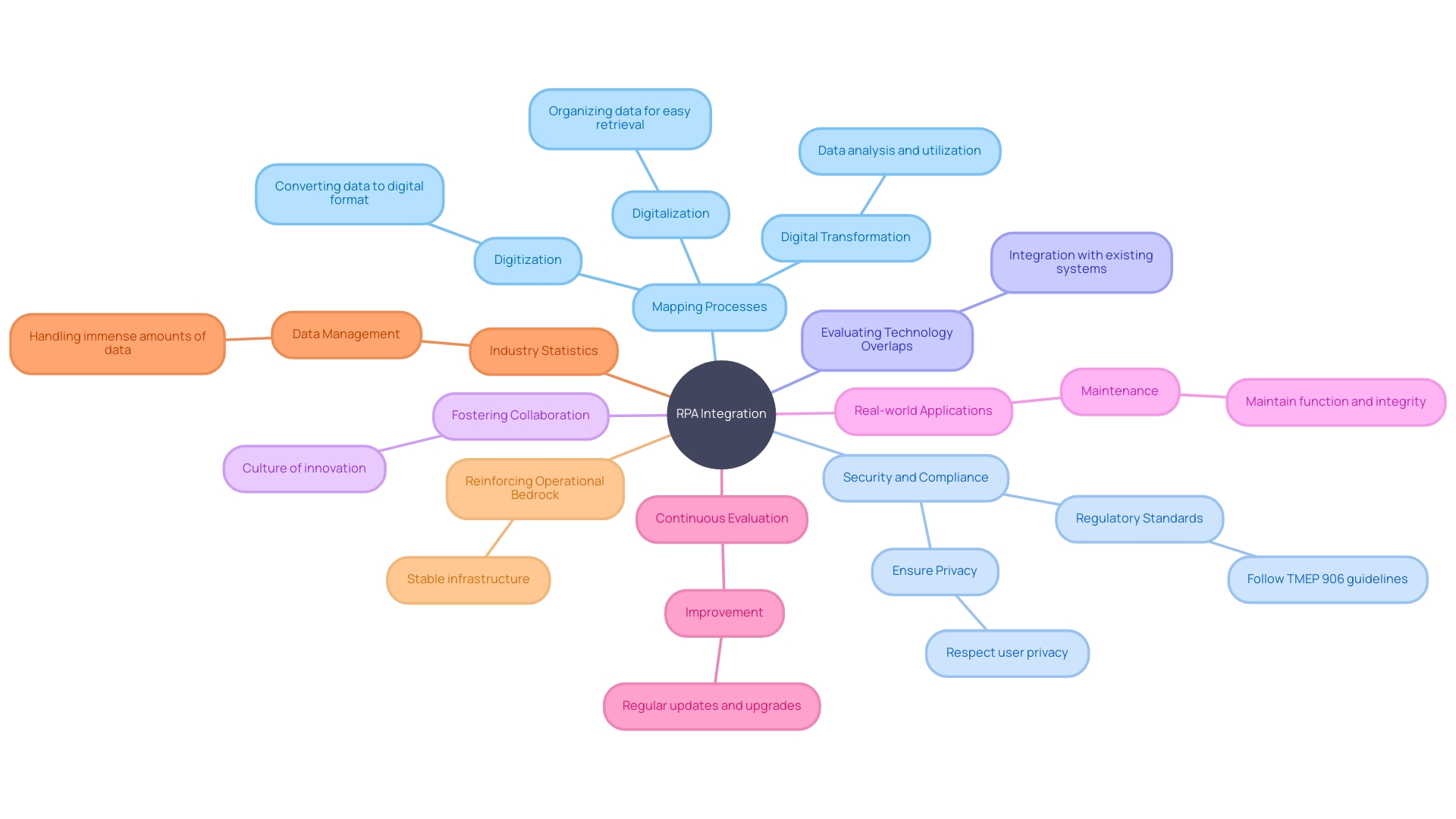
Conclusion
In conclusion, Robotic Process Automation (RPA) is a transformative tool that enhances operational efficiency by automating tasks and improving accuracy. It streamlines processes, reduces costs, and boosts productivity across industries.
RPA works alongside other AI technologies to minimize errors and improve communication, enabling organizations to focus on high-value opportunities and accelerate innovation. When implementing RPA, it is crucial to identify suitable processes based on their rule-based nature, complexity, and volume of transactions, while also considering privacy and ethical considerations.
Planning and implementing RPA require a strategic approach, including process mapping and evaluating the appropriateness, security, and compliance of the technology. Change management and fostering a collaborative culture are critical for successful integration.
Continuous evaluation and improvement are key to a successful RPA implementation. The bots must adapt to evolving service needs and align with industry trends. Industry statistics and insights emphasize the importance of continuous refinement and adaptation.
In conclusion, RPA is an indispensable tool that reinforces operational excellence. It combines human oversight and robotic efficiency to drive businesses towards enhanced productivity and success. As RPA evolves, it will continue to redefine the operational capabilities of industries and become an essential component of modern business strategy.
Introduction
Robotic Process Automation (RPA) is revolutionizing the Business Intelligence (BI) landscape, empowering organizations to streamline operations, improve data accuracy, and optimize services. The integration of RPA with cutting-edge technologies like AI and ML is propelling industries towards rapid digital transformation. In 2024, businesses are embracing agility, innovation, and a customer-focused approach, investing in digital tools that showcase tangible value.
RPA is not limited to industrial settings but is also making its mark in service industries, demonstrating its versatility and growing acceptance. The concept of hyperautomation, which combines RPA with AI, ML, and NLP, is reshaping business operations, unlocking deeper insights, and revolutionizing end-to-end processes. Tailoring RPA to industry needs is a strategic enabler for organizations to refine their operational blueprint and amplify customer satisfaction.
Real-world case studies highlight the transformative power of RPA in BI, particularly in the logistics and supply chain sector. By automating data analytics and leveraging BI for strategic planning, businesses can make informed decisions and stay competitive in today’s fast-evolving market.
Gartner’s Perspective on RPA: Definition and Market Trends
Robotic Process Automation (RPA) is revolutionizing the Business Intelligence (BI) landscape, with software robots or ‘bots’ now performing tasks that were once manual and time-consuming. These advancements are streamlining operations, improving the accuracy of data, and liberating human talent for higher-level strategic roles. Surrey County Council, an organization with a rich history and a mission to enhance local lives, has embraced automation to optimize services for over a million residents. By establishing a precise baseline of asset health, organizations can sidestep inefficiencies and align maintenance efforts with real needs, rather than guesswork.
The interplay of RPA with cutting-edge technologies like AI and ML is propelling industries towards rapid digital transformation. As Daryl Plummer, VP at Gartner, notes, AI-assisted software development is accelerating developer productivity, enabling them to focus on strategic tasks such as application design. The intelligence embedded in these applications adapts and learns, paving the way for more efficient and reliable automated workflows, ultimately enriching user experiences.
The path of digital transformation in 2024 is marked by a shift towards agility, innovation, and a customer-focused approach. It’s a cultural pivot that encourages organizations to defy convention and embrace experimentation. Automating key elements like product data management (PDM) and the bill of materials (BOM) not only cuts costs but also speeds up product deployment, underlining the significance of investing in digital R&D tools that showcase tangible value.
Robots are no longer limited to industrial settings but are making their mark in other sectors as well, as observed in the Canadian market for robotics. The use of service robots ranges from personal assistance to professional support, demonstrating the versatility and growing acceptance of RPA across different sectors. Tungsten Automation’s rebranding reflects this evolution, underscoring their commitment to supporting their clients’ ongoing transformation endeavors with steadfast dedication and innovative solutions.
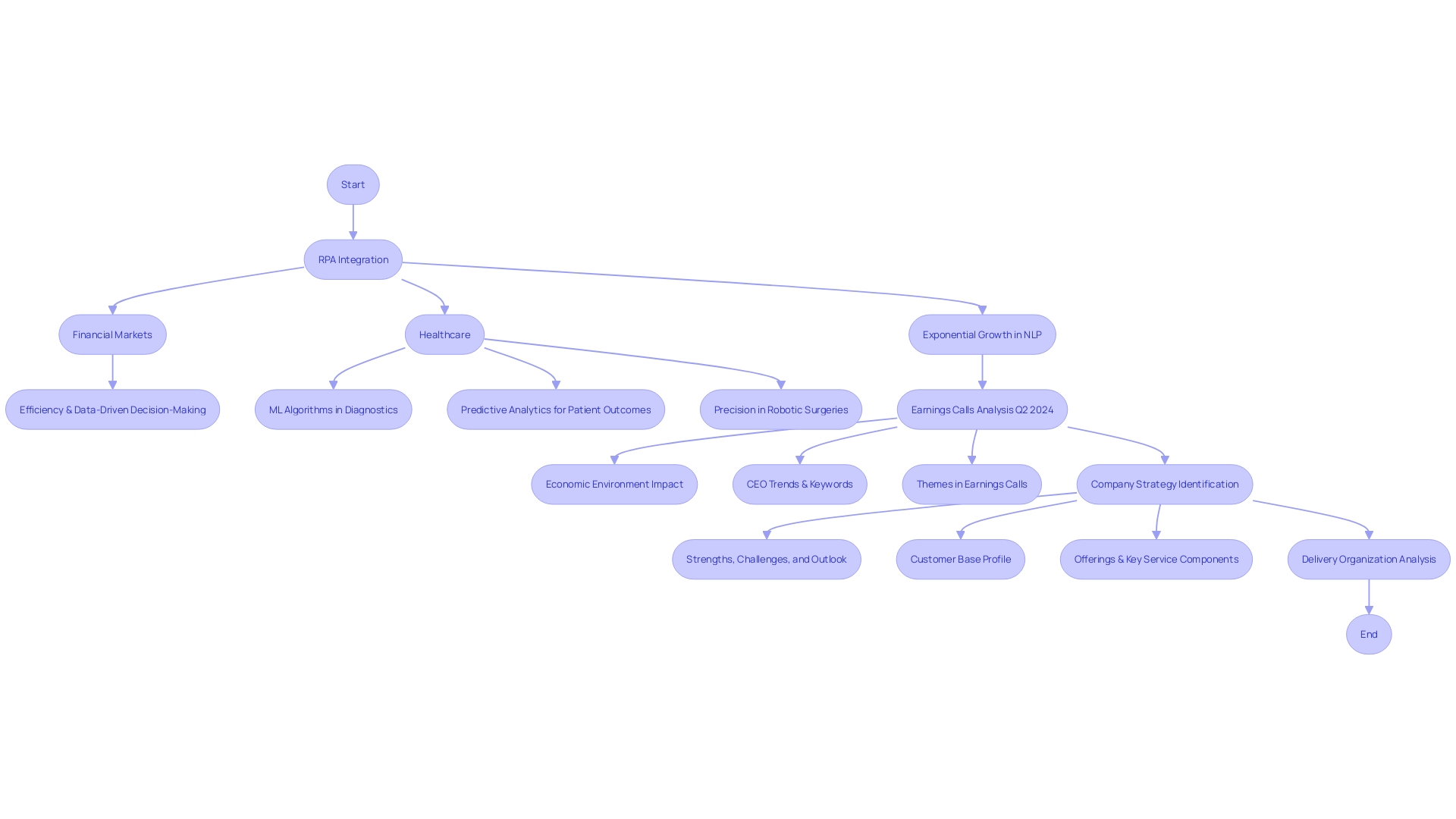
The Integration of RPA and Business Intelligence: Unlocking Deeper Insights
- Robotic Process Automation (RPA) is revolutionizing the way we understand and leverage Business Intelligence (BI). By enabling automated information gathering and processing, we bypass the risk of human error, paving the way for accurate, trust-worthy insights.
A prime example of RPA’s impact is seen in retail, where a prominent company automated the assimilation and examination of customer information. This real-time insight into consumer behaviors allowed for more effective marketing strategies and enhanced customer contentment.
Besides extracting insights, the fusion of RPA with BI tools serves the crucial role of visualization and reporting. The advent of automated report generation not only conserves time and resources but also empowers stakeholders with immediate, precise data.
In the wider context of today’s rapidly evolving tech scene, where firms are shifting to agile, value-driven operations, the combination of RPA and BI remains a cornerstone for innovation and efficiency.
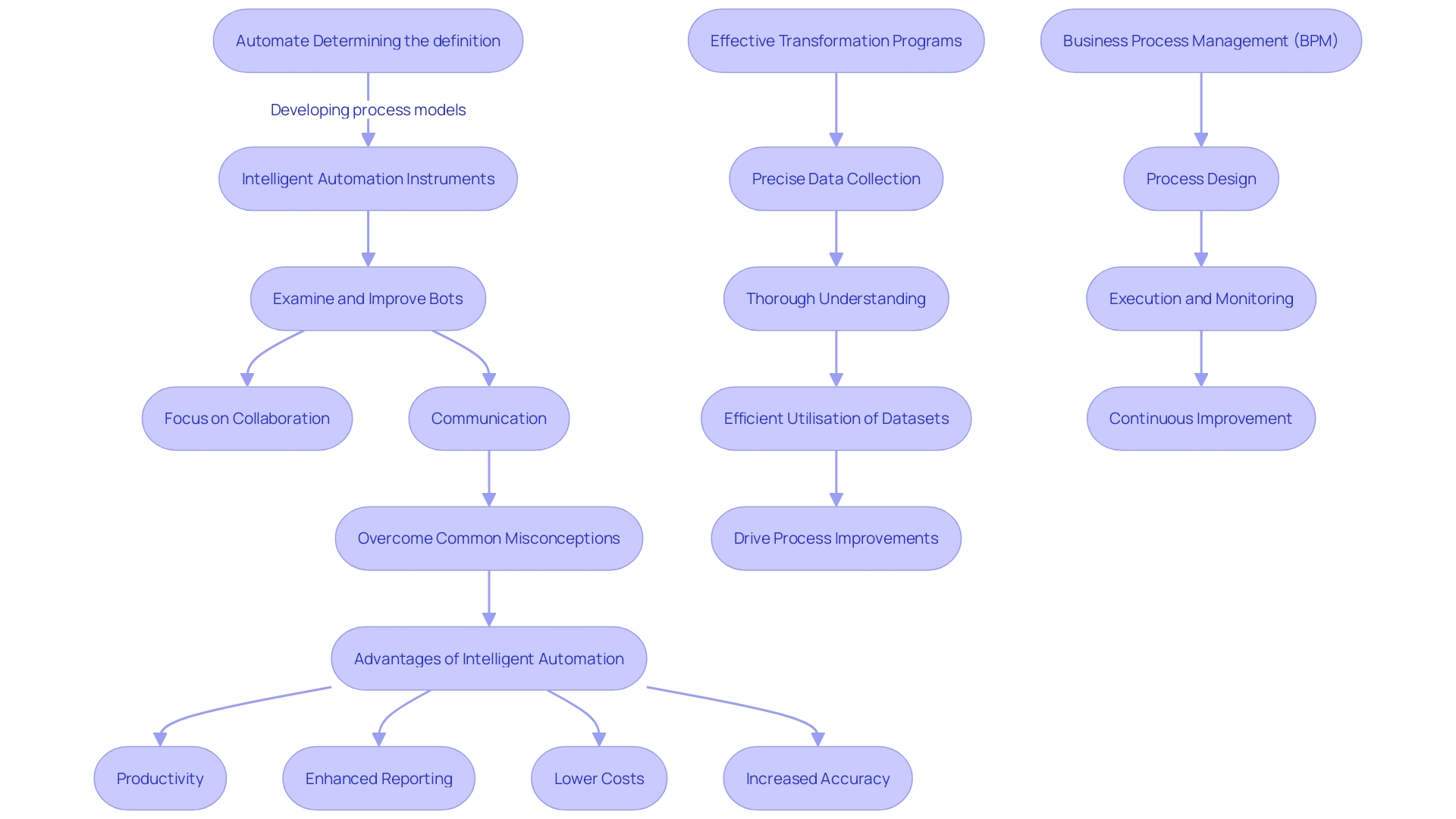
Hyperautomation: The Future of RPA and Business Intelligence
Hyperautomation, a cutting-edge concept introduced by Gartner, is revolutionizing the way businesses operate by integrating Robotic Process Automation (RPA) with artificial intelligence (AI), machine learning (ML), and Natural Language Processing (NLP). This synergy of technologies propels enterprises into a new realm of efficiency, where complex business processes are both automated and intelligent. Specifically, in the realm of RPA and Business Intelligence (BI), hyperautomation enables organizations to access vast oceans of unstructured information, extracting invaluable insights. AI and ML algorithms are used to analyze and comprehend text-based information such as customer feedback, social media commentary, and comprehensive market reports, unveiling trends and sentiments that influence strategic decisions.
Hyperautomation goes beyond simple task automation; it encompasses entire end-to-end processes, handling both structured and unstructured tasks with finesse. Take, for instance, a healthcare provider that implemented hyperautomation to streamline patient information extraction from medical records, optimize insurance claims processing, and craft personalized treatment plans drawing from a wealth of historical information. The outcomes were remarkable: substantial time and cost efficiencies, elevated accuracy in data handling, and, most importantly, significantly improved patient care.
In practice, hyperautomation can be observed in various applications such as developing advanced chatbots for customer support, enhancing the order-to-cash process in financial operations, and fine-tuning diagnostic testing in medical laboratories. These practical instances highlight the transformative capability of hyperautomation, where it not only speeds up current processes but also introduces novel approaches to provide assistance. As organizations keep on investigating and executing these cutting-edge advancements, the scene of business activities is being reshaped, clearing a path for remarkable degrees of profitability and dynamic capability.
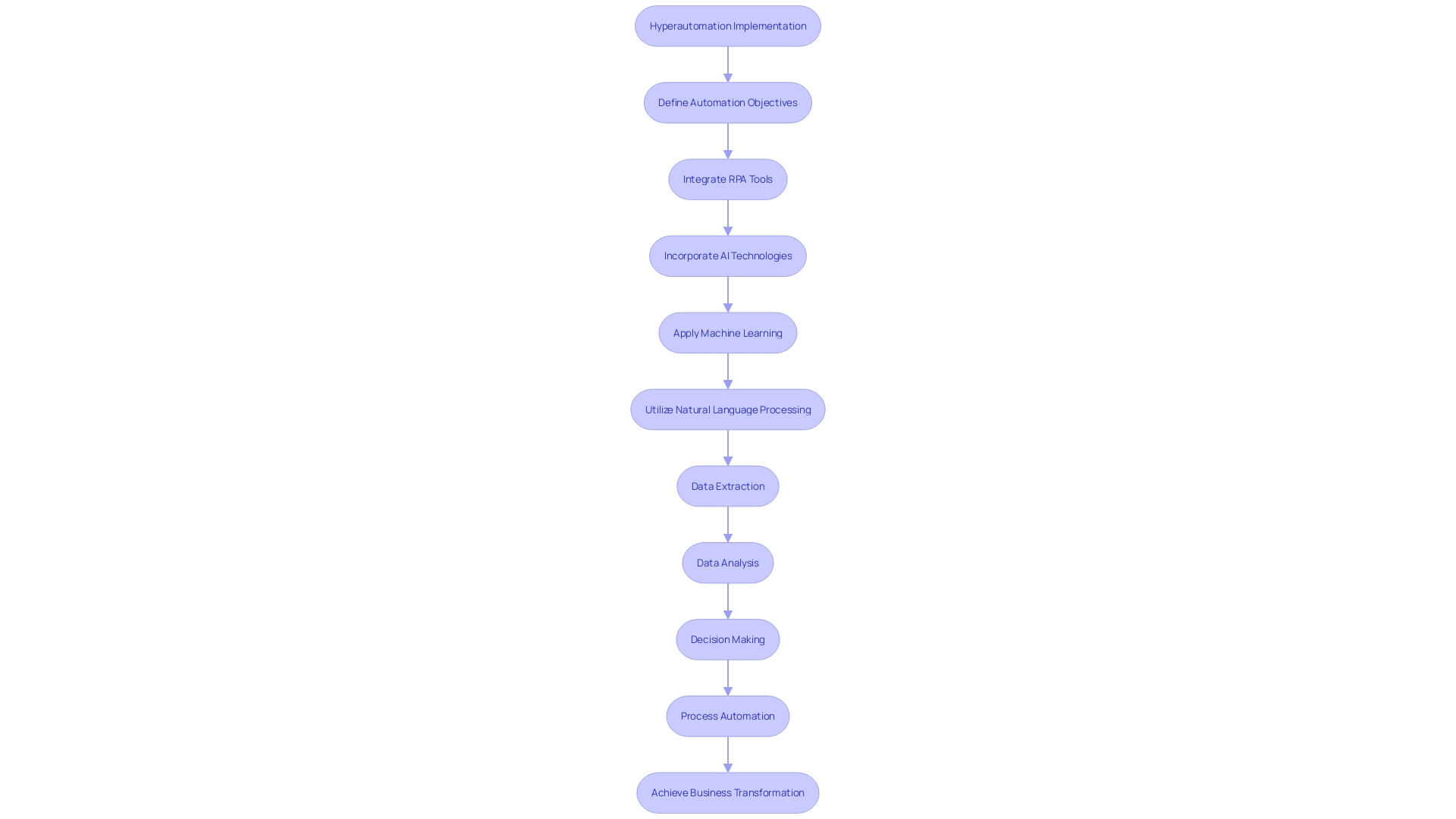
Vertical-Specific Solutions: Tailoring RPA to Industry Needs
Embracing Robotic Process Automation (RPA) is more than a technological leap; it’s a strategic enabler for industries to refine their operational blueprint. Banks, for instance, have revolutionized customer interactions by automating onboarding and loan processing, which minimizes errors and delivers swifter services, directly amplifying customer gratification. This reflects the digital transformation observed in financial institutions such as TBC Bank and M&T Bank, where the incorporation of advanced tools guarantees compliance with strict security and regulatory standards, maintaining the smooth operation of this sector.
Manufacturing is another domain reaping RPA’s benefits, where precision in inventory management and supply chain processes can be significantly enhanced. By substituting manual inspection with automated quality checks, manufacturers cut down lead times and bolster productivity, echoing the transformative impact of automation in technology-intensive operations. This is not just theory; statistics show that 94% of companies handle repetitive tasks, with 90% of knowledge workers reporting job improvement due to automation, and 66% citing productivity boosts.
Moreover, companies such as Rackspace emphasize the significance of customizing technological solutions, guaranteeing that they match user preferences and privacy standards. As industries immerse themselves in the digital era, RPA stands as a pillar for reimagining business intelligence, fostering innovative practices, and propelling customer experiences to new heights. It is through these tailored, industry-specific RPA solutions that businesses can navigate market competition and secure their position at the vanguard of their respective fields.

Case Study: Real-World Applications of RPA in Business Intelligence
The integration of Robotic Process Automation (RPA) into Business Intelligence (BI) systems is transforming the logistics sector, as evidenced by the journey of Norway’s leading discount chain, Europris. After partnering with Swisslog for the automation of its central warehouse, Europris has seen its operations evolve over three phases, reaping the benefits of automation in supply chain management.
The utilization of RPA in BI enables companies to automate complex information collection processes, which previously involved labor-intensive tasks such as email processing, document handling, and invoice reconciliation. With RPA, these processes are streamlined, leading to enhanced productivity and reduced operational costs and risks. Intelligent Document Processing (IDP), a subset of RPA, has been particularly transformative in the transportation and logistics industry by improving efficiency and offering a strong Return on Investment (ROI).
BI techniques, such as data mining and performance benchmarking, offer profound insights into operations, markets, and customer behavior, enabling data-driven decision-making. For instance, logistics service provider Rhenus UK offers bespoke logistics solutions, leveraging BI to optimize transport chains by air, land, and sea, and enhance the overall supply chain.
The significance of this technological synergy is highlighted by a McKinsey survey, which found that despite challenging market conditions, logistics leaders are increasingly investing in technology to address their operational challenges. This trend underscores the urgency for companies to adopt advanced BI and RPA solutions to stay competitive.
In summary, by automating data analytics and leveraging BI for strategic planning, organizations can not only identify inefficiencies but also predict future demands, making informed decisions that propel their businesses forward. The experience of Europris and other industry leaders serves as a testament to the transformative power of RPA when integrated with Business Intelligence in the logistics and supply chain sector.
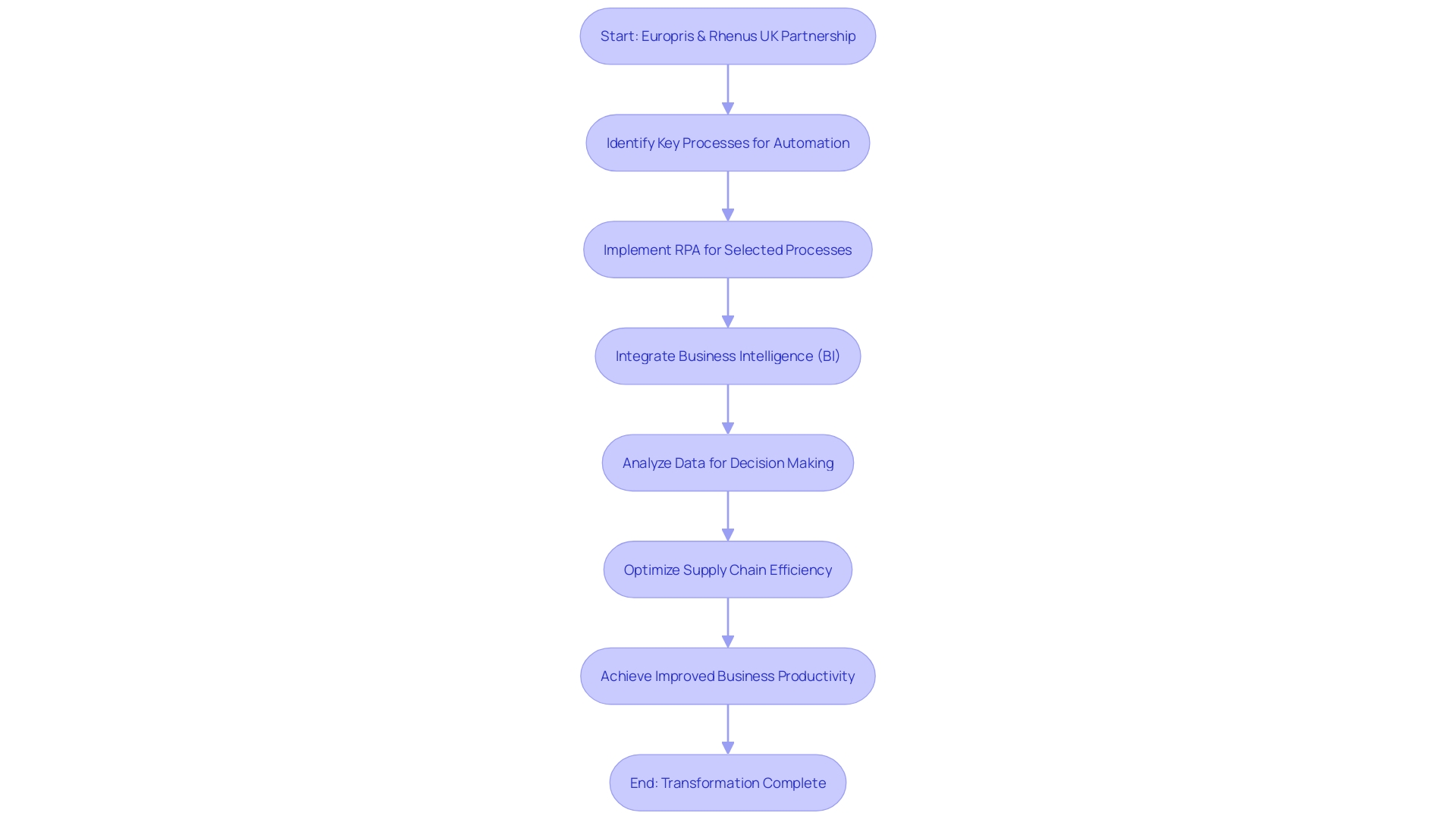
Conclusion
In conclusion, RPA is revolutionizing the BI landscape by streamlining operations, improving data accuracy, and optimizing services. The integration of RPA with AI and ML is propelling industries towards rapid digital transformation and enabling organizations to refine their operational blueprint. Real-world case studies in the logistics and supply chain sector highlight the transformative power of RPA in BI, allowing businesses to make informed decisions and stay competitive in today’s fast-evolving market.
Embracing RPA is a strategic enabler for industries to revolutionize customer interactions, enhance precision in inventory management, and improve productivity. By tailoring RPA to industry needs, organizations can amplify customer satisfaction and foster innovative practices. The concept of hyperautomation, which combines RPA with AI, ML, and NLP, is reshaping business operations, unlocking deeper insights, and revolutionizing end-to-end processes.
In summary, the integration of RPA and BI is unlocking deeper insights and transforming industries. By adopting these advanced technologies, businesses can reshape their operations, drive productivity, and make data-driven decisions. The future of RPA and BI is bright, and organizations that embrace these technologies will stay ahead in today’s competitive market.
Introduction
Robotic Process Automation (RPA) is revolutionizing the way organizations approach mundane and rule-based tasks. By deploying software robots, or ‘bots’, that mimic human interactions with digital systems, RPA automates functions such as data entry, data extraction, and document processing. This not only enhances operational efficiency but also minimizes human error, leading to a more streamlined and error-free work environment.
In industries ranging from banking to healthcare to hospitality, RPA has demonstrated its scalability and effectiveness in improving processes and outcomes. However, it’s important to note that RPA requires ongoing management and human oversight to ensure stability and effectiveness. With the majority of companies engaging in repetitive tasks that can benefit from automation, RPA stands as a cornerstone in the digitalization journey, empowering organizations to optimize processes and harness new technological capabilities.
What is RPA Software?
Robotic Process Automation (RPA) represents a transformative leap in the way organizations tackle mundane and rule-based tasks. This technology deploys software robots, or ‘bots’, that imitate interactions with digital systems, performing a wide array of functions across different applications and interfaces. The core of RPA lies in its ability to automate tasks such as data entry, data extraction, and document processing, which are typically executed by workers. By integrating RPA, companies are not only enhancing their operational efficiency but also minimizing the scope of human error, leading to a more streamlined and error-free work environment.
Illustratively, M&T Bank’s embrace of digital transformation, which is crucial in an industry with stringent regulatory and security demands, highlights the necessity for technologies like RPA that can uphold high-quality standards in software code. Surrey County Council’s initiatives, aimed at improving services for over a million residents, demonstrate the scalability of RPA and its role in enhancing both citizen and employee experiences. Likewise, the hospitality sector, as proven by the partnership between Louvre Hotels Group and RobosizeME, has experienced significant operational enhancements and time savings with the adoption of automated processes in rate code management.
As mentioned by the CTO and Co-Founder of Reveille Software, the process of automating tasks is not something that can be implemented and forgotten; it requires ongoing management and oversight from individuals to ensure stability and effectiveness. This is particularly relevant when considering the integration of RPA within complex systems such as Epic and Cerner in healthcare, which require secure and up-to-date patient information management. The significant revenue growth and productivity enhancements reported in Forrester’s Total Economic Impact study further validate the tangible benefits of intelligent technological assistance when complemented by human collaboration. This human-digital worker synergy is paramount to maximizing results and achieving a compound annual growth rate of 5.4%.
In a wider view, 94% of companies participate in repetitive tasks that can gain from mechanization, and it has already enhanced jobs for 90% of knowledge workers. With 83% of IT leaders confirming that workflow automation is essential for digital transformation, RPA stands as a cornerstone in the digitalization journey, enabling companies to harness new technological capabilities and optimize processes from inception to completion.
How Does RPA Software Work?
Robotic Process Automation (RPA) is transforming the way organizations handle their operations. At its core, RPA utilizes software ‘bots’ to automate repetitive and rule-based tasks that traditionally require manual intervention. By emulating interactions with various software applications, these bots are capable of executing a wide range of activities, such as logging into systems, extracting and managing data, populating forms, and performing calculations. What sets RPA apart is its ability to integrate with email or chat interfaces, enabling bots to communicate and collaborate with human users and even other bots.
These advanced software bots are not only programmable to operate autonomously on a set schedule but can also be activated through specific events or manual initiation. This flexibility allows them to adapt to the dynamic needs of businesses. By automating repetitive tasks, companies experience significant enhancements in efficiency and productivity. Moreover, in industries such as healthcare, where legacy systems pose significant security risks, RPA offers a secure and compliant solution for adopting new digital technologies. In fact, approximately 73% of healthcare organizations have been reported to rely on legacy systems, which RPA can help modernize while maintaining high security standards.
The implications of RPA extend beyond simple task; they also play a pivotal role in enhancing customer and employee experiences. For example, Surrey County Council, which offers vital services to more than a million residents, utilizes technology to enhance service delivery and operational outcomes. Moreover, the incorporation of RPA with generative AI offers the potential of significantly expanding the range of applications for the technology, as mentioned by prominent figures in the field. This synergy can lead to a reduction in operating costs and a significant increase in productivity, providing companies with a competitive edge. The strategic implementation of RPA, backed by intelligent automation, has demonstrated a revenue growth of 73% of overall Net Present Value (NPV) benefit and a 5.4% compound annual growth rate (CAGR) over three years for those who adopt these technologies.
Key Benefits of RPA Software
Robotic Process Automation (RPA) has transformed the technological landscape, offering companies a powerful tool to enhance operational efficiency. By automating mundane and repetitive tasks, RPA liberates employees, allowing them to dedicate their time to more complex, strategic initiatives that add value to the business. For instance, healthcare providers have seen substantial advancements in patient care management and data handling by integrating RPA with electronic medical record systems like Epic and Cerner.
The accuracy and reliability of data are improved due to the precision of RPA, which greatly reduces the risk of error caused by individuals. In the banking sector, where M&T Bank has embraced digital transformation, maintaining high standards of data security and regulatory compliance is paramount. RPA plays a critical role in ensuring these standards are consistently met while streamlining operations.
Cost savings are another compelling benefit of RPA. By optimizing the use of human resources and enhancing productivity, organizations can achieve a more economical operational model. Research, like the Total Economic Impact methodology created by Forrester Research, have demonstrated that firms investing in intelligent technology can anticipate a revenue growth of 73% of overall net present value (NPV) benefit and a 5.4% compound annual growth rate (CAGR) over three years.
Moreover, RPA’s scalability is a vital feature for businesses like TBC Bank, which has evolved from a local business center to Georgia’s leading financial institution. As companies expand or face changes in demand, RPA enables them to effortlessly adapt their operational processes without significant disruptions.
Despite the clear advantages, it’s important to remember that automation isn’t a ‘set it and forget it’ solution. As the CTO and Co-Founder of Reveille Software points out, monitoring, management, and upgrades are essential to maintain stability and performance. Nonetheless, RPA represents a significant stride forward in the pursuit of operational excellence, driving efficiency and fostering innovation across various industries.
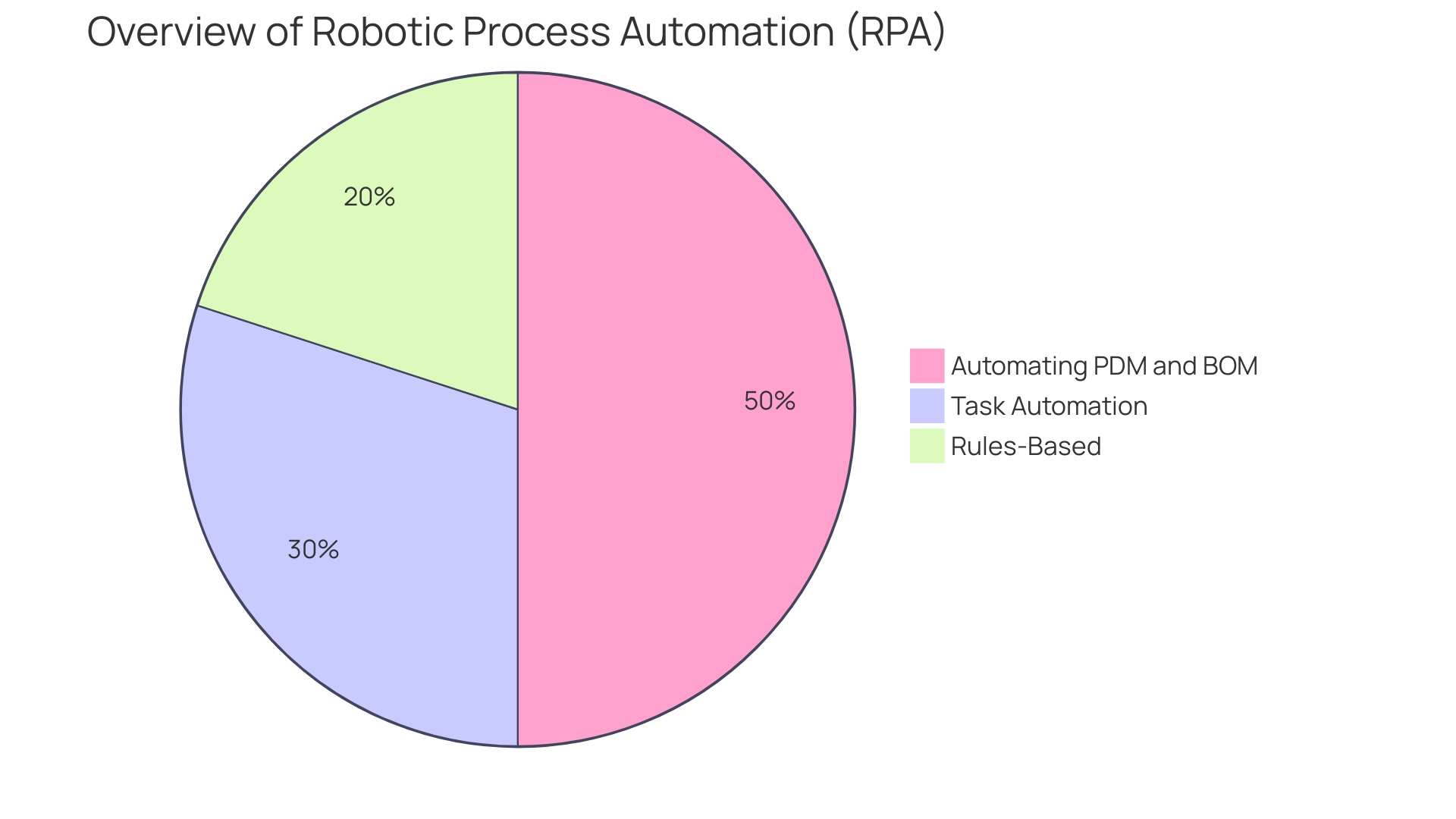
Elements of an RPA Framework
Robotic Process Automation (RPA) stands as a transformative force in the landscape of operational efficiency. To exploit its complete potential, companies must create a detailed structure that addresses several crucial factors. This starts with pinpointing and selecting the right processes, a task that mirrors the intricate assessments conducted by healthcare institutions when adopting digital technologies. For instance, the NHS’s discovery of existing but unrecognized technologies within its trust underscores the importance of thorough evaluation before introducing new solutions.
While designing RPA solutions, we must also build a framework and operating model that align with the goals of the company. Governance and oversight provide the necessary checks and balances to ensure compliance and proper alignment with business objectives, akin to the governance structures found in healthcare systems like those managed by LGI Healthcare Solutions and Boston Software Systems.
Moreover, the operating model for RPA programs must be scalable and adaptable, reflecting the innovative approaches in retail such as the checkout-free stores enabled by Zippin technology at Dublin Airport. This model demonstrates the smooth integration of automation in daily operations, a concept that is becoming more and more important as companies aim to improve both customer and employee experiences.
In summary, when each element of the RPA implementation framework is meticulously addressed, organizations can lay a solid groundwork for their RPA initiatives, akin to the methodical approach Surrey County Council takes in servicing its community. This foundation not only supports the effective deployment of RPA technology but also catalyzes the realization of its myriad benefits, from operational improvements to heightened service standards.
Conclusion
In conclusion, Robotic Process Automation (RPA) is revolutionizing organizations by automating mundane tasks and improving operational efficiency. By deploying software robots that mimic human interactions with digital systems, RPA streamlines processes such as data entry and document processing, reducing human error and creating a more efficient work environment.
RPA has proven its scalability and effectiveness in various industries, including banking, healthcare, and hospitality. Companies like M&T Bank, Surrey County Council, and Louvre Hotels Group have experienced significant operational improvements and time savings through automation.
However, it’s important to note that RPA requires ongoing management and human oversight for stability and effectiveness. Collaboration between humans and bots is crucial for maximizing results and achieving growth.
With the majority of companies engaging in repetitive tasks that can benefit from automation, RPA is a cornerstone in the digitalization journey. It empowers organizations to optimize processes, harness new technological capabilities, and enhance operational efficiency.
Integrating RPA allows organizations to free up employees from mundane tasks, reduce the risk of human error, and achieve cost savings. RPA’s scalability enables businesses to adjust their automation efforts as needed without major disruptions.
To harness the full potential of RPA, organizations must establish a meticulous framework. This includes selecting the right processes, aligning with business objectives, implementing governance and oversight, and creating a scalable and adaptable operating model.
In summary, RPA offers practical solutions for organizations seeking to enhance operational efficiency. With ongoing management and human oversight, RPA can drive efficiency, foster innovation, and optimize processes across industries. It is a transformative technology that empowers organizations to embrace digitalization and unlock new possibilities for growth.
Introduction
AI chatbots have become essential tools for enhancing user interaction, offering efficient and personalized experiences in various industries. There are two primary types of AI chatbots: rule-based systems and machine learning-driven ones. Rule-based chatbots rely on established rules and triggers to provide precise responses, while machine learning chatbots continuously learn and evolve, adapting to the nuances of human language.
It’s crucial to understand these types when planning a chatbot strategy, as they have different strengths for different use cases. Implementing AI chatbots can lead to impressive returns on investment, automating up to 70% of customer requests and improving operational efficiency. As AI chatbots continue to evolve, they have the potential to act as sophisticated assistants, driving long-term product strategies and operational goals.
Understanding AI Chatbot Types
AI, indispensable tools for improving user engagement, are available in two main types: rule-based systems and those powered by machine learning. Rule-based automated conversational systems are like meticulous librarians, following a strict categorization system to respond to queries. They rely on a series of established rules and triggers, which when activated, produce the appropriate responses. This approach is precise, but its rigidity can be a limitation for complex or nuanced interactions.
On the other side of the spectrum, we have machine learning-based chatbots. These are the marvels of the automated conversational system realm, constantly acquiring knowledge and progressing. They utilize robust AI algorithms to digest vast amounts of data, learning and refining their conversation skills over time. This enables a more natural interaction with users, as the AI assistant can comprehend and adjust to the intricacies of human language.
The difference between these two categories is important when devising your conversational agent approach. For example, a healthcare provider might use a rule-based automated system for scheduling appointments, where clear-cut rules are sufficient. But they might switch to a machine learning AI for patient interactions, where understanding context and history can significantly enhance care quality.
Real-world applications showcase the capabilities of AI virtual assistants. Consider the NHS’s digital service team’s adoption process for new technologies. They start with a thorough assessment to ensure security and compliance, similar to how a machine learning chatbot would evaluate conversations to provide compliant and relevant responses.
Implementing AI conversational agents can also be a strategic move for businesses, offering an impressive return on investment (ROI). Statistics show that AI can automate up to 70% of customer requests, a significant efficiency boost. Retail companies, for example, have seen over 63% of them utilizing AI to improve customer service.
As AI virtual assistants advance, they are increasingly capable of acting as sophisticated ‘co-pilots’ in various industries, providing invaluable assistance that aligns with long-term product strategies and operational goals. The journey of integrating AI into your operations might start with identifying the right type of chatbot for your needs, but it extends far into the strategic planning and continuous improvement of the service.
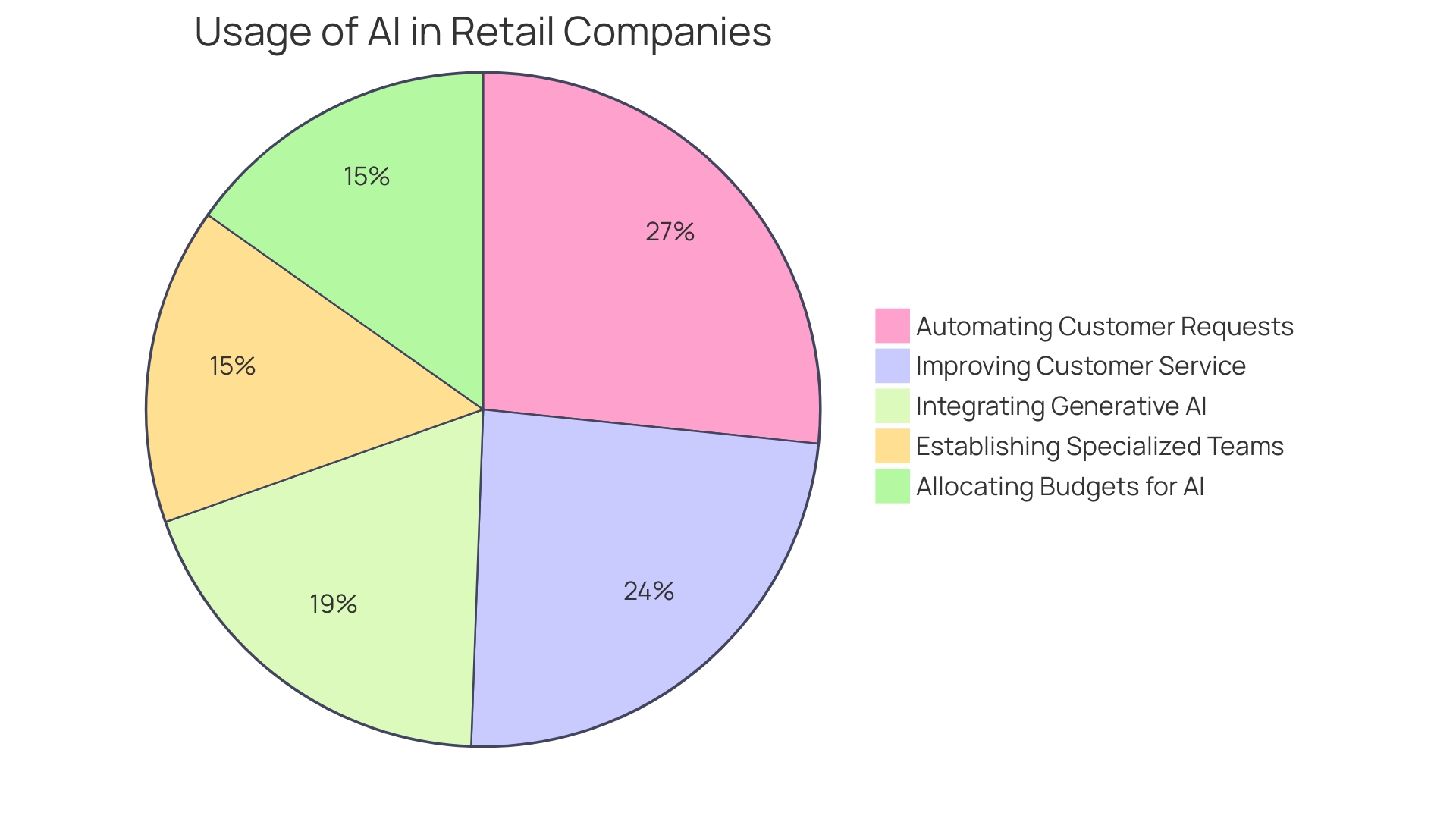
Key Components of AI Chatbots
Artificial intelligence conversational agents are created with a sophisticated combination of elements that together allow them to facilitate an engaging interactive experience. At the core of these systems lies the Natural Language Processing (NLP) module, a critical feature that equips chatbots with the ability to comprehend and process human language as it is naturally spoken or typed. This allows for a nuanced understanding of user queries and statements. Complementing the NLP is the Dialogue Management module, which plays a pivotal role in guiding the conversation flow, ensuring that responses are contextually relevant and coherent with the ongoing interaction.
In addition to these, conversational agents are anchored by an extensive Knowledge Base, a repository of information that the virtual assistant accesses to deliver accurate and informative responses. This database is continually updated and expanded to encompass a wide range of topics and data. The user interface, often the most visible component of a conversational AI, offers a user-friendly platform for engagement, allowing for seamless communication between the user and the virtual assistant.
The incorporation of these elements is demonstrated in the healthcare industry, where AI virtual assistants are increasingly used to facilitate inquiries for new digital technologies. For instance, in the NHS, the Digital Service Team employs a rigorous assessment process, aided by an AI chatbot, to evaluate whether requested technologies are secure, appropriate, and compliant. This use case highlights the practicality of AI-powered virtual assistants in managing complex workflows and improving operational efficiency.
Recent progress in AI, like the release of Chat GPT-4 by OpenAI, has continued to expand the limits of what conversational agents can accomplish. With an expanded input capacity and a growing developer ecosystem, these systems are now capable of handling intricate tasks that were previously the domain of humans. The advent of such technologies demands careful consideration of ethical implications, including the privacy of individuals and transparency in AI engagements, ensuring individuals are aware that they are communicating with a machine.
As AI virtual assistants continue to evolve, they hold the potential to not only enhance user interaction but also to significantly impact the operational efficiency and decision-making processes within various industries.
Step 1: Identify the Type of Chatbot
Selecting the optimal AI conversational agent for your company relies on comprehending your main objectives. Whether it’s slashing call center volumes by half or curbing shopping cart abandonment by 10%, these targets can translate into significant financial gains. For instance, in the energy sector, companies like Enefit have leveraged chatbots to navigate vast document bases, cutting down the time employees spend searching for information from an average of 18 minutes to a mere instant response. Similarly, in healthcare, digital request forms streamline technology adoption, ensuring secure, compliant solutions are in place. With the appropriate tools, an AI conversational agent can be a strategic asset, aligning with long-term product strategies and offering a measurable return on investment, especially when integrated with technologies like blockchain for secure, multilingual interactions, as observed with tech innovators like Exfluency. When devising your conversational AI strategy, contemplate these innovative approaches and evaluate your ROI to guarantee your virtual assistant becomes as valuable as any other corporate asset.
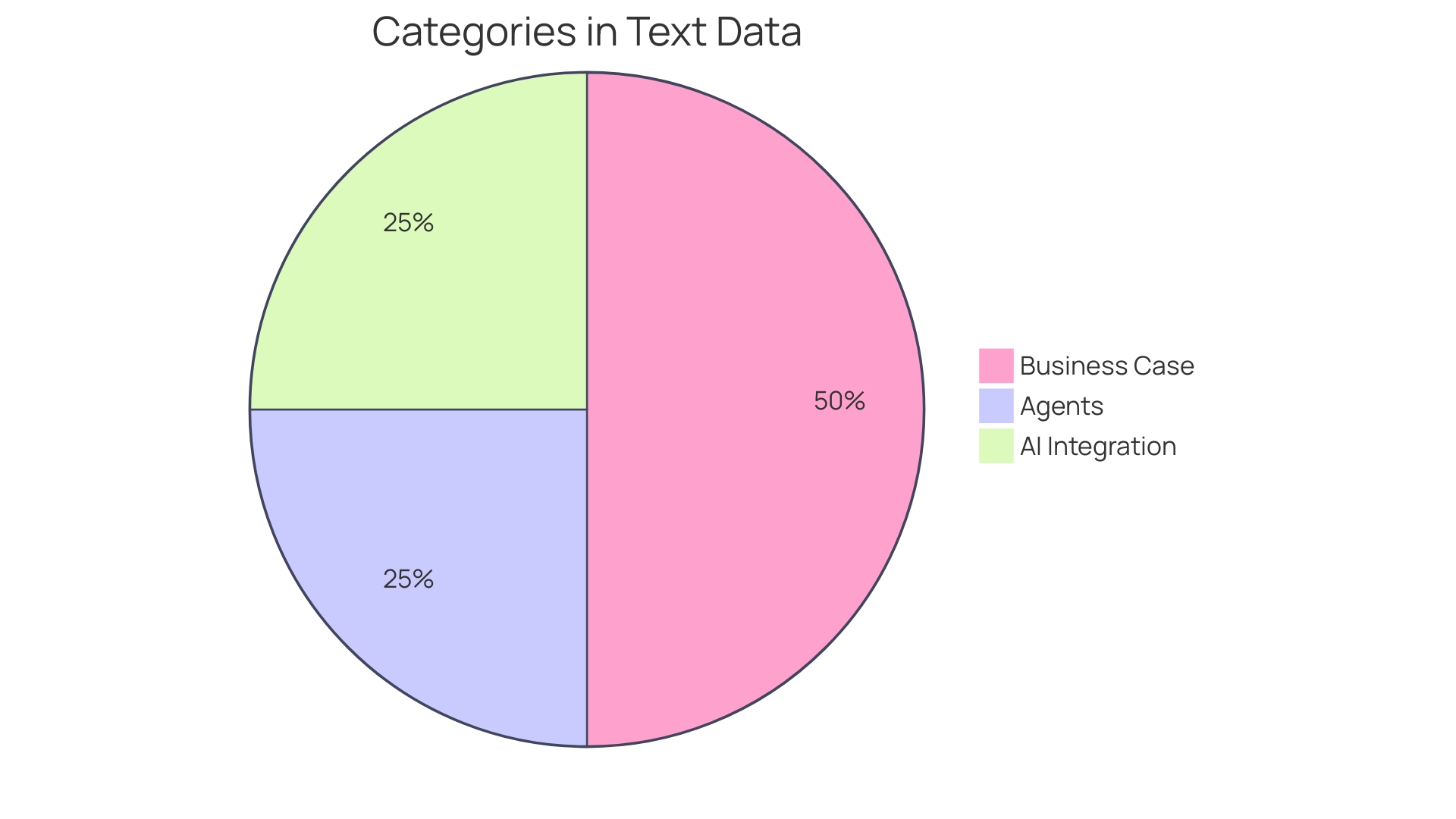
Step 2: Set Goals and Objectives
When venturing into the realm of intelligent virtual assistant development, identifying the specific functions and responsibilities your AI assistant will undertake is crucial. It’s not just about programming a conversational AI; it’s about sculpting a digital assistant that integrates seamlessly with your business model and enhances user interaction. For instance, in the case of Enefit, a large-scale energy company operating in various markets, the implementation of an automated messaging system significantly enhanced the swiftness and effectiveness of internal document retrieval – reducing the average search time from 18 minutes to just seconds.
To harness similar efficiency, begin with a broad vision and then zoom in on the particularities. Which tasks should it handle? Is it for customer service, internal communications, or perhaps a mix of both? By setting clear goals, such as reducing response times or providing round-the-clock support, your automated messaging system becomes a strategic asset. Remember, the key is in the details – it’s about creating a tool tailored to your unique operational needs.
Utilize quantifiable results to monitor the performance of the automated conversational agent. Are customers finding the answers they need? How has the automated messaging system affected the workload of your customer service team? These metrics serve as a beacon, guiding the ongoing improvement of your conversational AI system. Obtain ideas from the advancements in AI conversation software technology, wherein new models recall prior engagements, thus providing customized experiences to individuals – a characteristic that is not merely an extravagant addition but a vital component in customer contentment.
Incorporating these objectives and measures into the development process means that, upon deployment, your AI assistant will not just be another piece of software, but a dynamic, evolving member of your team dedicated to enhancing the individual’s experience. This strategic method for developing conversational agents guarantees that your investment yields returns in improved engagement and operational effectiveness.
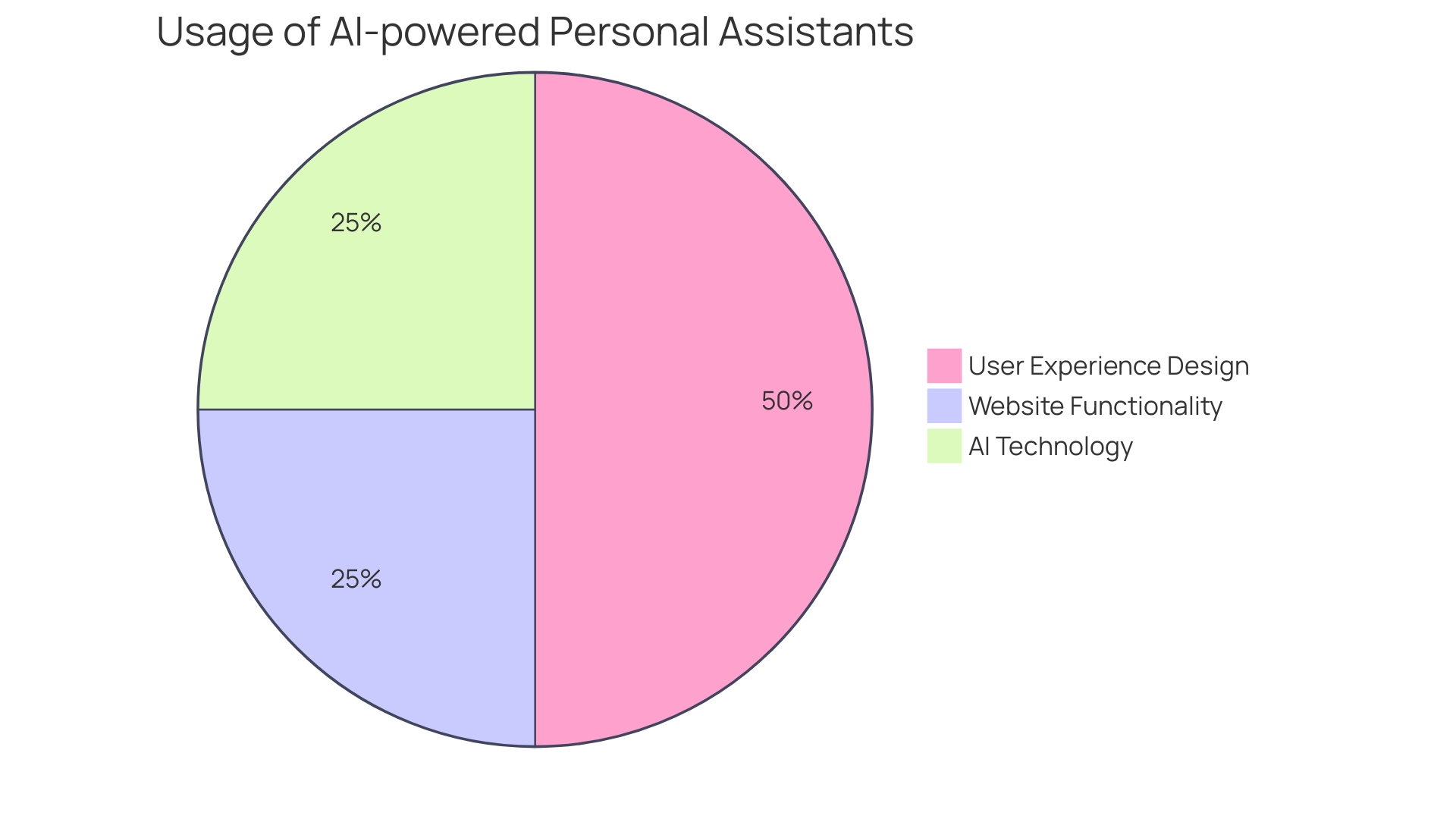
Step 3: Design the Conversation Flow
Crafting the conversational architecture of an AI chatbot is akin to choreographing a dance. It’s about skillfully designing the intricate steps – the give and take of dialogue between individual and bot – that result in a seamless and intuitive interaction. To accomplish this, one must start with broad, open-ended questions to assess the individual’s intention. As the conversation progresses, the bot’s responses become more precise, honing in on the user’s specific needs. This dynamic and continuous refinement of the dialogue is essential for fostering a natural flow of communication.
Recent developments in the field of AI have highlighted the significance of large language models (LLMs) in enhancing conversational AI. By utilizing LLMs, we can guarantee that conversational agents are not only multilingual but also provided with high-quality, immutable data. This approach guarantees that the chatbot’s responses are informed by accurate and relevant information. Moreover, with the integration of AI, organizations are keen to measure the return on investment (ROI) and strategize for the long-term adaptation of AI into their products.
The art of prompt engineering cannot be overstated in this process. It requires a deep understanding of how AI interprets information and the ability to iteratively refine prompts to achieve more sophisticated outputs. As highlighted in a recent session by the founder of ChatbotsLife, the world of conversational AI is rapidly evolving with the advent of LLMs, necessitating an understanding of both their capabilities and limitations to build next-generation AI bots.
In line with Gartner’s predictions, the deployment of chatbots has surged, becoming a key component of customer communication strategies. Their ability to automate conversations and engage with customers in real-time has been instrumental in driving this growth. As we look to the future, the focus is on nurturing this symbiotic relationship between AI and human input, ensuring that both are leveraged to their fullest potential to deliver an unparalleled user experience.
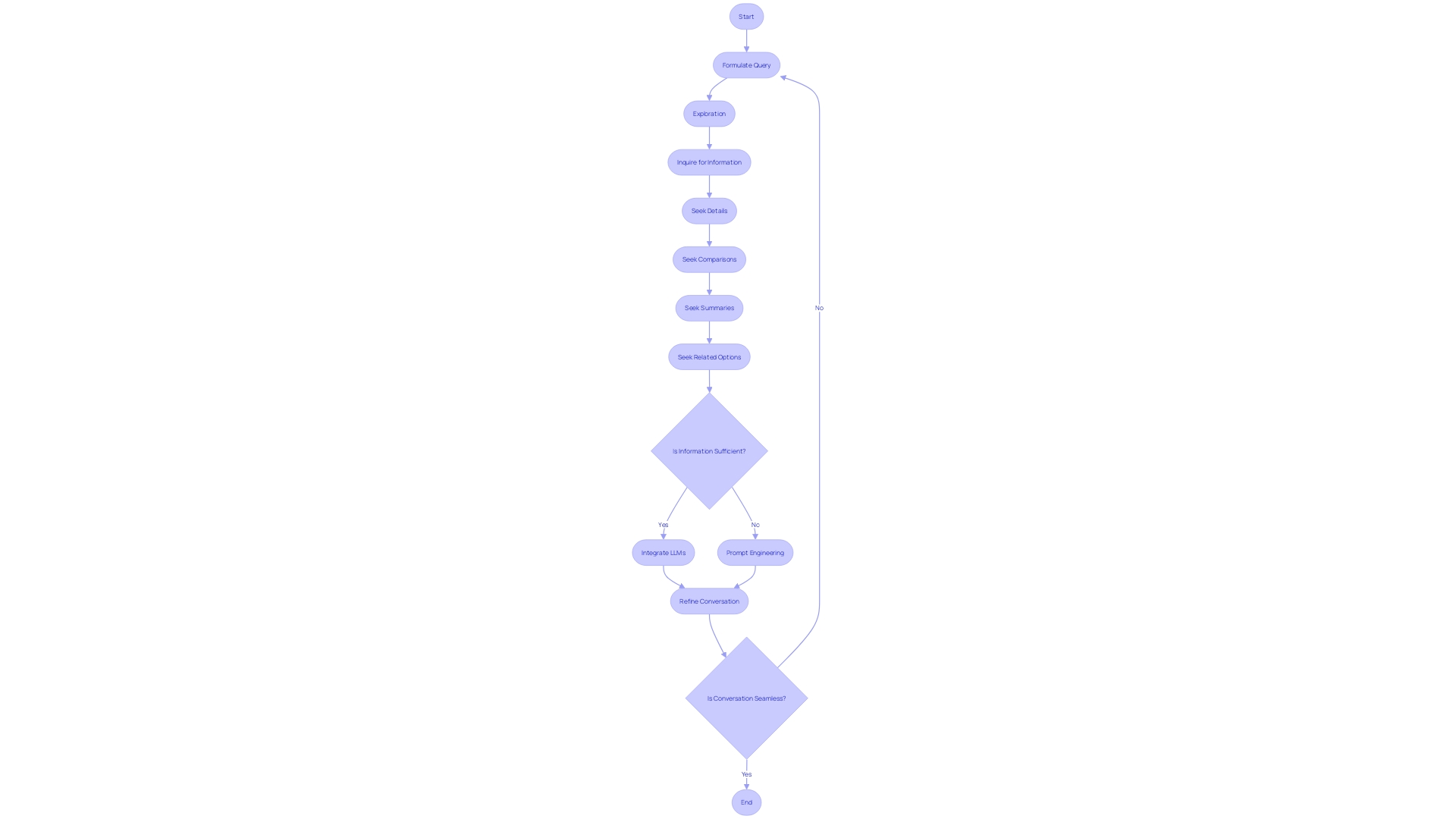
Step 4: Choose the Right AI Chatbot Development Platform or Framework
Choosing the best AI development framework is a crucial choice that can greatly impact the effectiveness and efficiency of deploying your virtual assistant. To make an informed choice, it’s crucial to evaluate platforms based on their usability, feature set, integration options, and scalability potential. Widely recognized platforms in this space include Dialogflow, IBM Watson Assistant, and Microsoft Bot Framework. When assessing these platforms, consider your project’s specific requirements to ensure a perfect fit.
To simplify your decision-making procedure, begin by recognizing the main objective and aims for your conversational AI, including the categories of engagements it will manage. This clarity will help you identify the crucial characteristics and functionalities required for your conversational agent. For example, if your goal is to improve interaction on an e-commerce application across multiple platforms, you’ll need a framework that can seamlessly integrate with both web and mobile environments.
Another essential factor is scalability. As your user base expands, your conversational AI should be able to grow with it. Choose a platform that not only meets your current needs but can also scale to accommodate future demands. This is where evolution qualities, such as maintainability and extensibility, become vital. A scalable platform ensures that as your business grows, your automated messaging system can evolve without requiring a complete overhaul.
Moreover, consider the execution qualities of the platform, like security and usability. These aspects are crucial as they affect the performance of the conversational AI system during operation. With the rise of synthetic data and the need for GDPR and CCPA compliance, selecting a platform that emphasizes data privacy and secure handling of information is imperative.
In today’s competitive environment, where AI is quickly being embraced to enhance productivity and enhance customer interaction, postponing the deployment of an AI-powered conversational agent might lead to overlooked possibilities. Harnessing AI technologies not only simplifies routine tasks but also allows your team to concentrate on strategic initiatives, improving productivity and customer satisfaction.
Finally, integration with existing systems and data sources is essential. A platform that enables effortless connection with your databases and supports multilingual capabilities can offer a more personalized and efficient experience for individuals. Keep in mind, the platform you select will be the foundation of how your conversational AI application engages with users, so it’s crucial to choose one that strongly supports your goals while also being flexible enough to meet future requirements.
Step 5: Training the Chatbot
Enhancing the Ai’s capabilities is a crucial aspect in its development. This process entails equipping the bot with a set of example dialogues to simulate potential interactions. It also requires careful feedback and refinement to improve the conversational capabilities of the AI assistant. For chatbots powered by machine learning, a substantial training dataset is vital to their learning process, whereas rule-based chatbots depend on a comprehensive framework of predefined regulations and patterns. It is crucial to continuously oversee and evaluate the performance of the AI assistant throughout the training phase to verify its progressive learning and efficiency in response. Utilizing the most recent innovations in technology, like blockchain, guarantees the integrity and confidentiality of the training data, enhancing the AI assistant with high-quality input. Furthermore, engaging with the AI assistant using precise prompts can refine its understanding and response accuracy, leading to an improved experience tailored to specific industries or operational needs. By incorporating these tactics, AI chatbots can greatly enhance interaction and function as a powerful tool to mitigate staff shortages and improve patient care, as observed in contemporary healthcare settings such as the NHS.
Step 6: Quality Testing
The convergence of AI development and quality assurance is a dynamic and critical domain, where meticulous testing is not just an option but a necessity. Ensuring that your AI conversational system consistently delivers accurate and relevant answers to a variety of inquiries relies on rigorous testing protocols. The procedure should include two crucial forms of assessments: operational testing, which examines the AI assistant’s ability in performing specific duties, and interaction testing, which gauges the AI assistant’s overall efficiency and user-friendliness for the final individual. By integrating findings from these tests, developers can make informed enhancements, refining the AI assistant to meet and exceed user expectations.
In the context of Enefit, a leading energy provider, the deployment of an AI conversational agent was a transformative strategy to streamline internal information retrieval, which traditionally took employees an average of 18 minutes and sometimes over an hour. Such initiatives underscore the importance of AI in improving operational efficiencies. Furthermore, as seen in healthcare, Ai’s potential extends to clinician support and patient care, emphasizing the need for reliable and unbiased AI solutions. In the broader landscape, Ai’s role is rapidly evolving, with industry experts like Ryan Daws and companies like Microsoft recognizing the value of AI expertise in driving technological advancements.
However, with the growing reliance on large language models (LLMs) comes the increased responsibility to identify when and how these systems may fail. This is echoed by Harmonic’s efforts to develop A.I. technologies that self-validate to prevent misinformation. The practice of prompt testing is becoming increasingly crucial, as highlighted by the shift from traditional test-driven development (TDD) to this new paradigm, ensuring chatbots are meticulously vetted before deployment.
Reflecting on the World Quality Report’s 15-year journey, it’s clear that the landscape of quality engineering and testing has evolved significantly, with a notable shift towards agile methodologies and cloud services. The focus on automation and cost-efficiency in the post-financial crisis period has resulted in the industrialization of software development and QA tasks, paving the way for the advanced AI solutions seen today. These advancements serve as a guiding light for companies navigating the integration of AI into their operations, providing a roadmap for creating high-quality, efficient interfaces.
Step 7: Deployment and Ongoing Maintenance
After careful development and thorough testing, an AI conversational agent transitions into the deployment phase, where it becomes accessible to users. The deployment strategy must be tailored to the audience’s preferences, whether through a website, social media messenger, or mobile application. For example, Enefit, a large Baltic energy company, saw the need to streamline access to internal documents for its 5000 employees. The deployment of an automated messaging system significantly decreased the average duration expended by staff members looking for data from 18 minutes to a few seconds, thus improving operational effectiveness. Monitoring and analyzing interactions with the conversational AI system post-deployment is crucial for continuous improvement. This involves assessing the satisfaction of individuals and the performance of the conversational agent. Consistent upkeep and updates are not discretionary but essential to maintain the conversational AI system in line with changing needs and technological advancements, similar to the ongoing efforts at Benefit to keep their artificial intelligence solutions at the forefront. Incorporating feedback from individuals into this process ensures the virtual assistant remains a valuable resource, consistently providing a positive experience for users.
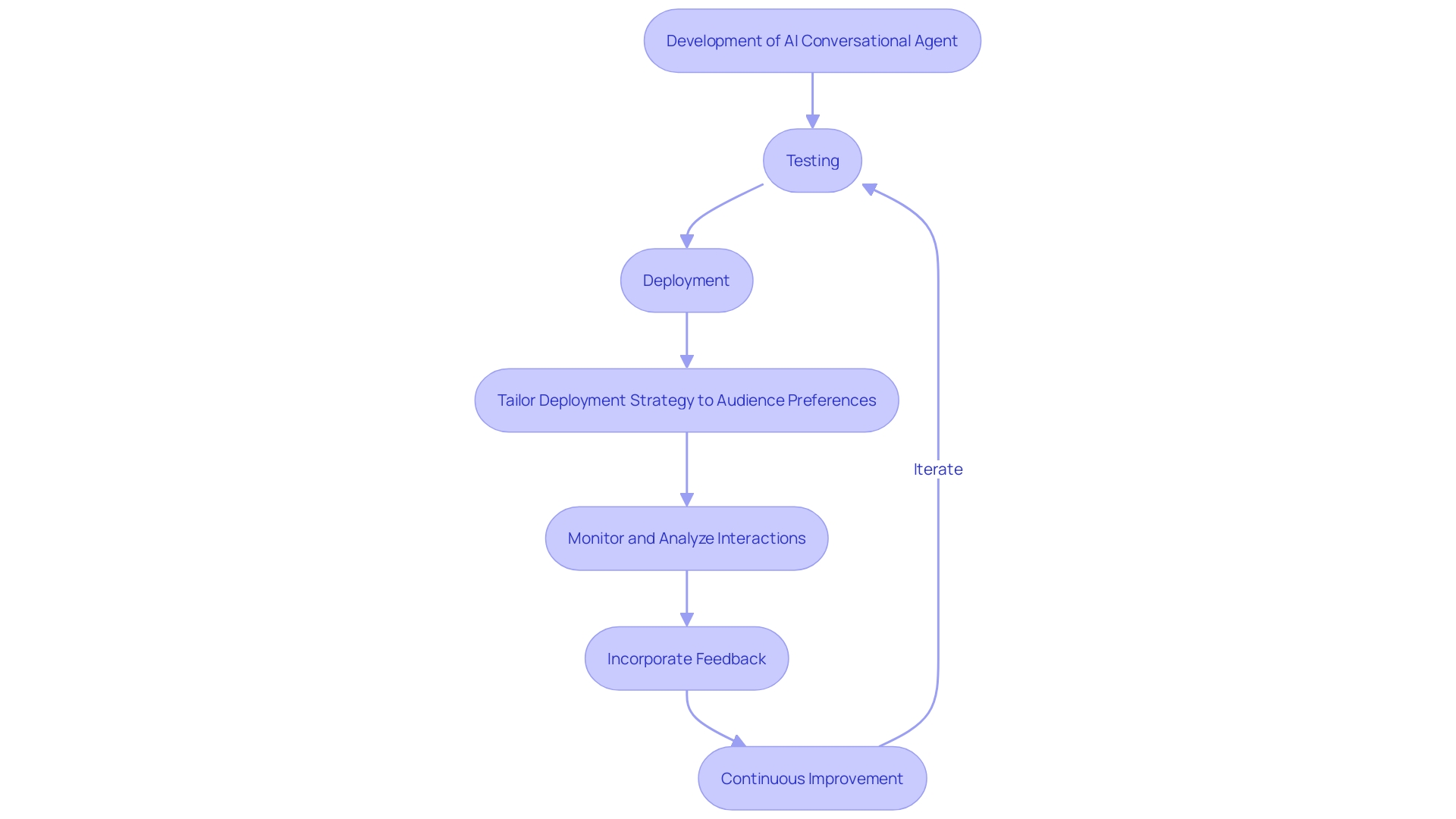
Best Practices for AI Chatbot Development
Developing an AI conversational agent that differentiates itself necessitates not just following established guidelines but also adopting a pioneering strategy for interaction with individuals. By incorporating analytical tools, developers can uncover invaluable insights into individual actions, resulting in a more intuitive and engaging interface. Continuous performance monitoring and iterative improvements are crucial in refining the chatbot’s functionality and ensuring it meets the users’ needs effectively. For example, by implementing the knowledge gained from the Benefit project, an energy company with a large collection of documents, AI virtual assistants can greatly decrease the amount of time employees need to search for company-related information, reducing it from an average of 18 minutes to just a few seconds. Furthermore, the incorporation of technologies like blockchain can offer a pristine, unchangeable data source for virtual assistants, improving their capability to offer precise and multilingual replies. With a strategic approach that combines these elements, developers can deliver AI chatbots that not only enhance user interaction but also contribute to a tangible return on investment.
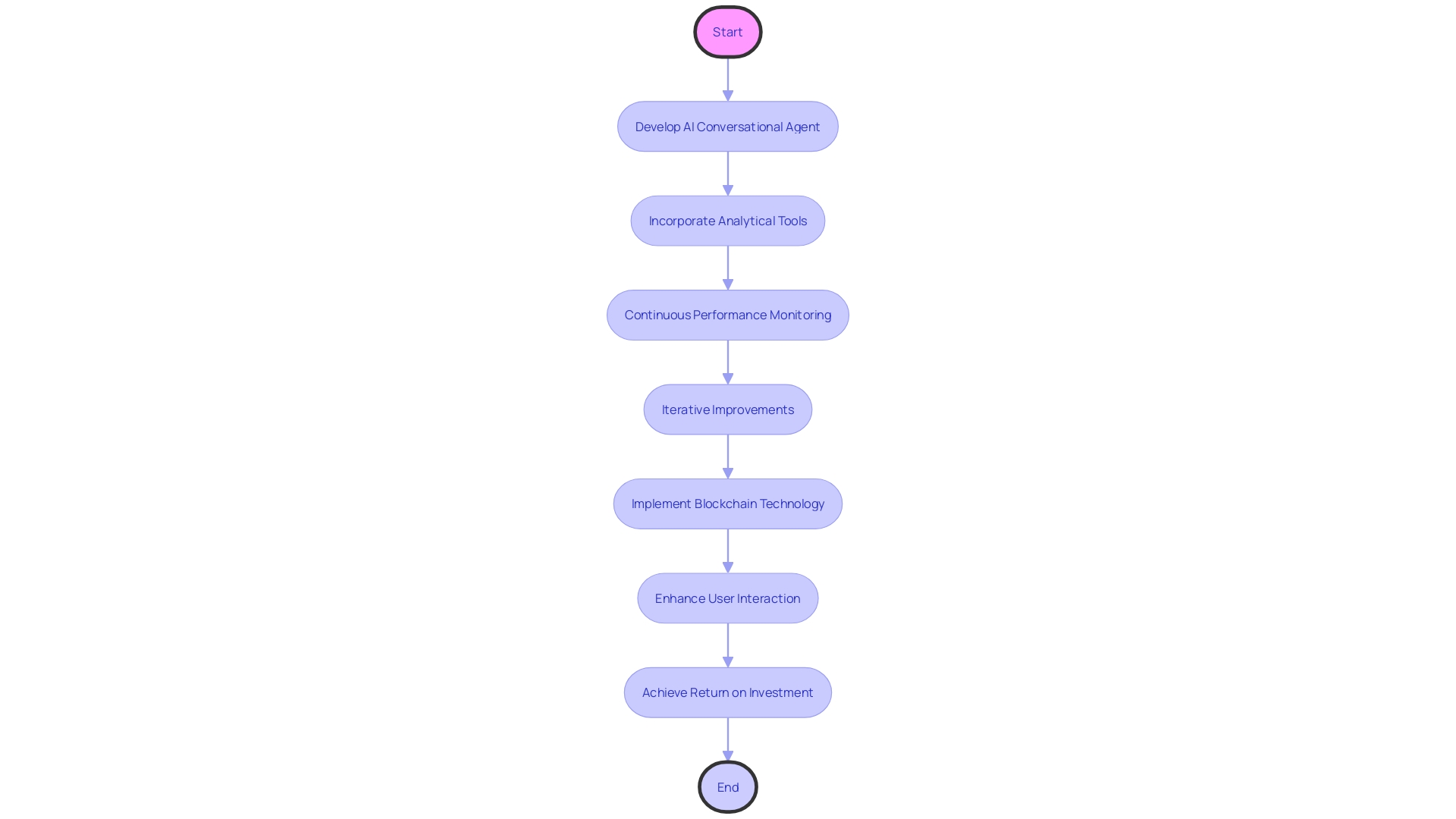
Advanced Techniques in AI Chatbot Development
Advancements in artificial intelligence technology are revolutionizing the way businesses engage with their customers. Sentiment analysis and context-awareness are two cutting-edge techniques that can significantly enhance a chatbot’s capabilities. Sentiment analysis enables automated conversational agents to detect and react to user emotions, fostering a more personalized and empathetic user experience. Context-awareness, conversely, enables AI assistants to preserve information from previous interactions, resulting in a more coherent and efficient conversation flow.
For instance, the Enefit energy company, employing over 5,000 people across five markets, utilized AI technology to streamline access to thousands of internal documents. By reducing the average time needed to find answers from 18 minutes to a matter of seconds, they demonstrated the profound impact of integrating AI into operational processes.
Current market trends reveal a surge in AI adoption, with the AI-powered personal assistants market projected to reach $242.30 billion by 2030. This growth is propelled by Ai’s potential to automate up to 70% of customer requests, and with over 63% of retail companies using AI to enhance customer service, the emphasis on Ai’s role in operational efficiency is clear.
As we delve into neural networks, a core component of AI’s ability to learn and process complex patterns, it’s crucial to understand their structure and application. Neural networks, akin to the human brain, consist of layers of artificial neurons that adapt through backpropagation—a learning mechanism adjusting connection weights from training errors. They excel at tasks such as image and speech recognition, as well as natural language processing, which are crucial for advanced conversational agents.
The integration of AI in customer service not only aligns with strategic product development but also promises significant returns on investment (ROI). As businesses and researchers continue to explore the potential of AI, the focus on specialized agents and domain-specific applications is leading to more effective, privacy-conscious, and user-centric AI solutions.
Common Challenges and Solutions in AI Chatbot Development
Strategically implementing AI chatbots requires a deep understanding of the challenges and opportunities they present. For example, uncertainty in input from individuals, complicated dialogues, and the requirement for strong privacy and security measures are common obstacles. Addressing these necessitates a fusion of sophisticated methods like intention identification, which aids in distinguishing intentions, and slot completion, which captures crucial information during interactions. Moreover, dialogue management strategies can help in orchestrating the conversation flow effectively.
From real-world applications, such as Enefit’s AI system aimed at streamlining employee access to internal documents, we learn that the average time to find company-related answers was significantly reduced. Such examples underscore the importance of AI in operational efficiency. Also, insights from the NHS’s adoption of digital technologies illustrate the necessity for a thorough assessment of AI tools to ensure they meet security and compliance standards.
The potential of AI is further emphasized by the integration of Large Language Models (LLMs) and blockchain technology, ensuring clean, confidential data that can be multilingual. Companies like Exfluency are at the forefront, offering hybrid intelligence solutions that valorize linguistic assets.
When considering AI integration, it’s crucial to inquire how it will generate ROI, fit into the long-term product strategy, and what maintenance processes are necessary. Additionally, the AI should be aligned with addressing important problems for users and enhancing the customer journey. An AI solution should only be pursued if it is the most effective option available.
Supporting this with statistics, AI has automated up to 70% of customer requests, with over 63% of retail companies using AI to enhance customer service. Furthermore, the rise in generative AI applications in customer service strategies is a testament to the technology’s value, considering the high abandonment rates due to poor service experiences. Lastly, chatbots serve as an initial step in lead qualification, with research showing their widespread use on websites for contact collection and user support.
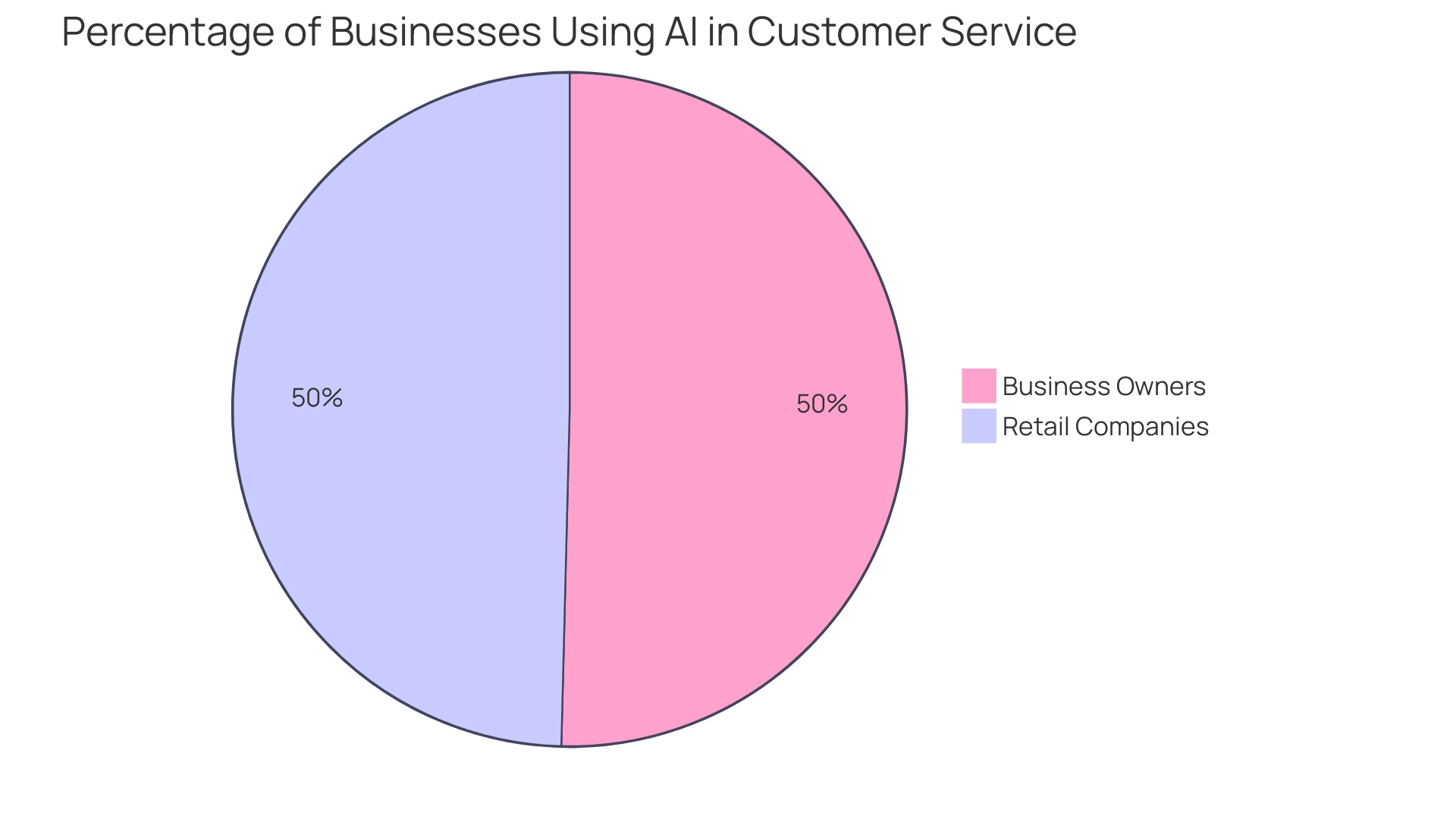
Conclusion
In conclusion, AI chatbots have become essential tools for enhancing user interaction in various industries. Understanding the different types of chatbots, such as rule-based systems and machine learning-driven ones, is crucial for planning a chatbot strategy.
Implementing AI chatbots can lead to impressive returns on investment, automating up to 70% of customer requests and improving operational efficiency. They can act as sophisticated assistants, driving long-term product strategies and operational goals.
By following best practices and leveraging advanced techniques like sentiment analysis and context-awareness, businesses can create AI chatbots that enhance user interaction and provide a personalized experience.
Overcoming common challenges in AI chatbot development, such as ambiguity in user input and privacy concerns, can be achieved through intent recognition, slot filling, and effective dialogue management strategies.
Choosing the right development platform and conducting quality testing are crucial for successful deployment and ongoing maintenance of AI chatbots. Continuous monitoring and refinement ensure alignment with evolving user needs and technological advancements.
In summary, AI chatbots offer practical solutions to enhance user interaction and improve operational efficiency. By harnessing the power of AI, businesses can create chatbots that deliver a positive user experience and drive meaningful results.
Introduction
Robotic Process Automation (RPA) offers businesses the transformative power of automation and the ability to streamline processes. However, choosing the right RPA tool and understanding its fundamentals are crucial for successful implementation. In addition, learning RPA development basics and exploring advanced techniques can unlock the full potential of automation.
RPA implementation strategies and testing and deployment best practices are also essential for seamless integration. Furthermore, staying updated with RPA certifications and training programs is key to staying ahead in this rapidly evolving field. Finally, exploring future trends in RPA, such as the integration of AI and machine learning, can amplify the capabilities of RPA tools.
By delving into these topics, professionals can harness the power of RPA to drive operational excellence and efficiency in their organizations.
Choosing the Right RPA Tool
Selecting the ideal Robotic Process Automation (RPA) tool is a critical step in harnessing the transformative power of robotic processes. When evaluating RPA solutions, it’s vital to assess their usability, scalability, and ability to integrate with existing systems. Community support also plays a key role, offering insights and resources for smoother implementation. Tailoring your choice to your organization’s unique needs ensures that your RPA tool not only meets current objectives but also supports future growth. As automation continues to evolve, remember that it’s a partnership between technology and human oversight. Ensuring ongoing monitoring, management, and upgrades is essential for maintaining efficiency and productivity. With this collaborative approach, RPA can effectively handle routine tasks, freeing up human talent for more complex and creative work, ultimately leading to increased operational excellence.
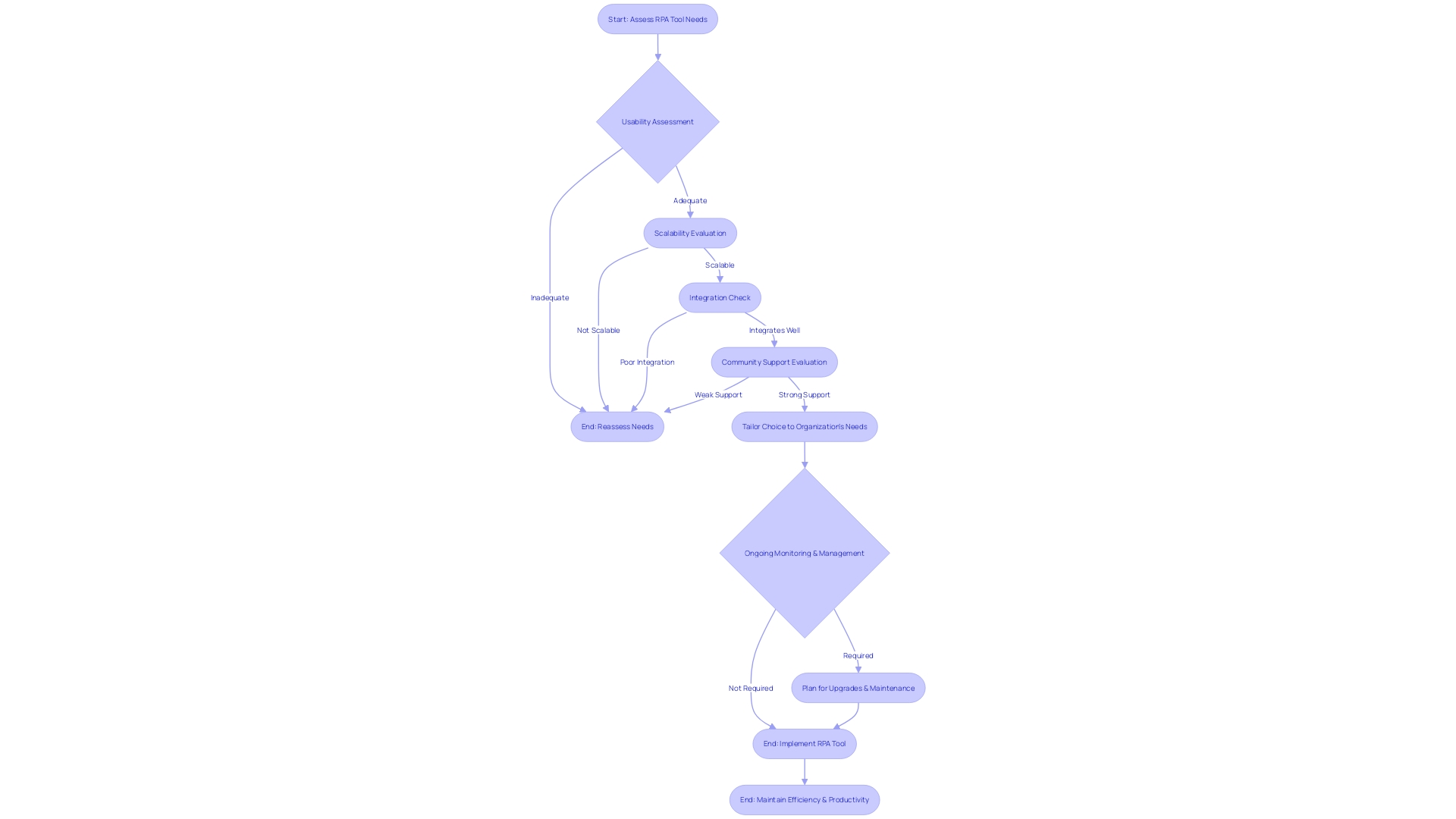
Understanding RPA Fundamentals
To effectively develop RPA solutions, a thorough comprehension of RPA fundamentals is essential. RPA, or Robotic Process Automation, represents a technological leap where software robots, known as ‘bots’, emulate human tasks in a digital environment. These bots are adept at conducting repetitive, rule-based activities such as data entry, data extraction, and document processing. Attended and unattended RPA are the two primary types, each with distinct operational frameworks and applications. Attended RPA works alongside human input, while unattended RPA operates independently.
The transformative power of RPA lies in its ability to connect disparate systems, automating workflows and tasks across various applications, thus liberating human workers from monotonous duties. As Bosch harnesses digital engineering to enhance green energy efficiency, it exemplifies the broader operational benefits of RPA. By incorporating RPA, organizations can achieve a more efficient, real-time understanding of processes, enabling improved, faster decision-making.
Data is the linchpin of RPA; sourcing from databases, transaction logs, social platforms, and customer insights. This data must be meticulously cleaned and formatted for analysis. With the right analysis tools, from statistical methods to data mining, RPA can unleash a new realm of efficiency and productivity. As corporations like Microsoft and Google invest in generative AI, RPA stands as a complementary tool that, while may require patience, promises to deliver substantial long-term benefits.
In summary, stepping into RPA development demands a strong grasp of its capabilities and mechanisms. This foundation is not just about understanding the bots but also about grasping the strategic vision of how RPA can transform business intelligence, much like it has begun to revolutionize aspects of green energy and operational visibility.
Learning RPA Development Basics
Embarking on the path to becoming proficient in RPA development requires an initial step of grasping the fundamental principles. One should begin by learning the common programming languages pivotal for RPA, such as Python and C#. Exploring the development environment of your chosen RPA tool is essential, along with becoming proficient in creating and setting up workflows. It’s important to also understand essential programming constructs like variables, loops, conditions, and how to manage exceptions.
Businesses across industries have recognized the undeniable benefits of RPA in streamlining processes. Take for example Enefit, a major energy company which, after conducting a survey, found that their employees spent an average of 18 minutes to locate answers within internal documents. This scenario underscores the necessity for automation in handling vast amounts of data and improving operational efficiency.
Furthermore, adopting RPA is not only about the use of tools but also about the importance it adds to human interactions within an organization. The tacit knowledge that employees share is invaluable, and RPA can help preserve and disseminate this knowledge more effectively. As highlighted by John Naughton in The Guardian, the secret to successful implementation lies in the collective know-how of the people involved.
The Global State of Business Analysis Report, which surveyed over 4,400 professionals, further illuminates the impact of such technologies. It shows how analysis is evolving and highlights the importance of adapting to new tools like RPA. This is echoed in the industry’s shift towards a more data-driven approach, as detailed in IIBA’s report on Achieving More with Data.
In essence, establishing a strong groundwork in RPA fundamentals is not only about technical skills, but also about comprehending how these skills can transform processes and enhance collaboration within an organization. As RPA continues to evolve, professionals who are well-versed in both the technological and human aspects of the field will be best positioned for success.
Advanced RPA Techniques
When diving into the deep end of Robotic Process Automation (RPA), it becomes crucial to leverage the full spectrum of its capabilities to stay at the forefront of technological innovation. Advanced RPA features such as image and text recognition, web scraping, and seamless integration with external systems and APIs are crucial in developing sophisticated solutions that can handle complex business logic, error handling, and exception management efficiently. Consider the scenario of Lindy’s AI assistant, which necessitated the integration of a vast network of apps and services to execute tasks adeptly across various domains such as medical scribing and customer support. This challenge was akin to orchestrating a symphony of AI-powered employees, requiring meticulous research and development to avoid prolonging their market entry.
In a landscape where open-source software has become integral to cutting-edge technology, employing robotic programming is tantamount to instructing a robot’s brain, which is connected to sensors and actuators, to perform complex tasks. This underscores the importance of continuous monitoring, management, and upgrades even in the era of AI, where the human partnership is indispensable for ensuring stability. At Coding Crafts, a pioneer in custom software development, this philosophy extends to integrating innovative services like Blockchain Development, adding layers of security and transparency to technology initiatives.
As we navigate this future with cutting-edge mechanization, it is clear from the insights of industry leaders that RPA and Intelligent Automation (IA) are rapidly transforming the technological landscape. The commitment to innovation is manifest in the adoption of AI across various industries, from customer service chatbots to predictive analytics in healthcare. Nevertheless, it is important to mention that only a portion of enterprises are utilizing Ai’s complete potential in goods production and service delivery. According to a study conducted by Statistics Canada, only 6.1% of enterprises utilized AI in the creation of products, emphasizing a notable chance for improvement and enhancement in effectiveness through advanced techniques of mechanization.
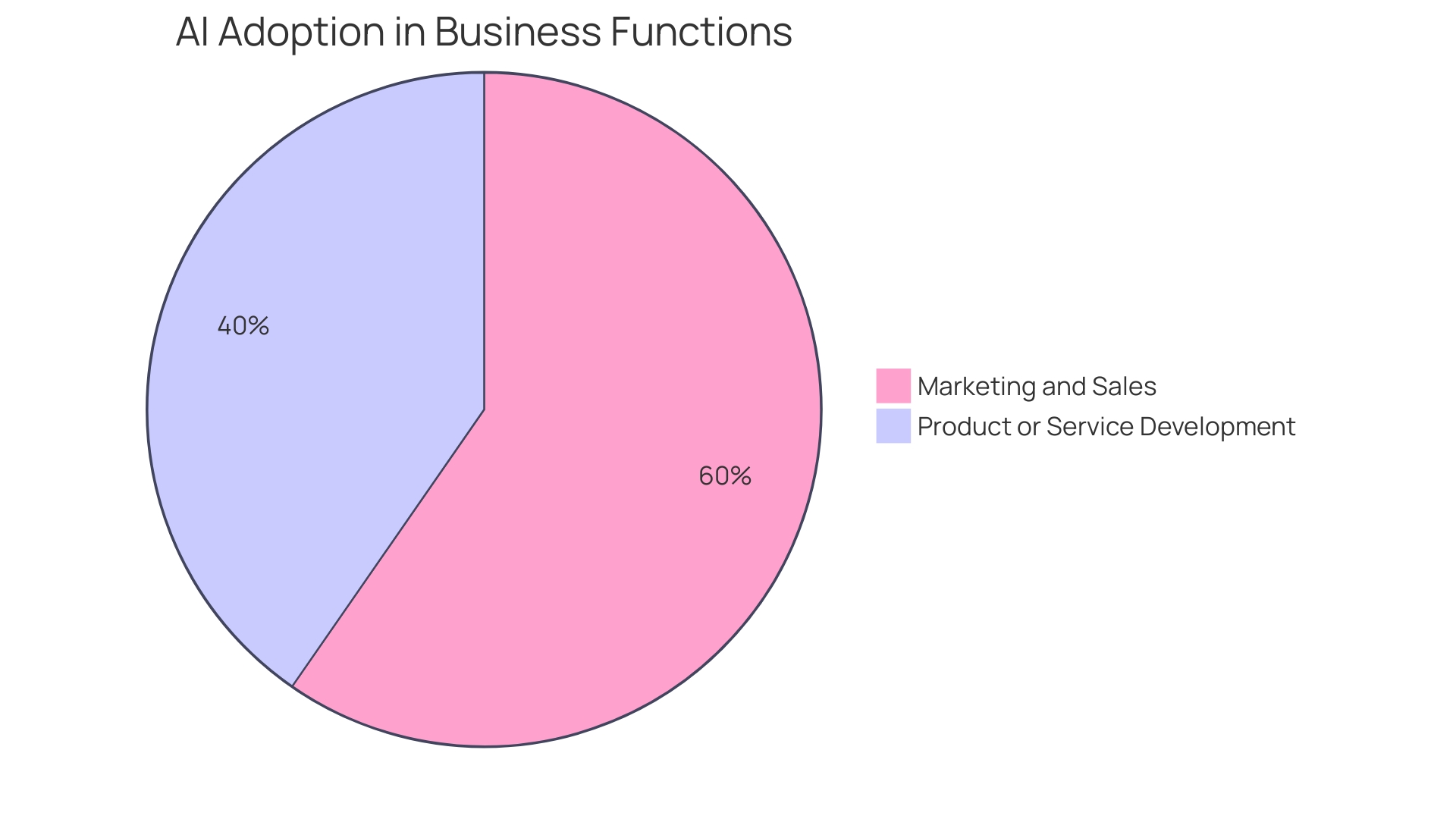
RPA Implementation Strategies
Embarking on the journey of Robotic Process Automation (RPA) involves more than just coding—it demands a comprehensive grasp of best practices and strategic implementation within an organization. Delving into the merits of both top-down and bottom-up methodologies, we uncover the inherent challenges and pivotal considerations of each. This exploration includes strategies to identify and prioritize processes ready for streamlining, creating a persuasive business case for RPA, and securing stakeholder endorsement.
An example of this is the NHS’s Digital Service Team, which meticulously assesses new digital adoption requests for security and compliance, avoiding redundancies by ensuring the requested solution isn’t already in use. Similarly, Medien Hub Bremen-Nordwest’s collaboration with Mediensystempartner (MSP) exemplifies the search for the ideal AI platform, culminating in the successful deployment of Parloa with SC Soft, which dramatically improved customer service efficiency.
Reflecting on the retail sector, the innovative Zippin-powered checkout-free store in Dublin Airport demonstrates the practical application of RPA in streamlining customer transactions. In the domain of global regulations, recent academic research highlights the need for human supervision in facial identification systems, emphasizing the significance of ethical deliberations in mechanization.
To ensure successful enterprise application testing, open-source tools offer valuable resources. Workflow streamlining stands as a testament to the power of technology in simplifying complex business processes, as evidenced by a Zapier report highlighting its widespread utility in small businesses.
According to industry experts, the process of using machines has always required human interaction for monitoring, management, and upgrades. This synergy between humans and AI is crucial for maintaining stability and achieving efficiency and productivity gains.
When identifying opportunities for streamlining processes, focus on manual, repetitive, and resource-intensive tasks. Start with small, targeted projects and evaluate their complexity and potential return on investment (ROI). Common starting points include automating identity verification and simple order inquiries, as these often present quick wins with low complexity.

Testing and Deployment
Robotic Process Automation (RPA) has transformed the way enterprises engage with data and processes, providing a mechanism to automate routine tasks and improve operational efficiency. It’s essential to recognize that the journey of RPA deployment doesn’t end with development; rigorous testing and strategic deployment are pivotal for its success. RPA testing follows a structured path, starting with unit testing, where individual components of the process are tested for functionality. Integration testing follows, ensuring that various components work together seamlessly. The last step is user acceptance testing, where end-users verify that the system aligns with business requirements and performs as expected.
To exemplify, consider the case of Enefit, a leading energy company in the Baltics. They faced a significant challenge with their vast repository of internal documents. Employees spent, on average, 18 minutes to locate answers within these documents, with 10% taking over an hour. Implementing RPA in such scenarios not only streamlines information retrieval but also necessitates meticulous testing to ensure such solutions function accurately and efficiently.
When deploying RPA solutions, best practices include maintaining version control to manage different iterations of the automation, change management to ensure smooth transitions, and thorough documentation for clarity and future reference. As noted by Dr. Evan Shellshear, an AI expert, the integration of RPA within existing systems can present complexities, especially with legacy systems. Hence, it’s crucial that the deployment process is managed with a keen eye on how these automated solutions coexist with and enhance current infrastructures.
With RPA becoming increasingly prevalent in various sectors, including security and defense, the call for responsible and controlled use of autonomous systems becomes louder. As we observe global conversations regarding the ethical and legal consequences of AI, such as the promotion of a binding instrument on autonomous weapons systems, it serves as a reminder of the profound influence that advanced tools have on our lives and the significance of implementing them responsibly. For RPA solutions, this translates to ensuring that they are not only efficient but also aligned with ethical standards and contribute positively to operational workflows.

RPA Certifications and Training
Staying abreast of the latest advancements in RPA is pivotal for professionals seeking to solidify their position in the industry. Certifications and training programs serve as a testament to one’s dedication and proficiency in this rapidly evolving domain. Selecting programs recognized by esteemed organizations ensures that the knowledge gained is both relevant and respected. Such credentials not only reflect an individual’s command over RPA tools and technologies but also their ability to adapt to emerging trends and methodologies. With industries progressively shifting towards mechanization for operational effectiveness, a qualified expert stands at the forefront, prepared to execute creative resolutions and propel enterprise knowledge to new levels.
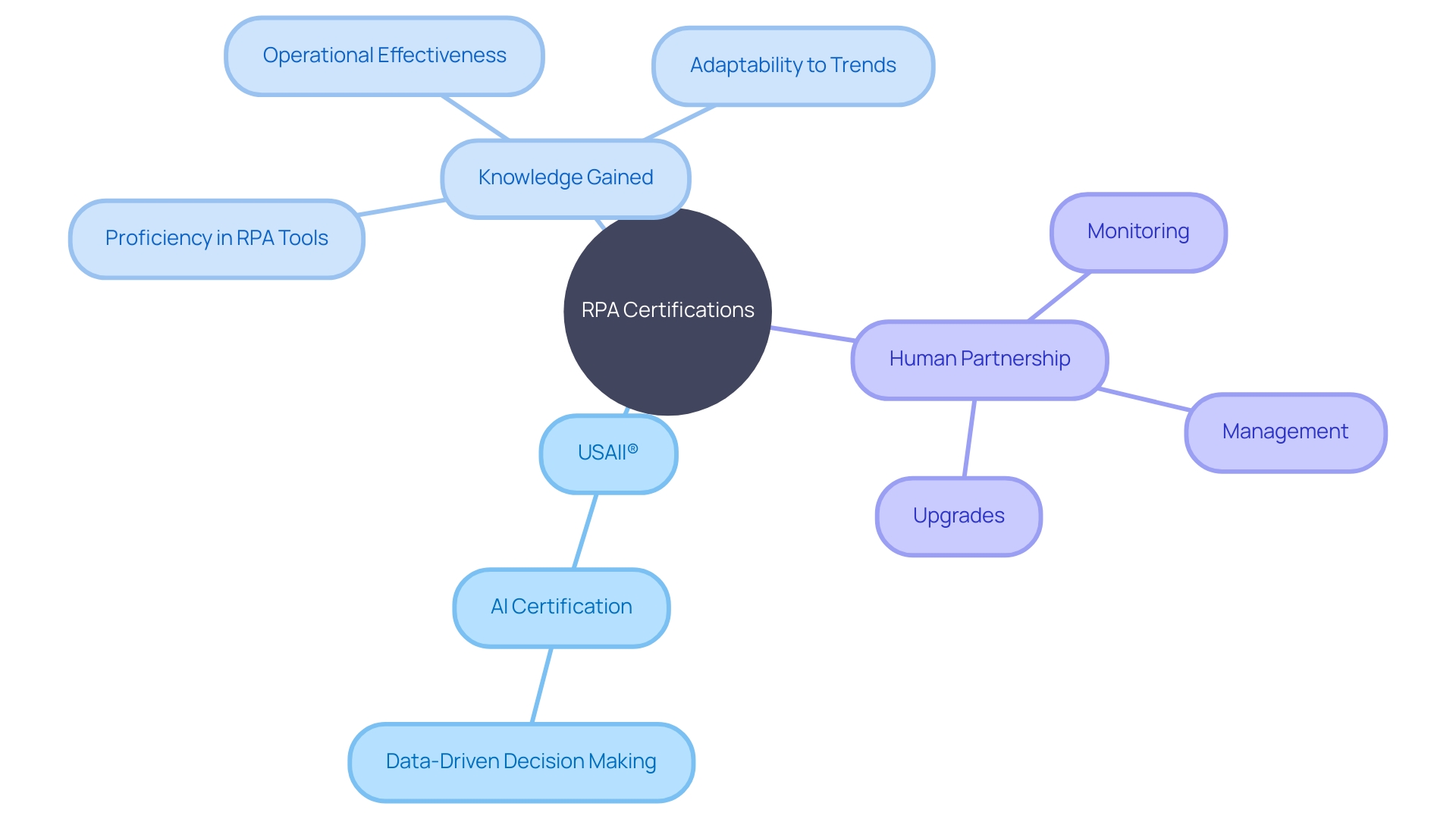
Best Practices for RPA Development
Robotic Process Automation (RPA) signifies a substantial leap forward in business process optimization, echoing the long history of mechanization in driving efficiency and productivity. As developers, embracing RPA requires a deep understanding of its nuances to construct solutions that are not only efficient but also robust and adaptable. To succeed in RPA development, it’s crucial to embrace coding standards customized for RPA, promoting uniformity and excellence in your scripts.
Emphasizing a modular design enables the creation of reusable components, leading to more streamlined and maintainable workflows. Moreover, this approach is instrumental in addressing complex tasks by breaking them down into manageable segments. It mirrors the findings at Benefit, a leading energy company, where the vast array of internal documents made information retrieval time-consuming. Just as modular document management could streamline their processes, so can modular RPA design enhance operational efficiency.
Integration of error handling and comprehensive logging is not just a best practice; it’s essential for pinpointing issues swiftly, thereby reducing downtime. These mechanisms are crucial in situations like within the NHS, where the implementation of digital solutions must be secure, compliant, and efficient. A robust RPA framework ensures that any issues can be quickly identified and rectified, maintaining the integrity and continuity of critical healthcare operations.
The importance of version control cannot be overstated in managing the evolution of RPA scripts. It’s a tool that safeguards against errors and facilitates collaboration, ensuring a stable and progressive development environment. As the CTO and Co-Founder of Reveille Software points out, the journey of automation has always required monitoring, management, and upgrades. RPA development is no different in this regard; it’s an ongoing process of refinement and enhancement.
By incorporating these best practices into your RPA development routine, you not only enhance the quality of your solutions but also position yourself at the forefront of this transformative field. The result is a powerful alignment of human ingenuity and digital precision that propels businesses toward the future of operational excellence.
Future Trends in RPA
To thrive in the ever-changing realm of RPA, one must explore the interplay between RPA and state-of-the-art advancements such as AI and machine learning. These advancements can significantly amplify the capabilities of RPA tools. For instance, incorporating natural language processing enables chatbots to deliver precise and contextual responses, enhancing user interactions. Similarly, AI algorithms can be utilized to craft personalized recommendations by analyzing user data, which becomes more accurate as the machine learning model learns over time.
Integrating such advancements can simplify intricate tasks, as observed in the healthcare industry where digital service teams evaluate if new innovations align with compliance and already established solutions. This proactive approach is crucial in ensuring the secure and proper use of the tools. Moreover, AI-driven solutions, such as AI chatbots, are instrumental in addressing staff shortages and improving patient care by providing continuous communication channels.
These advancements are not without challenges, as highlighted by the ongoing debates around ethics and regulations in AI, particularly in the context of autonomous weapons systems. The consensus among experts suggests that human oversight is imperative in an area where life and death decisions are at stake.
In summary, staying informed about the latest advancements and understanding their potential applications is crucial. By exploring emerging technologies and their practical use cases—from simple order inquiries to complex regulatory compliance checks—one can ensure they remain a valuable asset in the evolving RPA landscape.
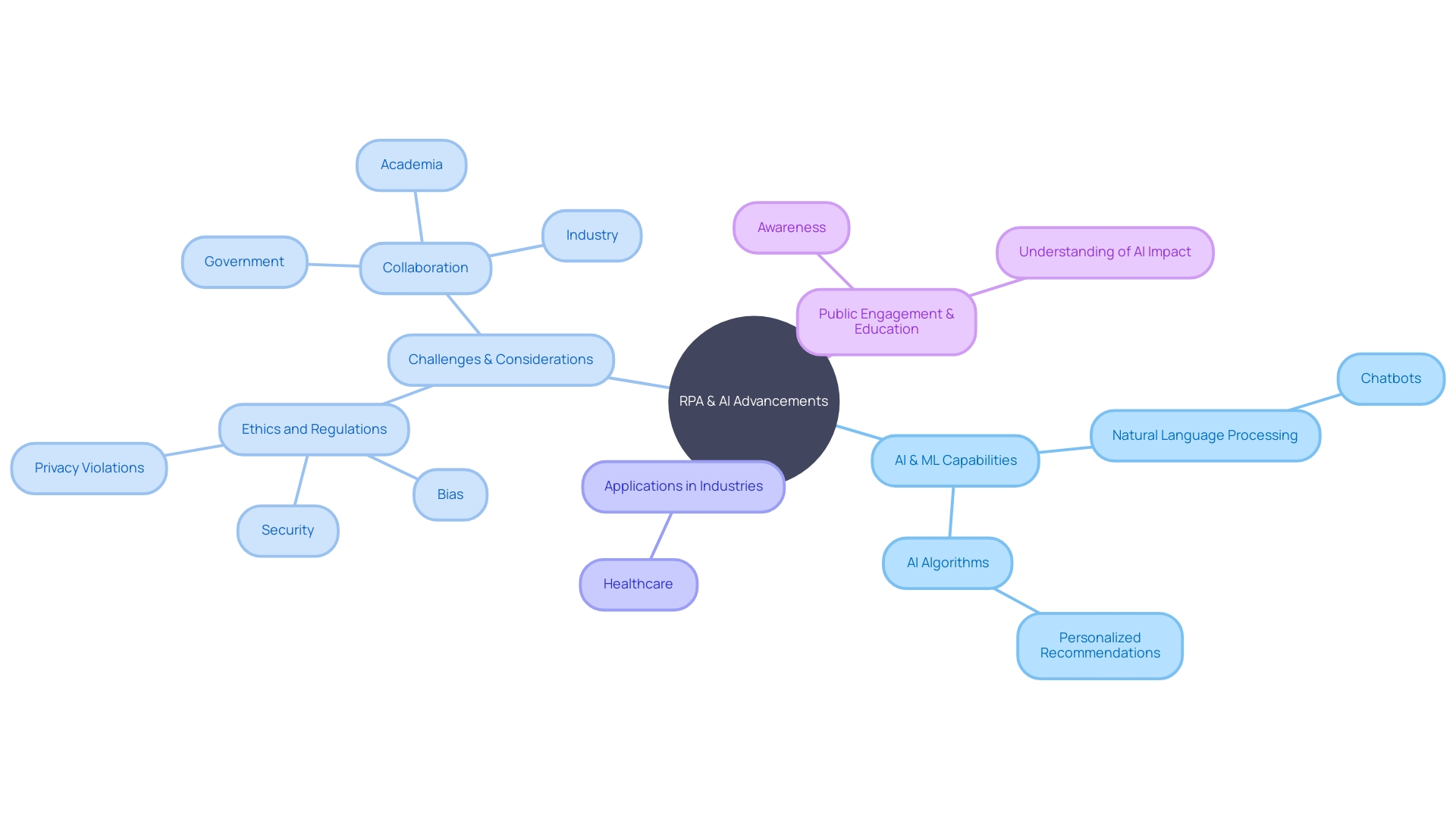
Conclusion
In conclusion, successful implementation of Robotic Process Automation (RPA) requires choosing the right tool, understanding its fundamentals, and exploring advanced techniques. Professionals should also stay updated with certifications and training programs to stay ahead in this rapidly evolving field.
Choosing the right RPA tool involves assessing usability, scalability, and integration capabilities. Understanding RPA fundamentals and its ability to connect systems is crucial for streamlining processes and improving efficiency.
To excel in RPA development, professionals must grasp programming languages and essential constructs. Staying updated with certifications and training programs is vital.
Exploring advanced RPA techniques, such as image and text recognition, enables the creation of sophisticated automation solutions. Human oversight and continuous monitoring are essential for stability and efficiency.
Successful implementation strategies involve identifying automation opportunities, crafting compelling business cases, and securing stakeholder endorsement. Rigorous testing and strategic deployment ensure accurate and efficient automation.
Staying updated with certifications and training programs is crucial for professionals. Adopting coding standards, emphasizing modular design, and integrating error handling enhance the quality of RPA solutions.
The integration of AI and machine learning amplifies RPA’s capabilities, enabling chatbots with natural language processing and personalized recommendations. Ethical considerations and human oversight remain important.
In conclusion, by choosing the right tool, understanding fundamentals, exploring advanced techniques, and staying updated with certifications, professionals can harness the power of RPA for operational excellence and efficiency. The synergy between human ingenuity and digital precision propels businesses toward the future of RPA and transformative technological innovation.
Become an expert in RPA development today!
